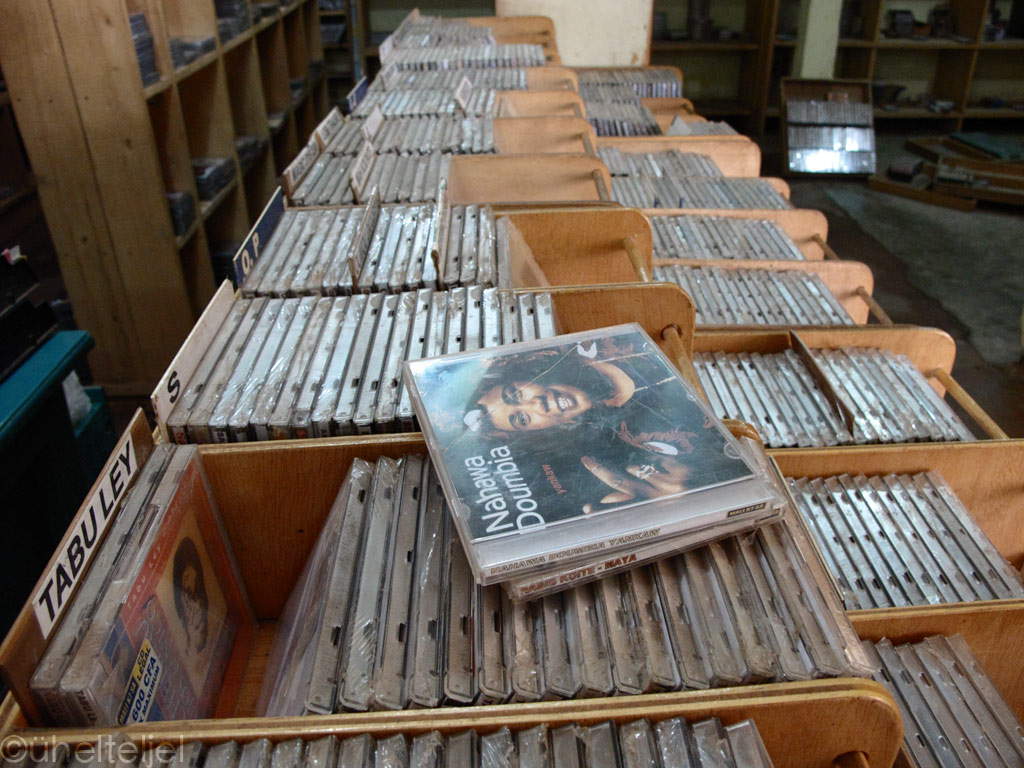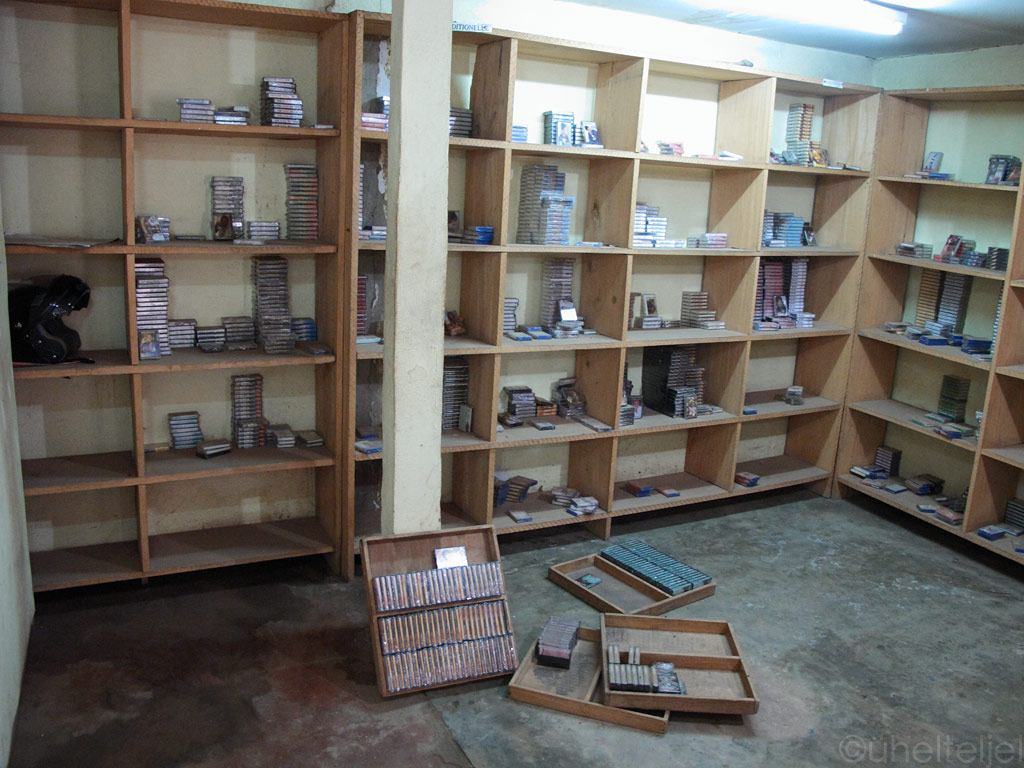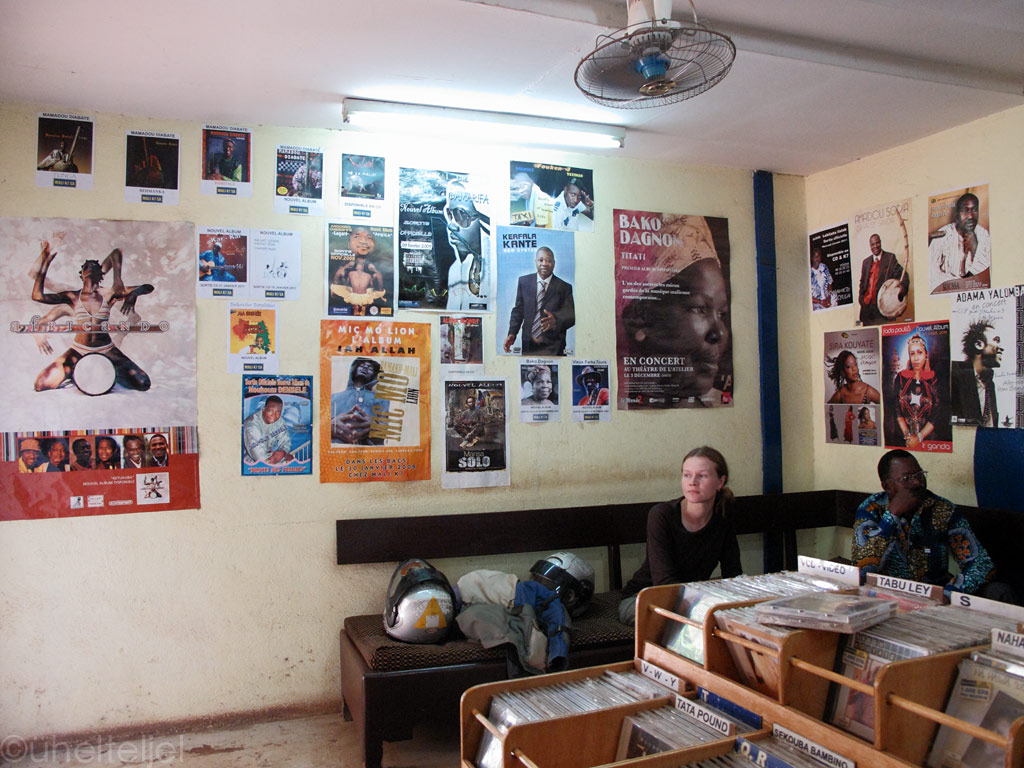Formerly called the Upper Volta, today's Burkina Faso made a positive impression on us, so that after the past few weeks of speeding we decided to slow down a little and take it all in.
Already the bordercrossing was so fast and efficient that we immediately liked the contry. Not that we'd really had problems with border crossings in the rest of Africa (except for the DRC, of course), but it very often takes quite a lot of time for them to copy all the details from our passports an bike documents to their annals. Here, on the opposite, it was five minutes and we were free to hit the road.
In fact, the roads in Burkina Faso are in a very condition, probably due to the fact that it is one of the poorest contries in the world and the roads do not get so much beating - most of the transport here happens on donkeys and scooters. Even in Ouagadougou, the capital, it is far from rare to see people going around on dokneys or horses, which actually fit quite well into the oversized village (which is what most of African cities seem to be) setting.
But the poverty is not only evident in the modes of transport that people use, but also in the constant begging for cadeaux, or gifts. There is no doubt that it is tourists that have contributed to the situation where you barely are able to go somewhere without kids approaching you with "Le blanc, donne-moi cinq cent francs!" ("White guy, give me five hundred francs!"), or to take out the camera just to hear "Si tu prends la photo, tu me donnes un cadeau!" ("If you take a photo, you must give me a present!". By the way, those 500 CFA equal no less than one dollar and ten cents. Quite ambitious those people, I must say, and quite annoying too.
Allright, let's get back to that positive impression again. The people are actually fery friendly, if shy, and do noy try to overcharge you any way they can. For example the going rate for a bike wash in Ouagaougou is 500 CFA. The guys spent a whole half an hour massaging our GS, while for the "pressure wash", water had to be carried in buckets into a big barrel from which it was pumped with the help of a generator. Looking at the amount of work it all required we paid a little bit more, and the guys were so abashed they must have been blushing
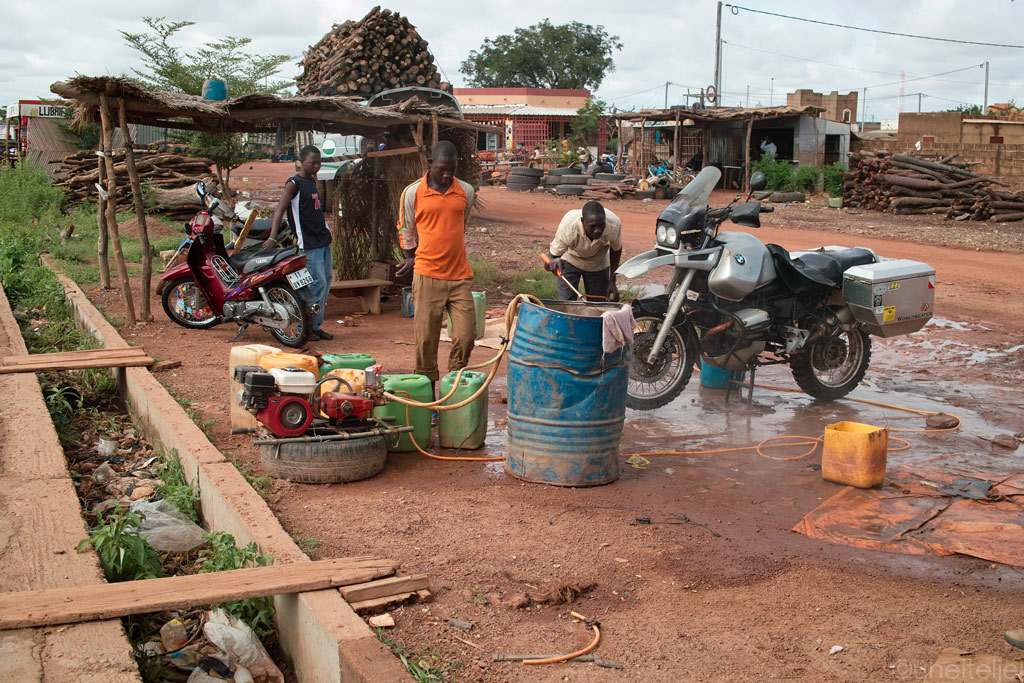
Burkinabe pressure wash. It is interesting that they also like to wash the tyres, although it is almost impossible to leave the place without the tyres becoming just as muddy as they were before.
While in Ouagadougou we applied for the visas for Mali, the next country on our trajectory. The process was fast and painless and cost something like 45 USD per person. Then we moved on, towards the town of Bobo-Dioulasso, seeing on the way what the rainy season really means - there is water everywhere.

A park in Ouagadougou, totally inundated.

But the wet season also means everyhing is green!
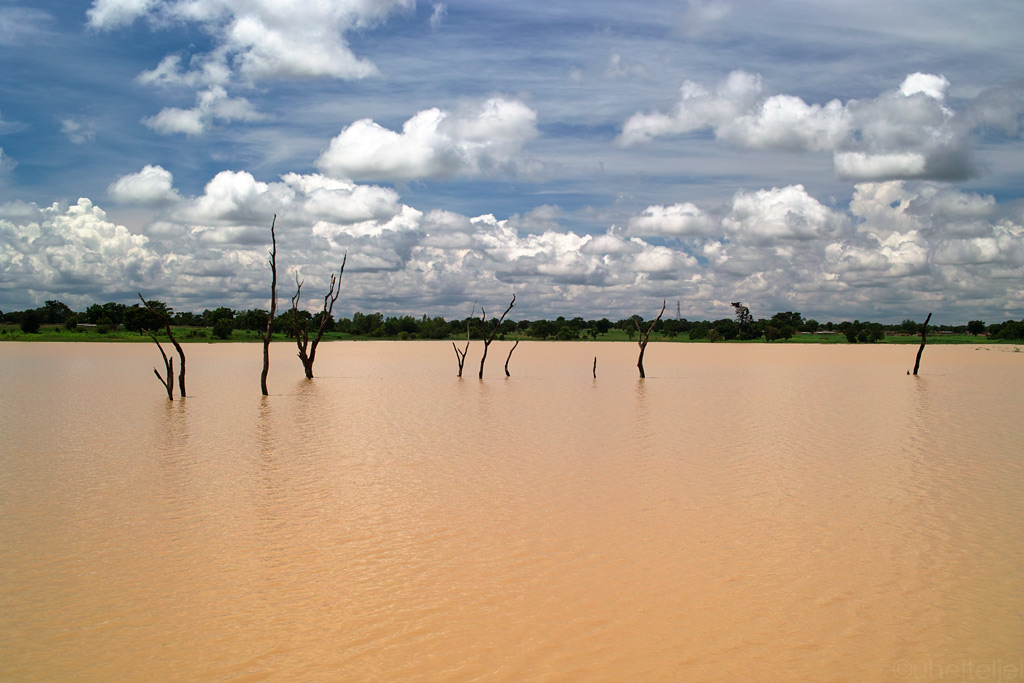
It is wet indeed.
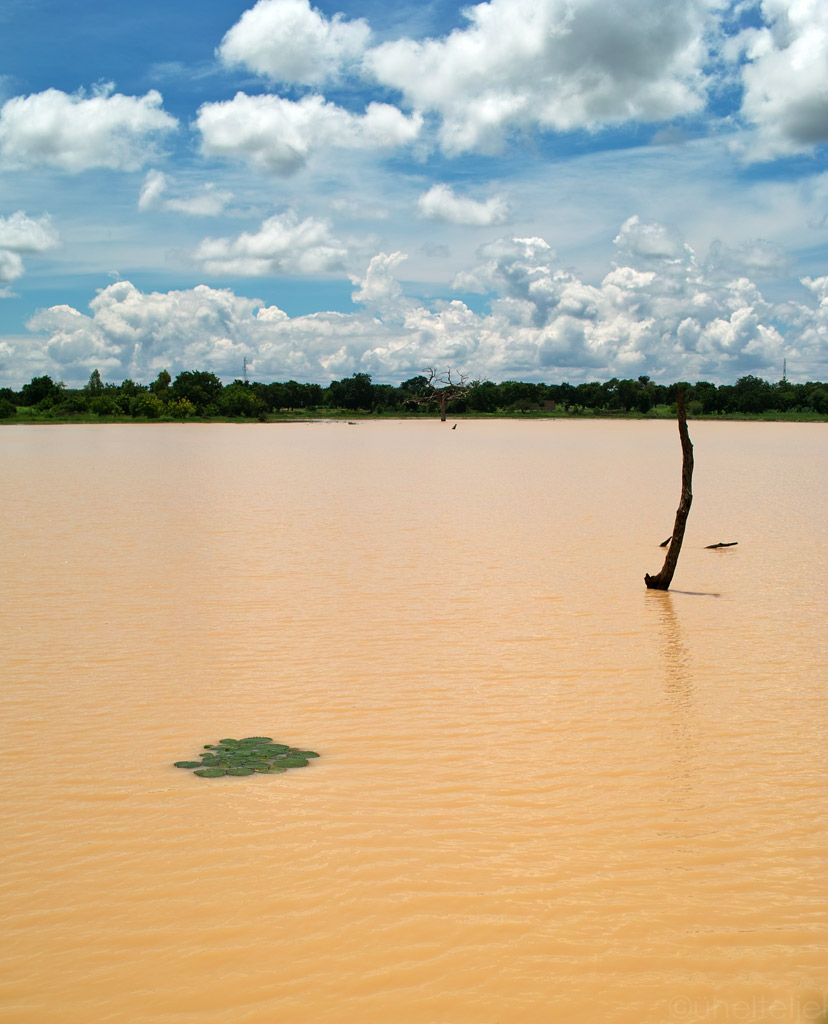
Too much water.
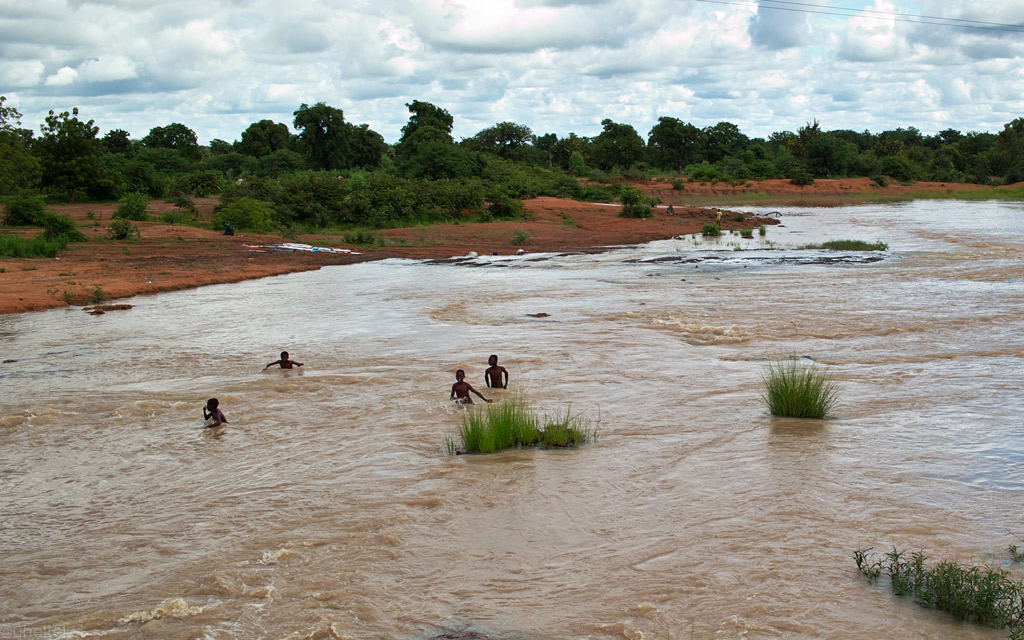
Kids playing with the current - in the dry season it must be no more than a trickle.
But back to Bobo-Dioulasso, the second biggest town in Burkina Faso. Well, it does not feel big at all, rather quite a sedate place, with muddy (in the dry season probably dusty) streets, a bustling market, and the main reason for tourists to come here - mud and stick mosque dating back to the 19th century, a sparkling example of the Sudanese-Sahelian architecture. It is not very big, but the design is like from another world - like from outer space! Those sticks bear multiple functions, one of them being to support ladders used to climb up to repaint the mosque after every rainy season - otherwise it just would not last for so long!
Some spiritual stuff from the local radio to accompany the viewing pleasure:
...::: LISTEN Bobo's local radio playing spiritual African music I :::...
...::: LISTEN Bobo's local radio playing spiritual African music II :::...
...::: LISTEN Bobo's local radio playing spiritual African music III :::...
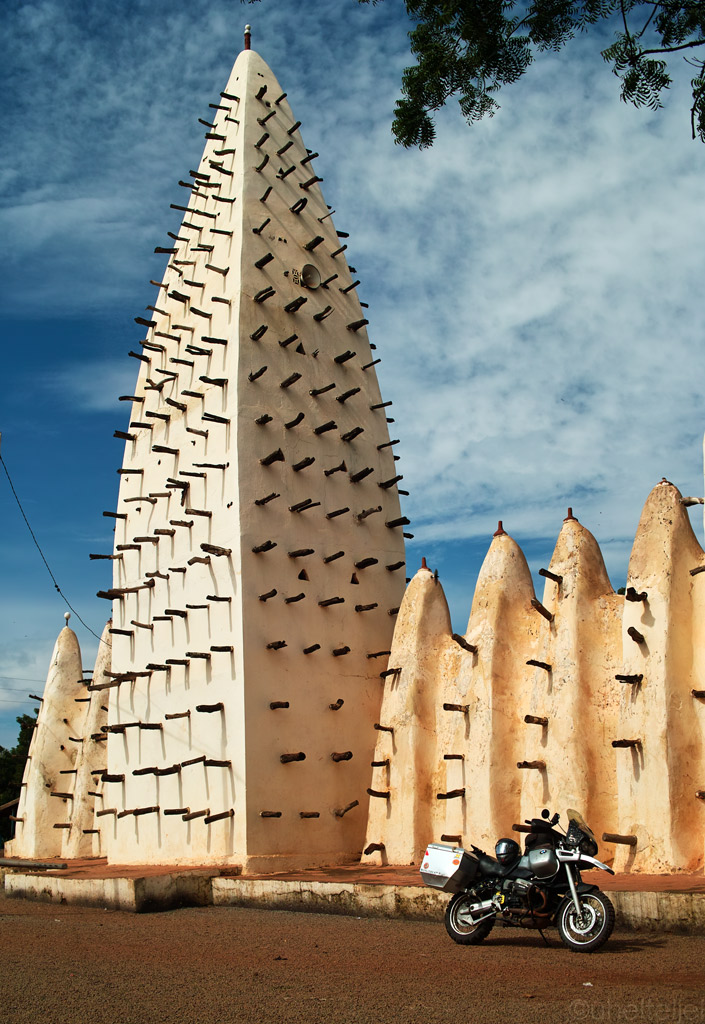
Out of this world!
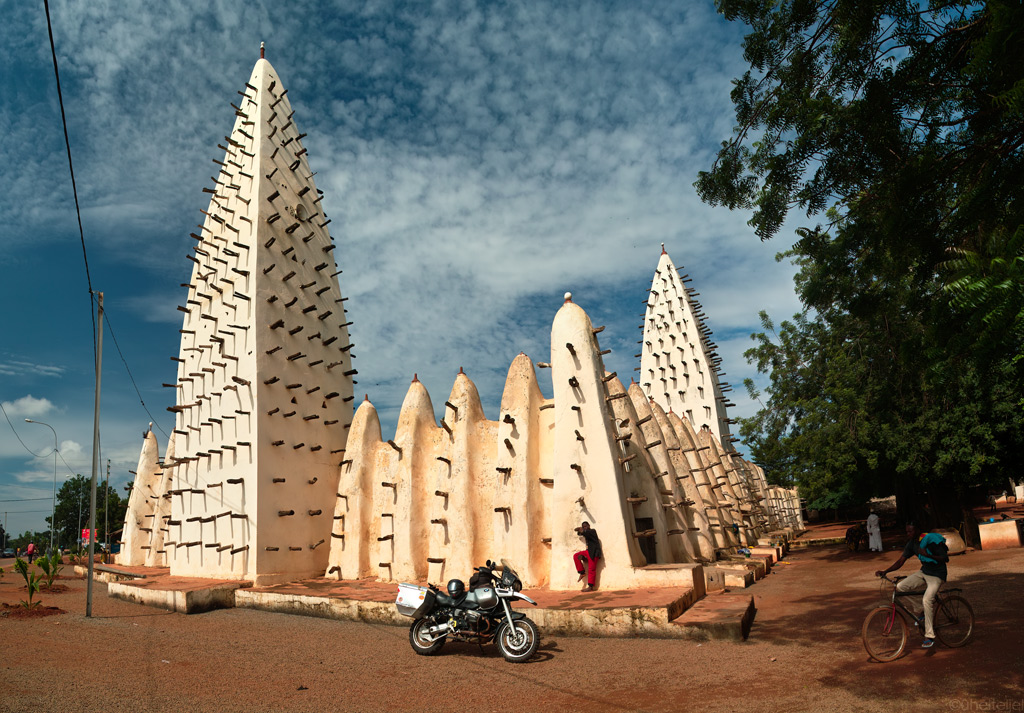
The Grand Mosque of Bobo-Dioulasso.
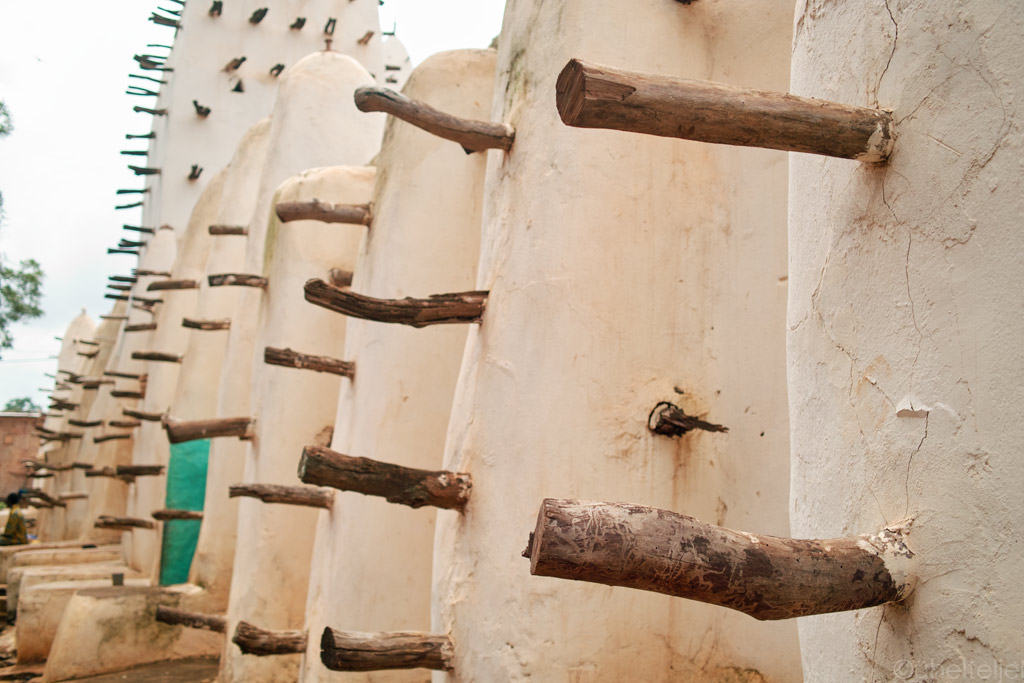
Up close.
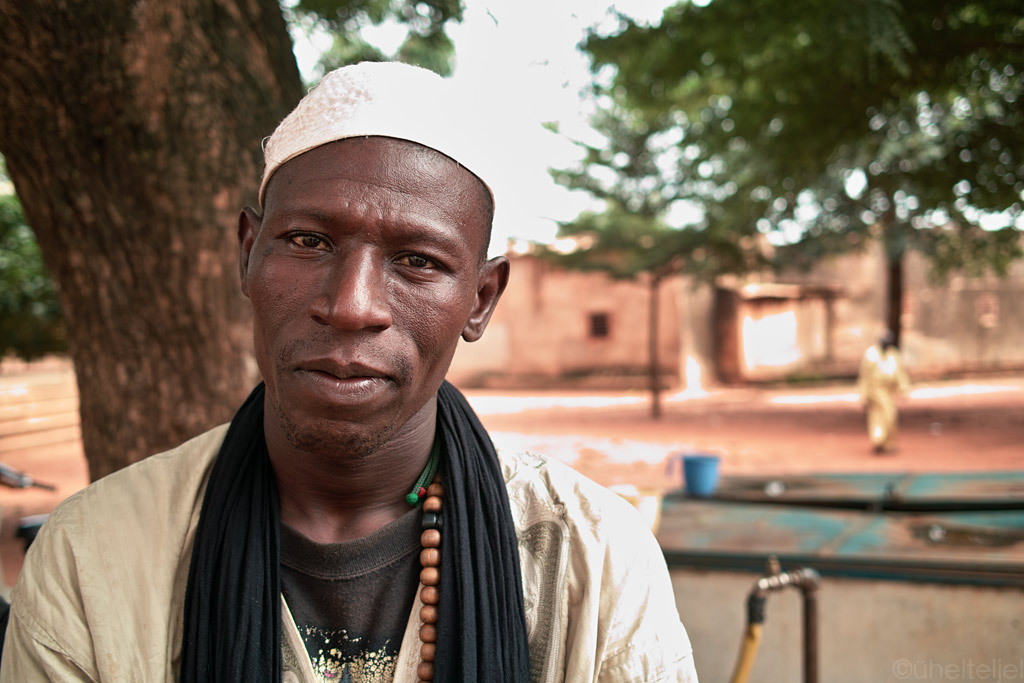
A Muslim man of Bobo.
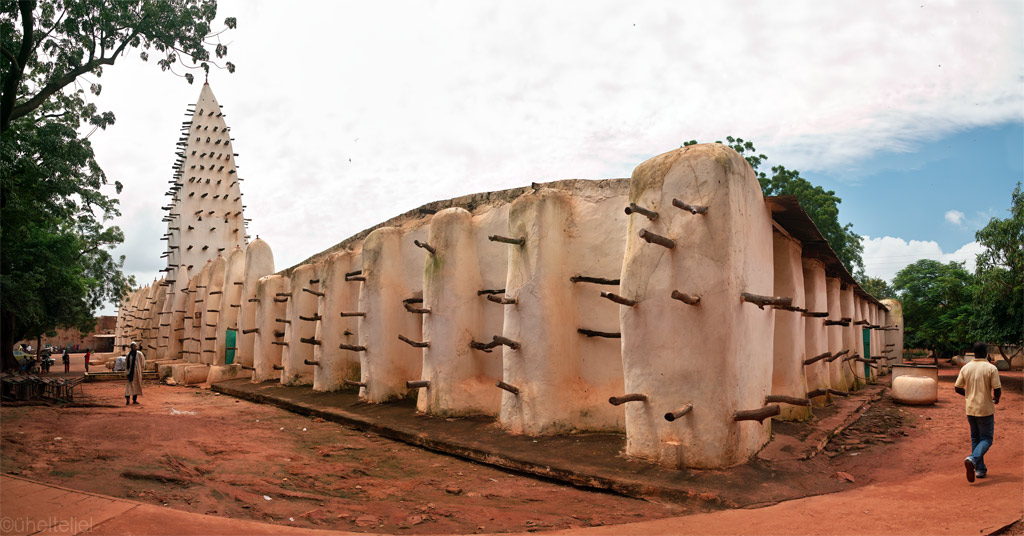
Is it made from marshmallow?
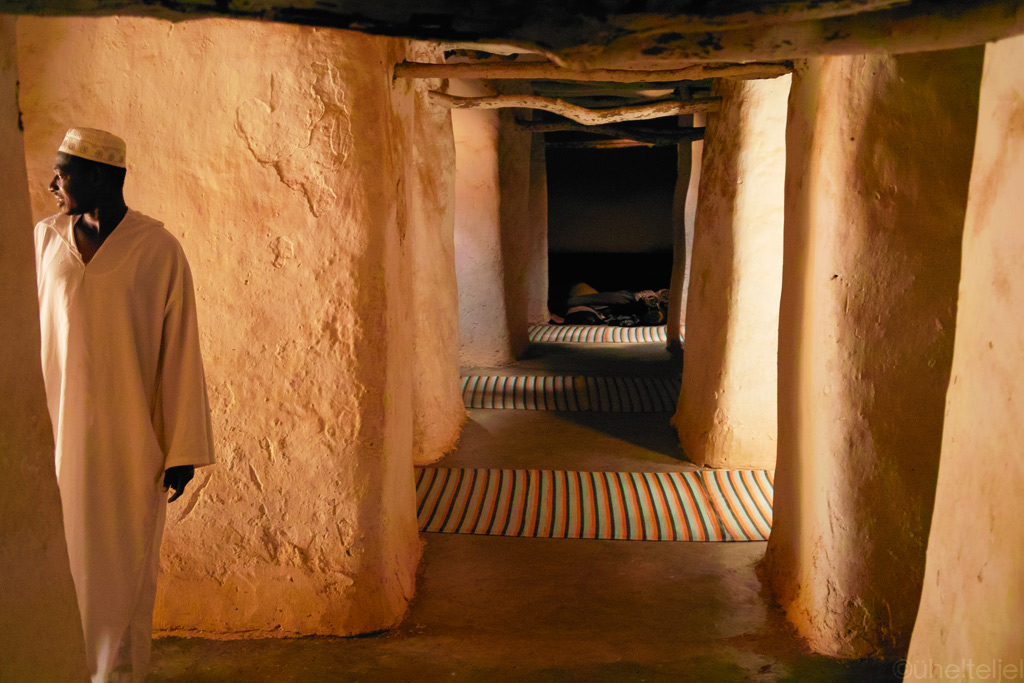
On the inside. More than four hundred devotees fit it here to pray.
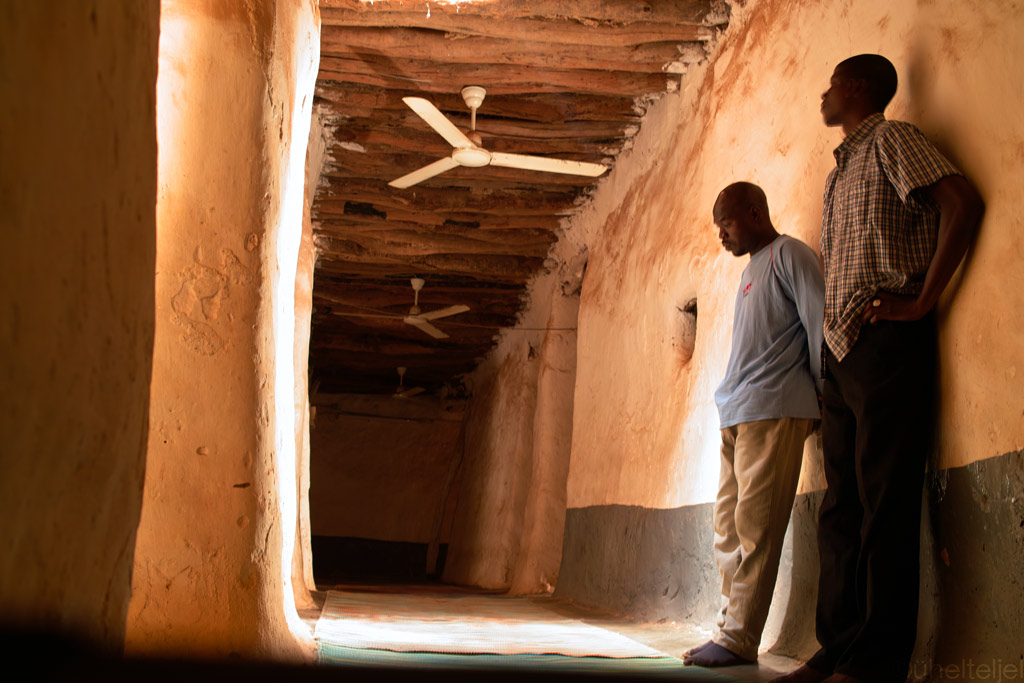
Does not really look too grand from the inside.
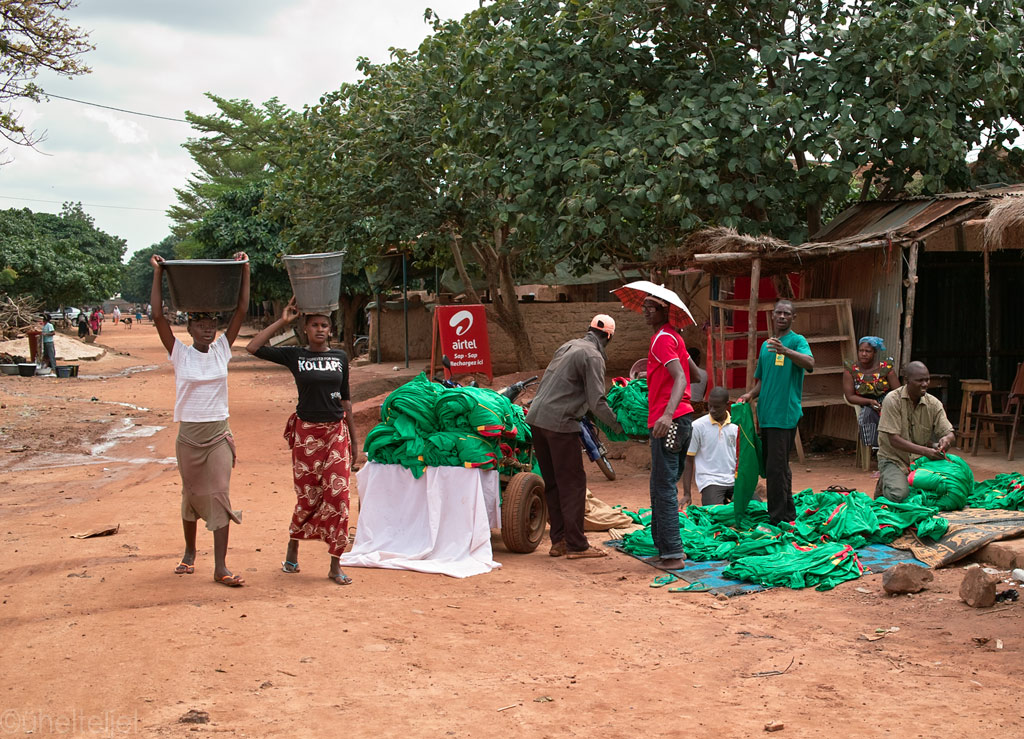
Some humanitarian aid being distributed on the street.
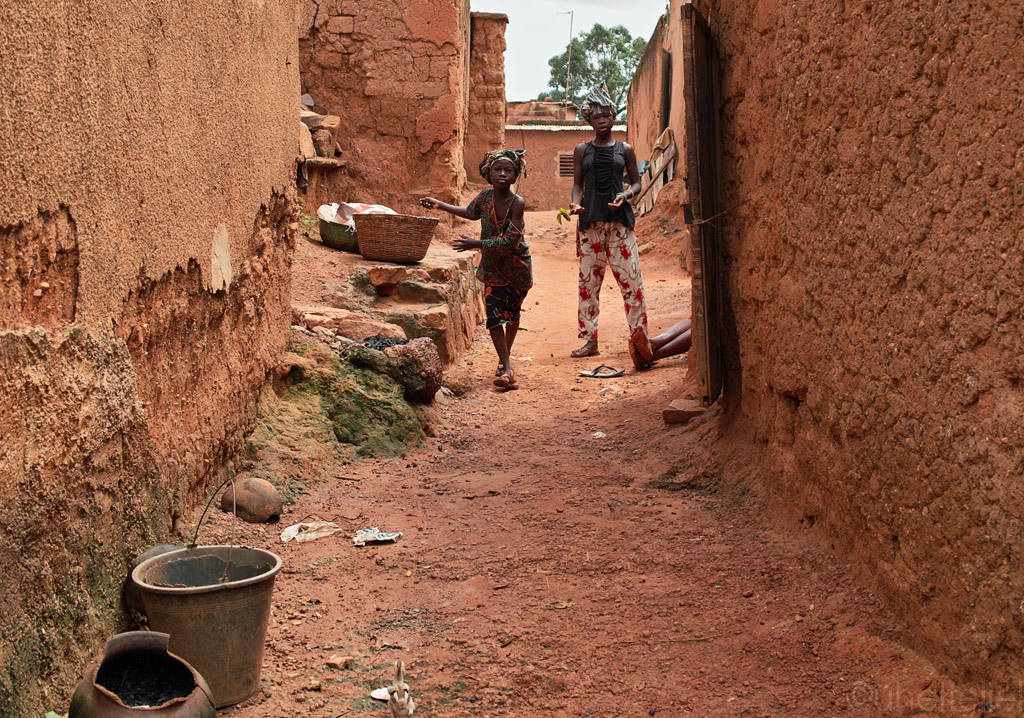
Life on the street - the girls rushed to us in the hope of selling us a handful of dried caterpillars - Bobo's local delicacy.
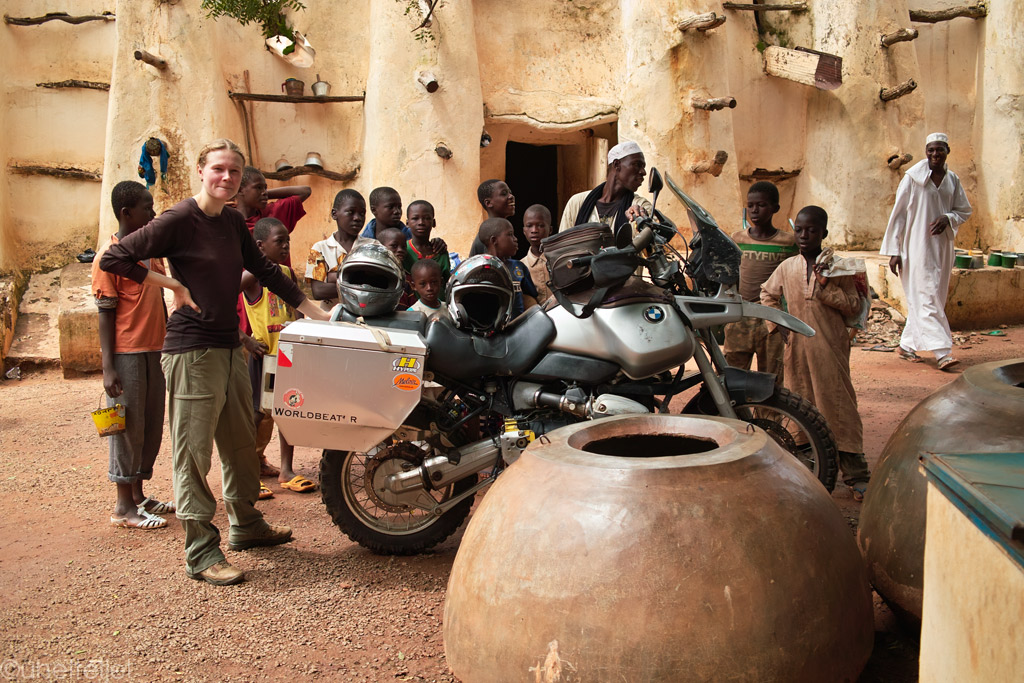
Who said life revolves around a mosque?
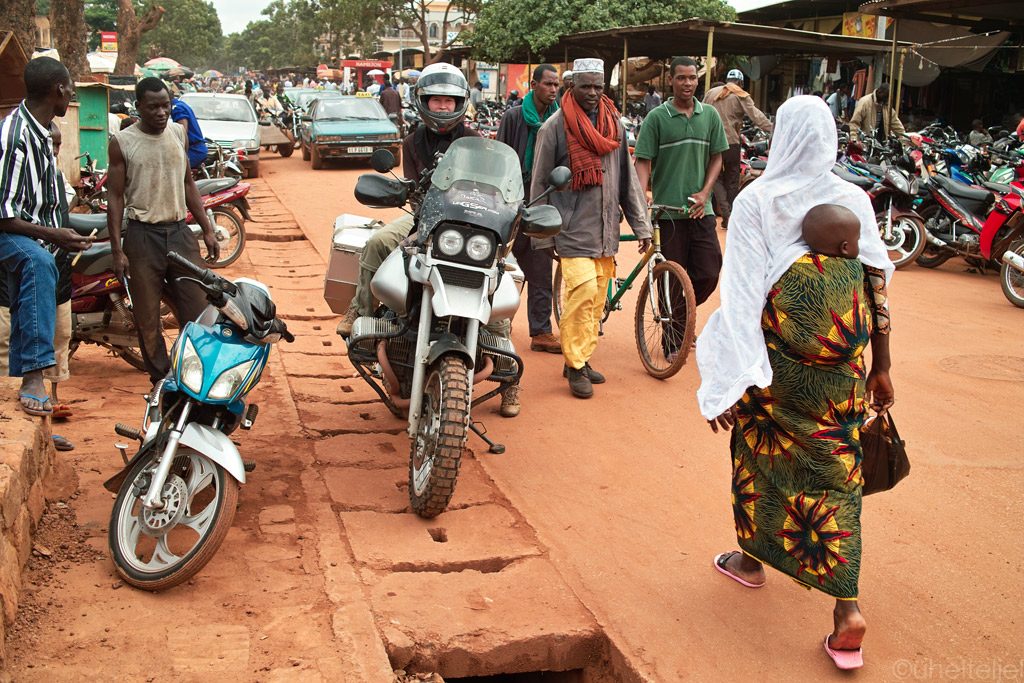
Life around the market.
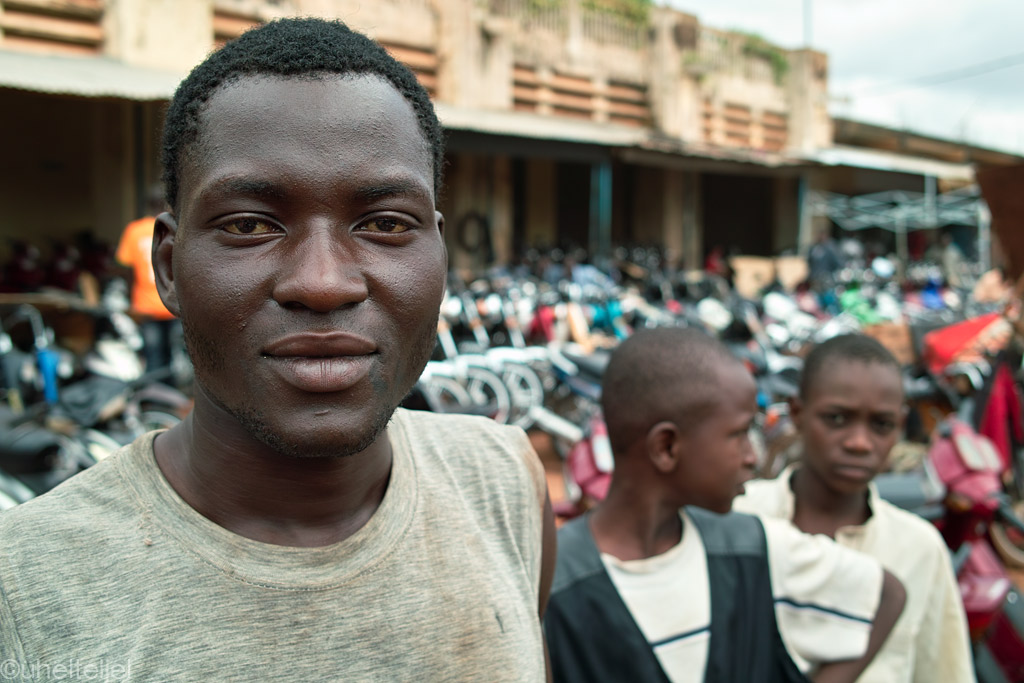
Motorcycle seller.
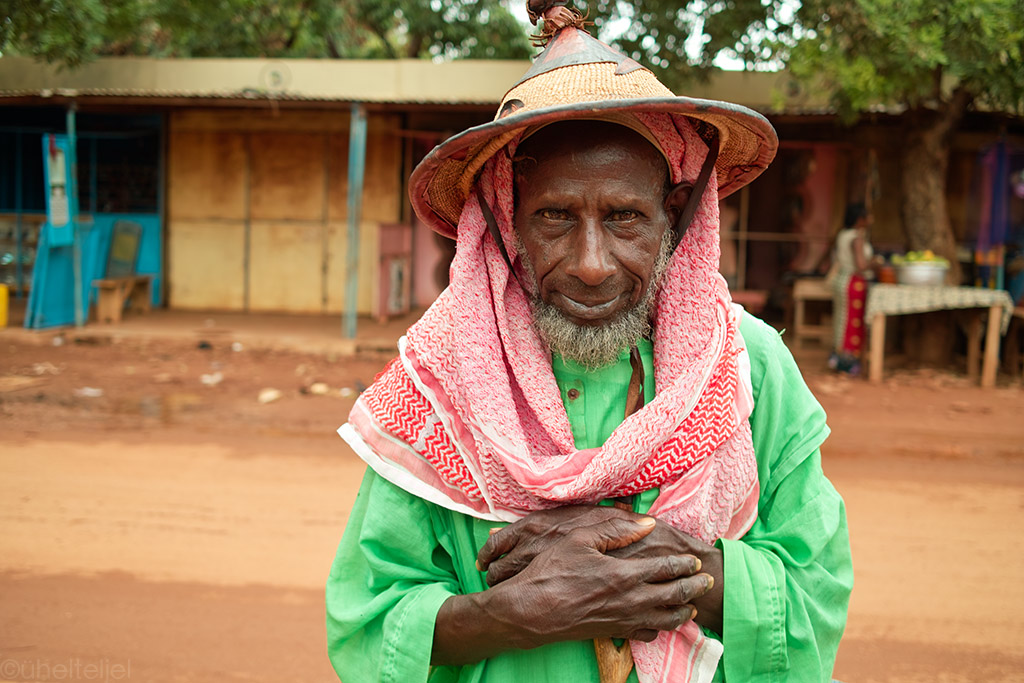
A colourful Bobo lad.
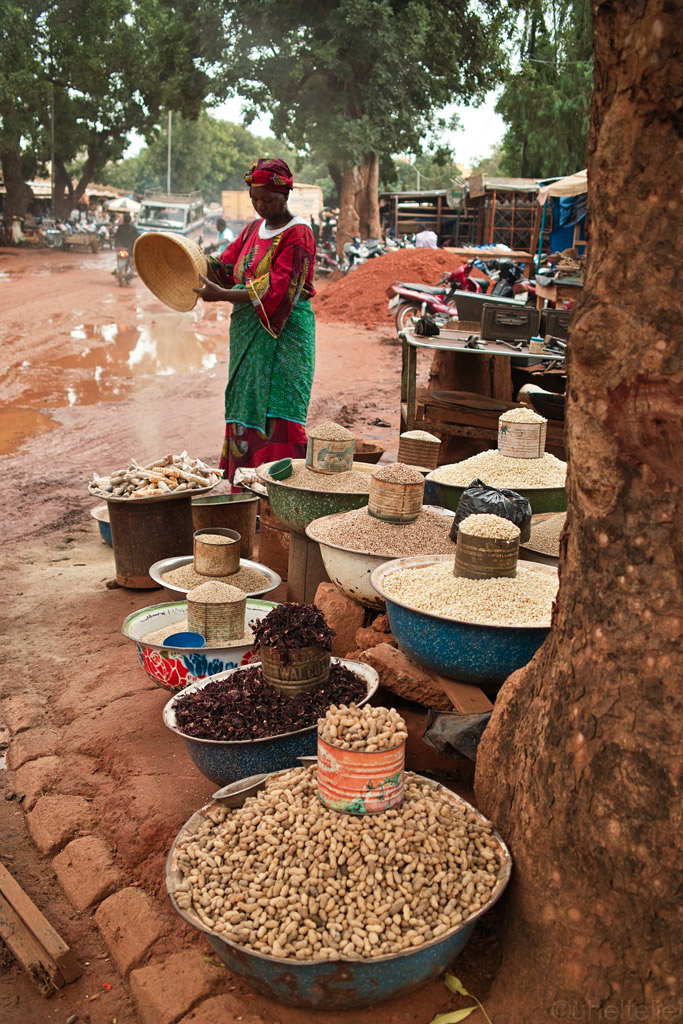
A woman in front of her stall.
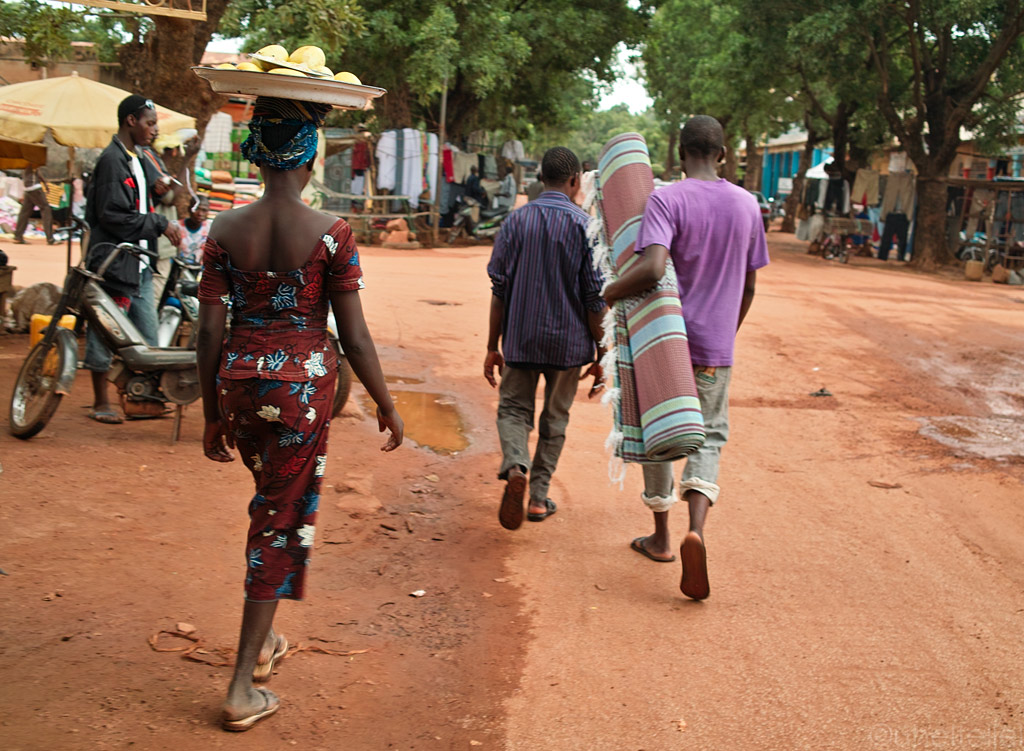
Men rushing to a Friday prayer, woman with her moving stall of mangoes.
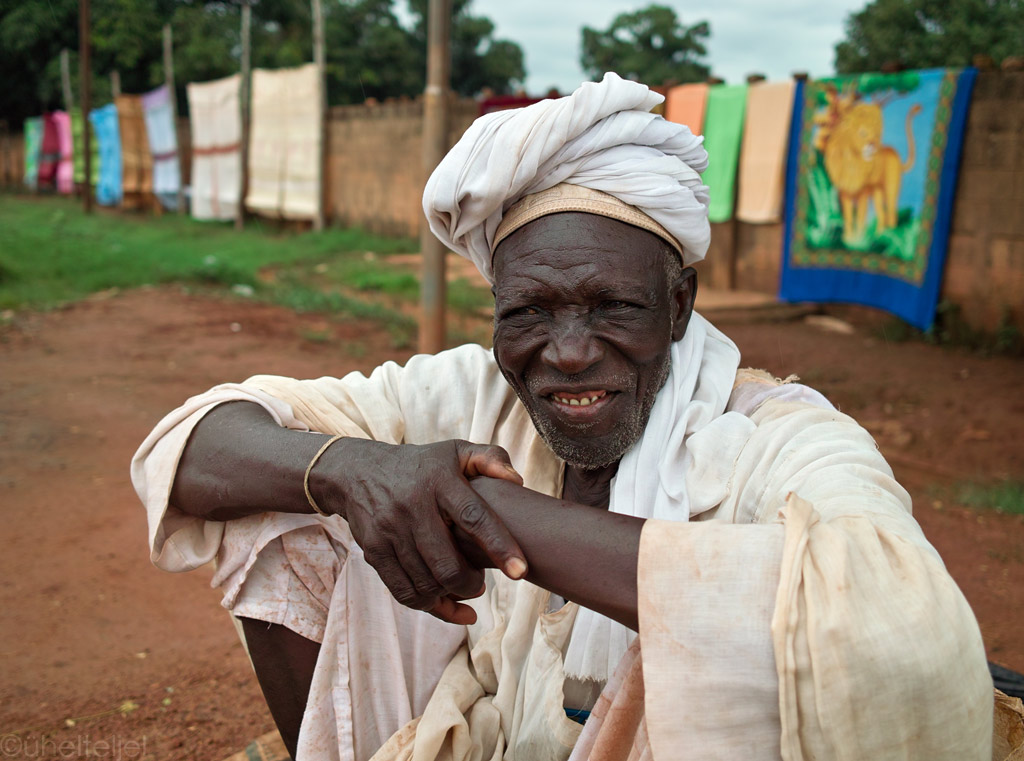
A Muslim man selling tea and Qurans on the side of the road.
All in all, Burkina Faso turned out to be a place worthy of some more exploration, not just whizzing through, and we hope it will set a good example for the countries to come - not just suffering and hard times, but some reward too!
Then came Mali...
In Mopti the air was hot and humid, as if the breath of the Sahara had clashed with the moisture rising from the river, and where ever we stopped we were immediately surrounded by a crowd, including some persistent tour agents willing to give us "the best price" for a ride down to Timbuktu, or to lead us to "the best hotel" in Mopti. We had just arrived, and we already felt like getting out of there as soon as we could, and forgetting about Timbuktu.
To accompany the pics from around the river port in Mopti, here's some music from the local radio:
...::: Listen Mopti local radio playing Mali music I :::...
...::: Listen Mopti local radio playing Mali music II :::...

A panorama from the river port in Mopti (click to enlarge panoramas)
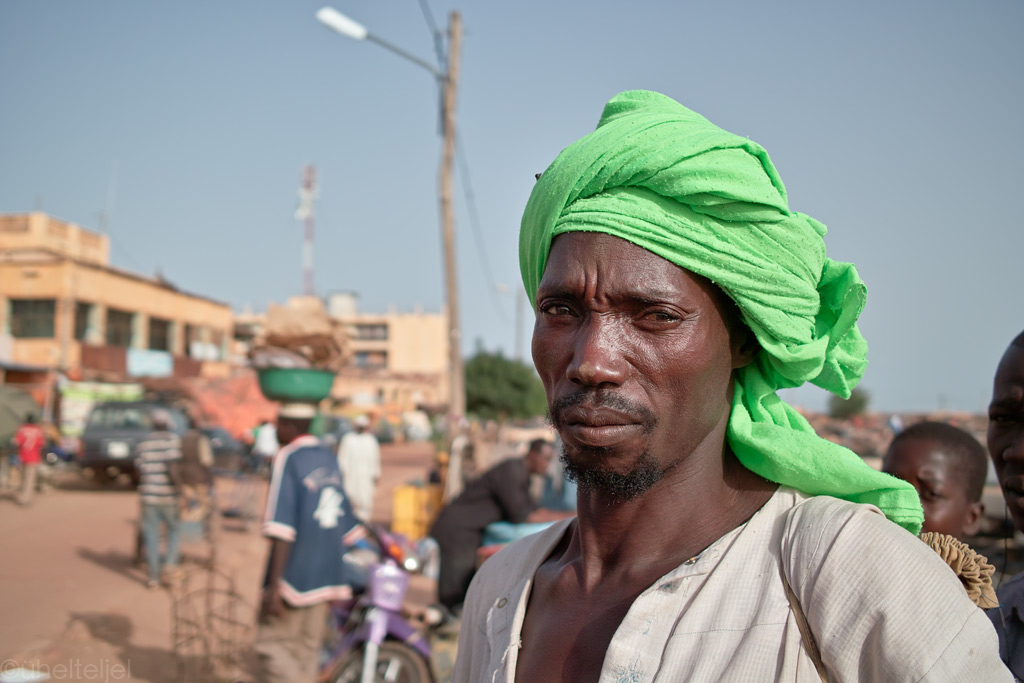
A local.
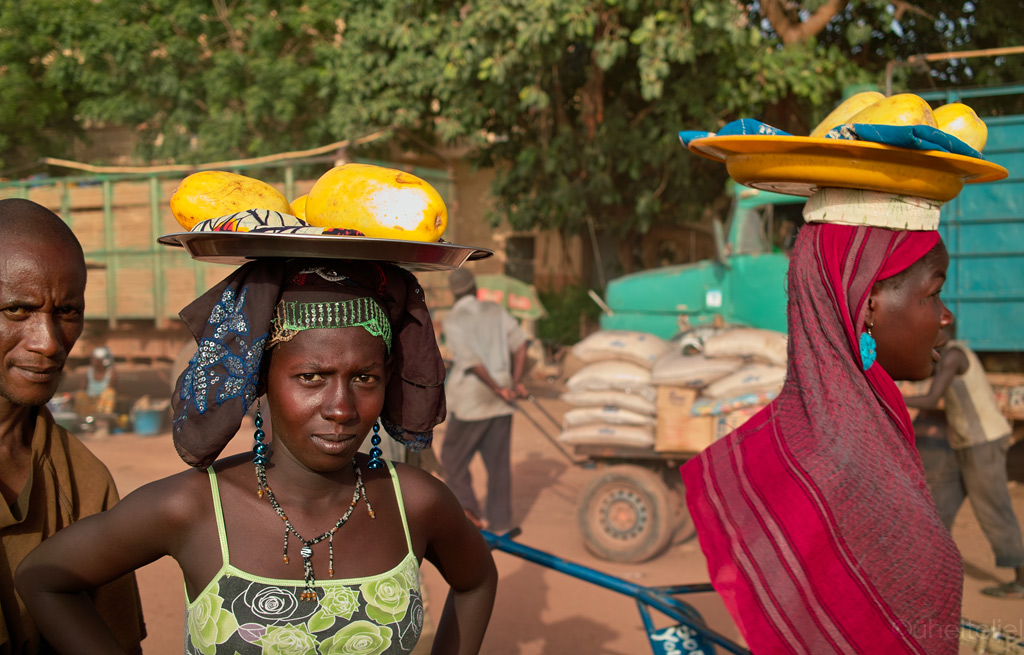
Girls selling melons.
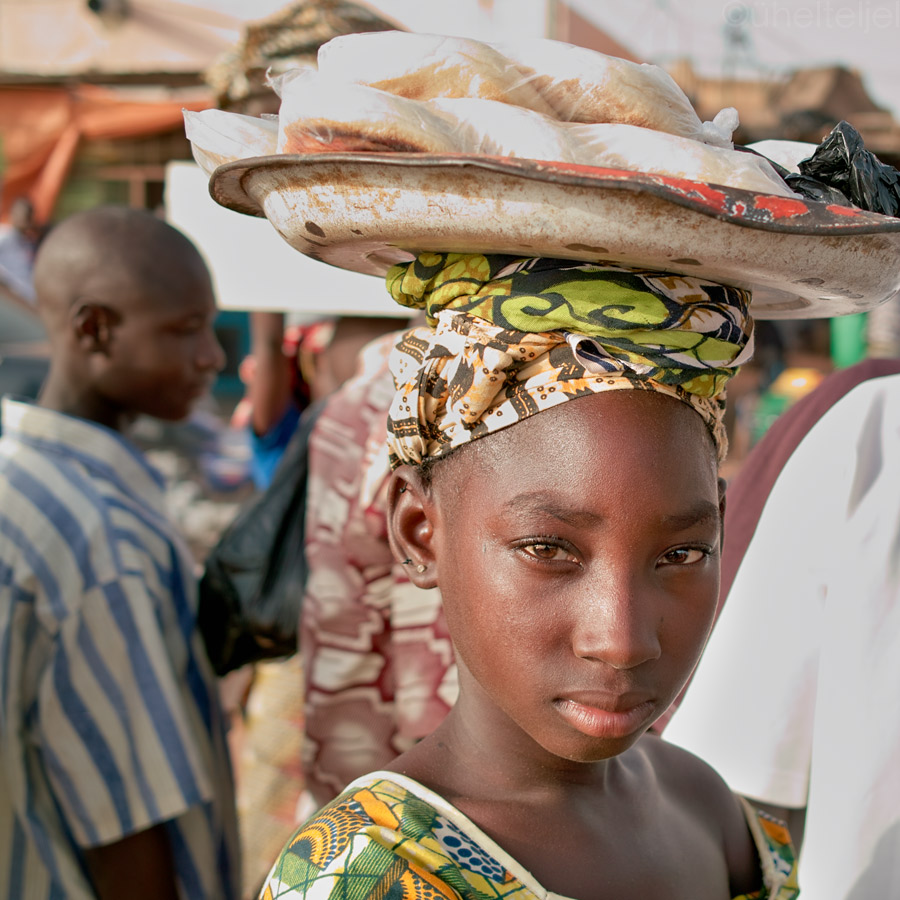
A bread seller.
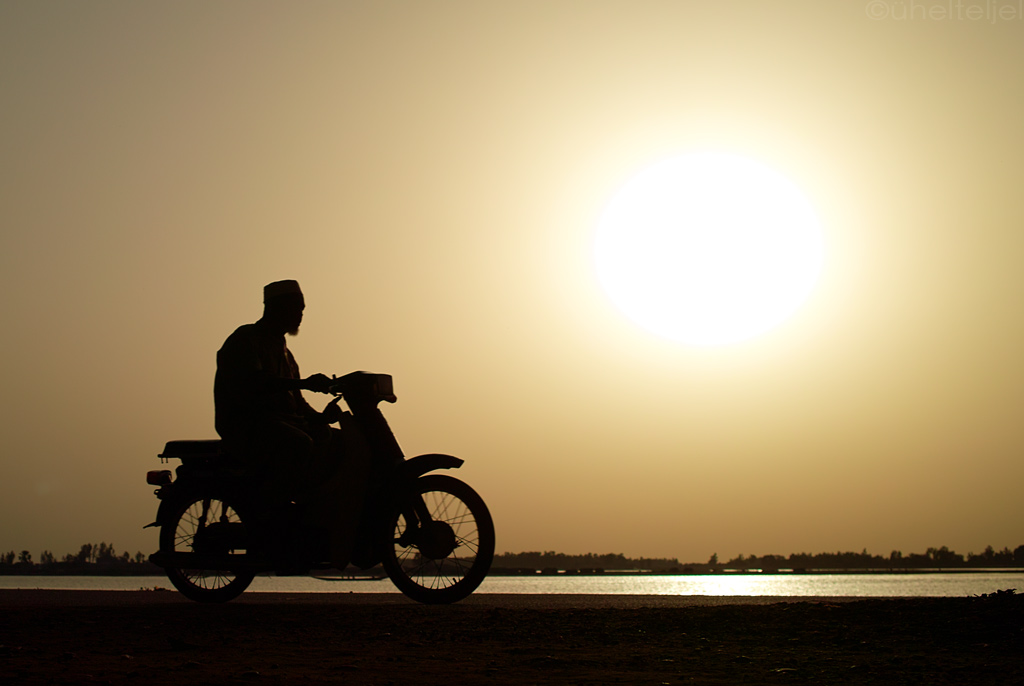
A Muslim man on a bike.
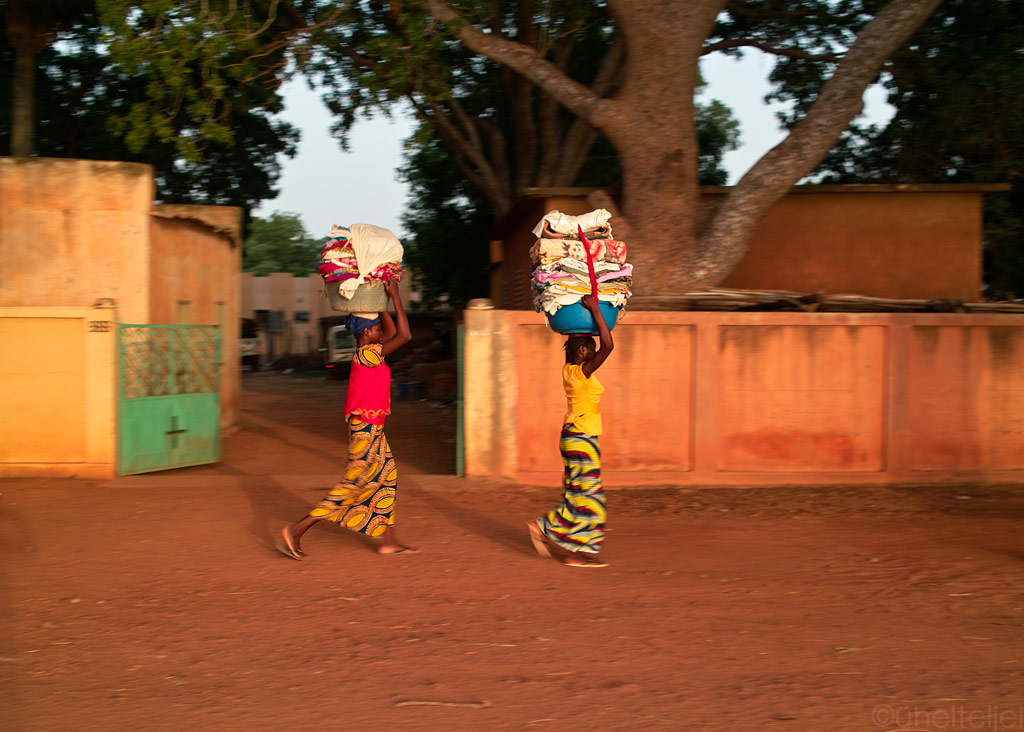
Ladies carrying linen freshly washed in the river.
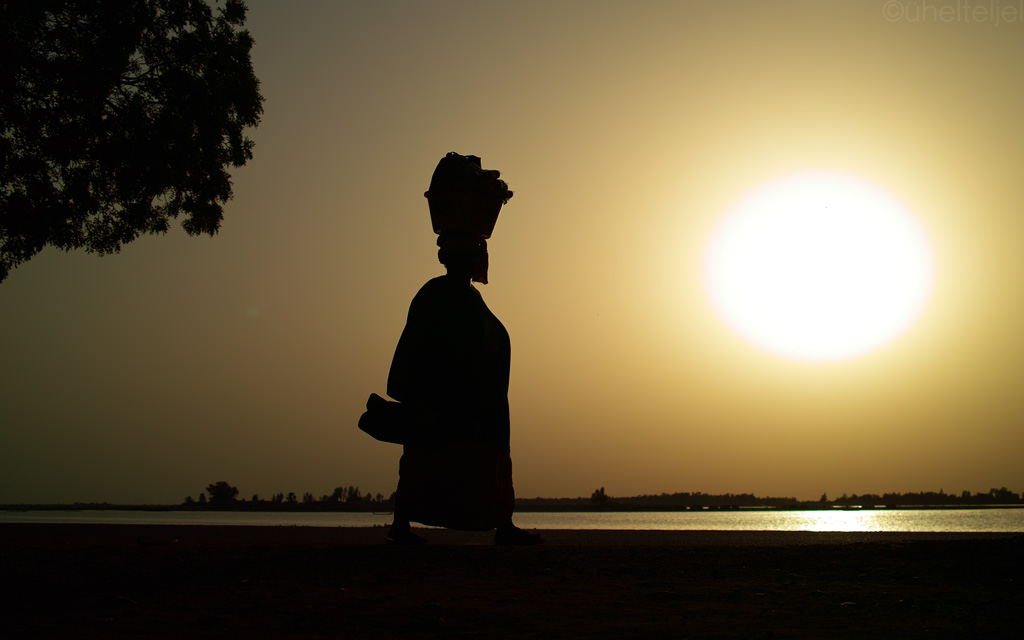
An African lady on the backdrop of the river.
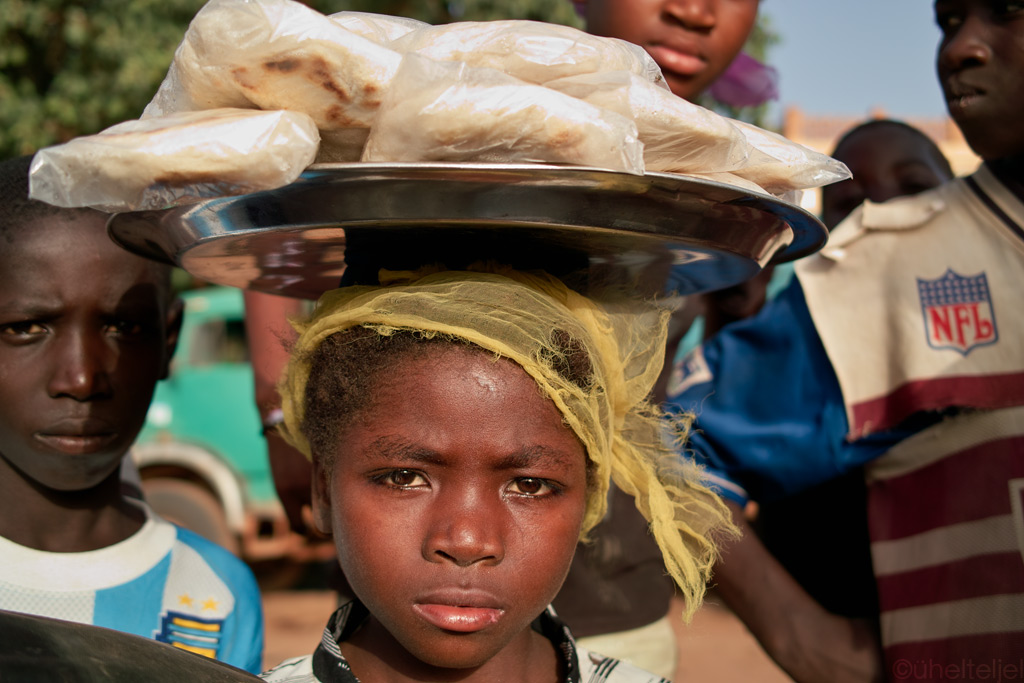
Selling freshly baked bread.
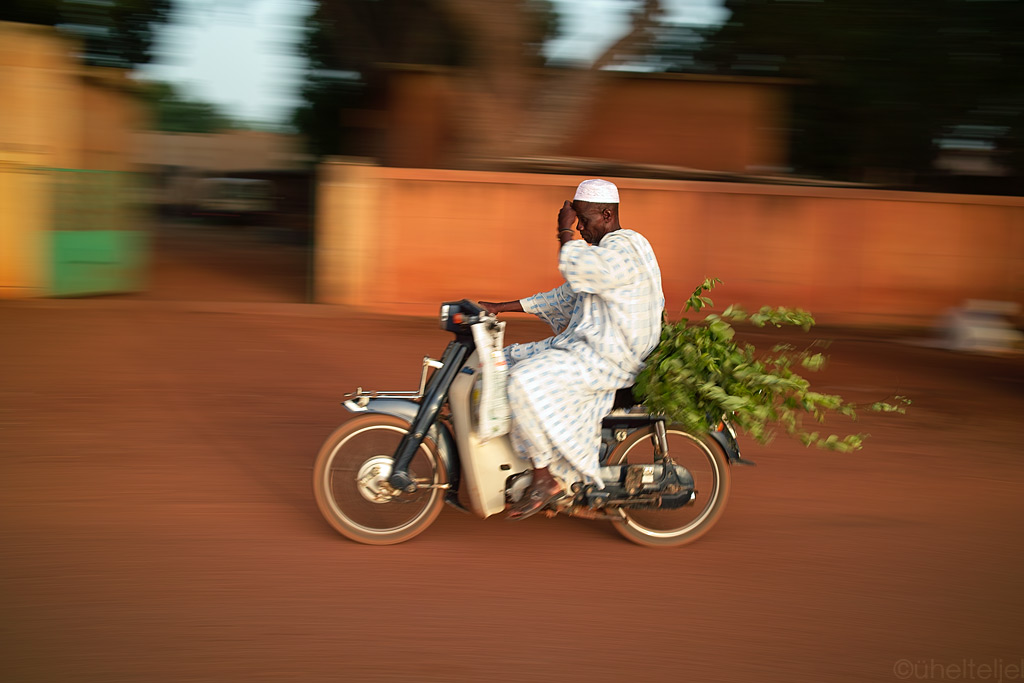
Rolling down the road.
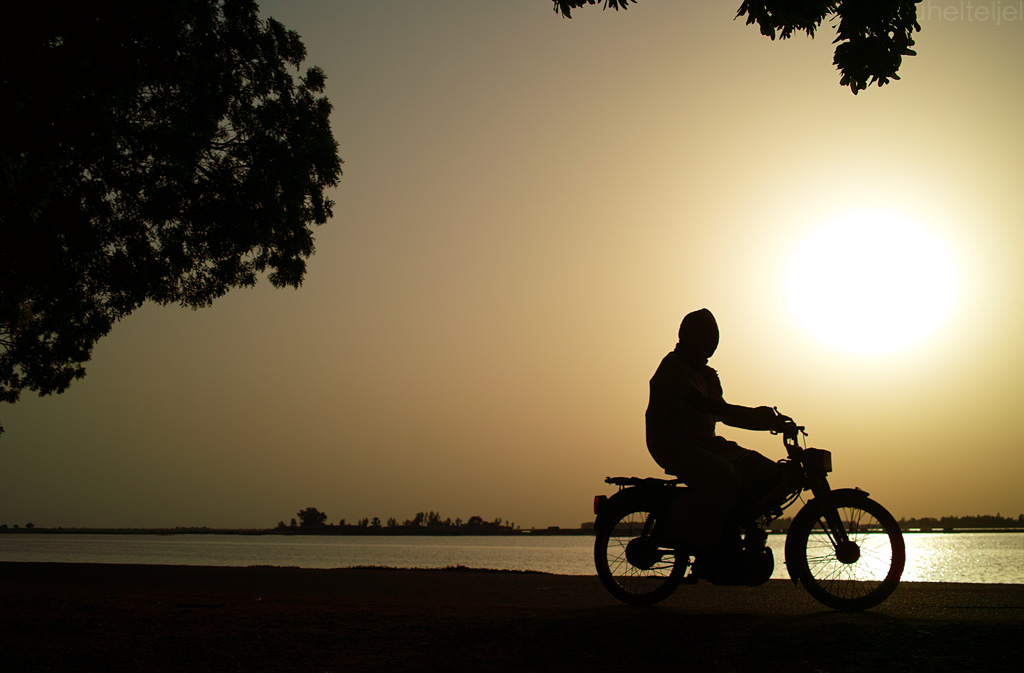
A Touareg wrapped in a cloth.
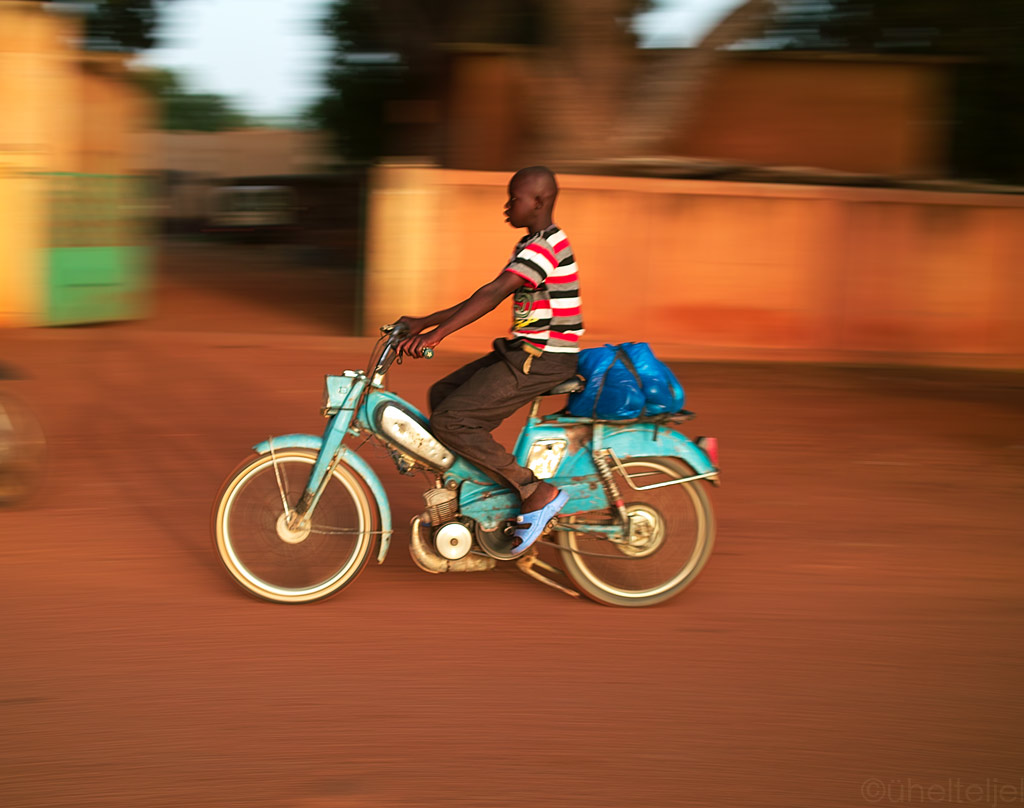
The young generation.
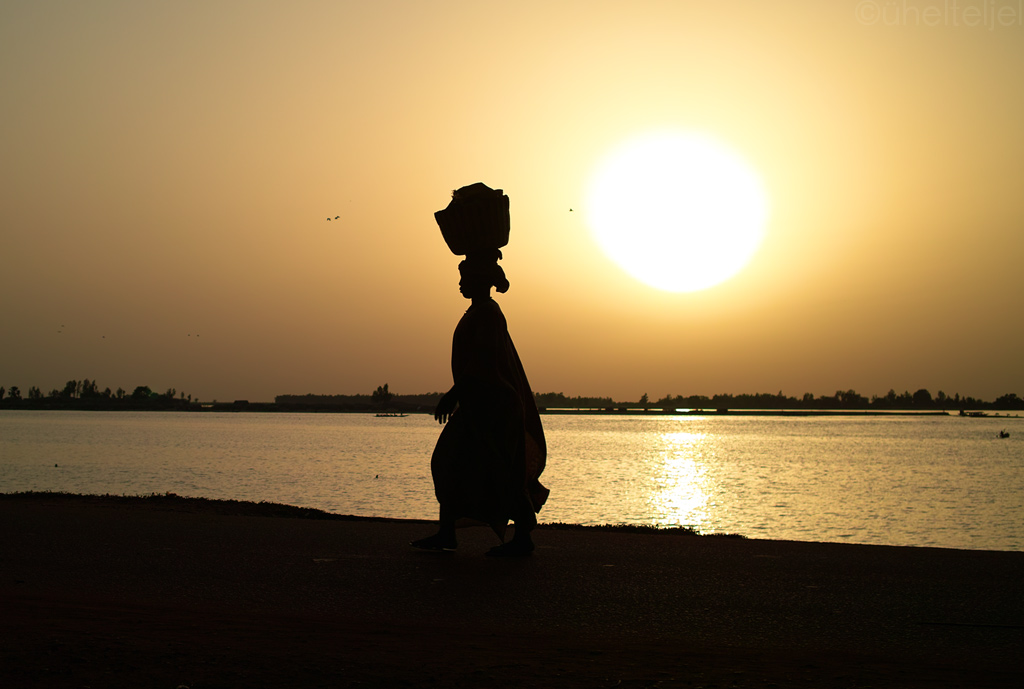
African lady.
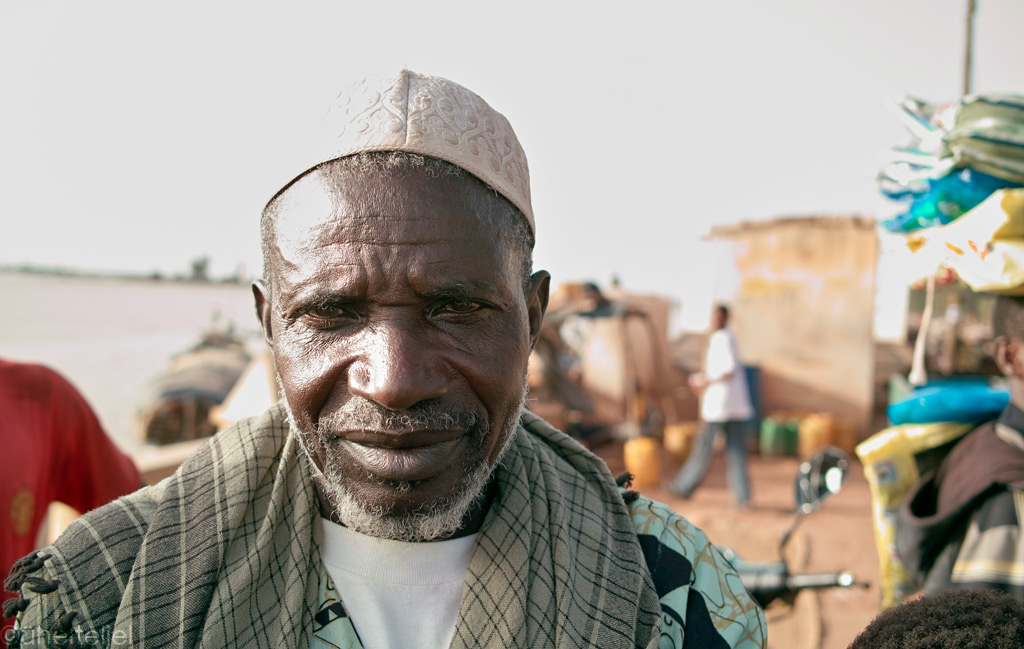
A Mopti Muslim.
As we try not to give in to the first impressions and rather let them settle overnight, we ended up staying at one of "the best hotels", i.e. on the roof of a hotel. Since it was located right in the centre of the town, we got to experience to full extent the sounds of all the nocturnal goings-on, the tortured cry of a muezzin awaiting the end of the Ramadan, and the terribly thirsty whine of malaria mosquitoes outside the tent. But what was even worse - the roof had absorbed so much heat during the day that we felt like on a stove top, drowning in our sweat all night. Even in the morning, the thermometer showed +36 C (+97 F) in the tent, so at night it must have been around at least +40 C (+104 F). No sleep that night.
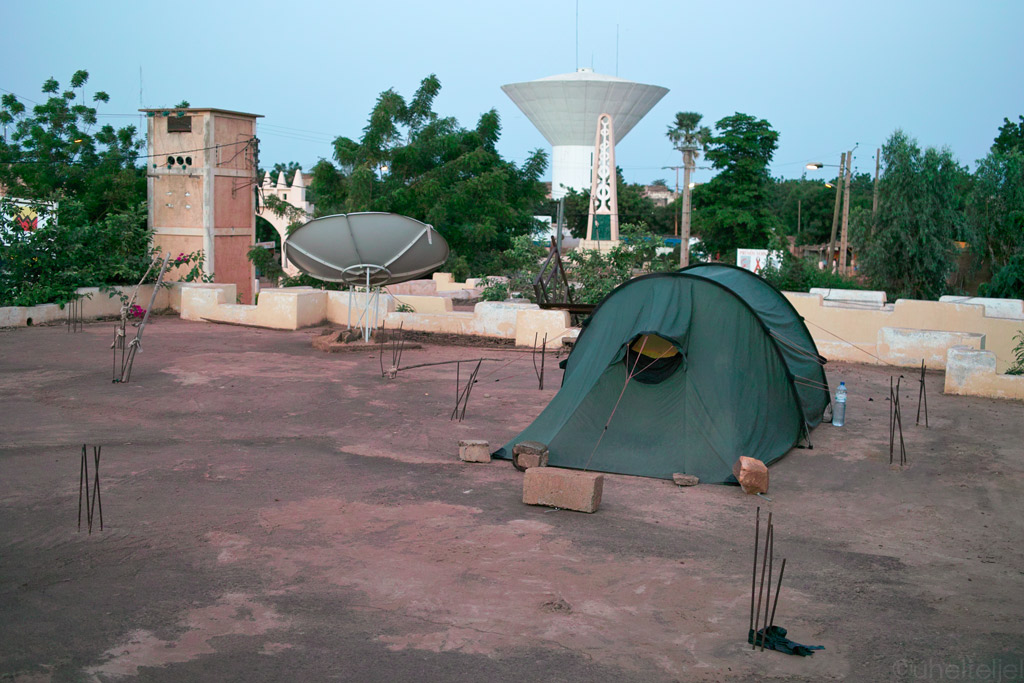
Camping on the rooftop - but no sleep!
...::: LISTEN Mopti's ambient sound during night after ramadan :::...
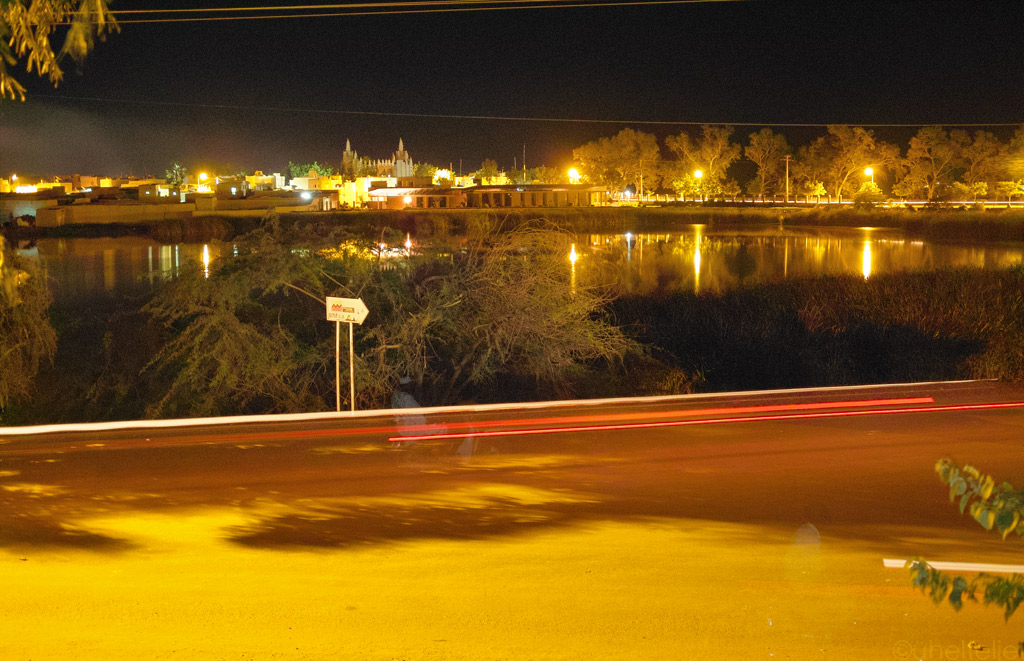
Night time view from our camping spot - notice the minarets of Mopti's mudbrick mosque on the background.
By morning we had decided: Timbuktu is off! To try and survive in similar conditions for three days on a boat, or to break another suspension bolt going down the bad road and wait for assistance in the +47 C (+117 F) heat - it was not worth it. If we had been here in January instead…
In the morning light, we made another ride through Mopti, and as it was early enough, the people were just waking up and we could have a more relaxed look around.
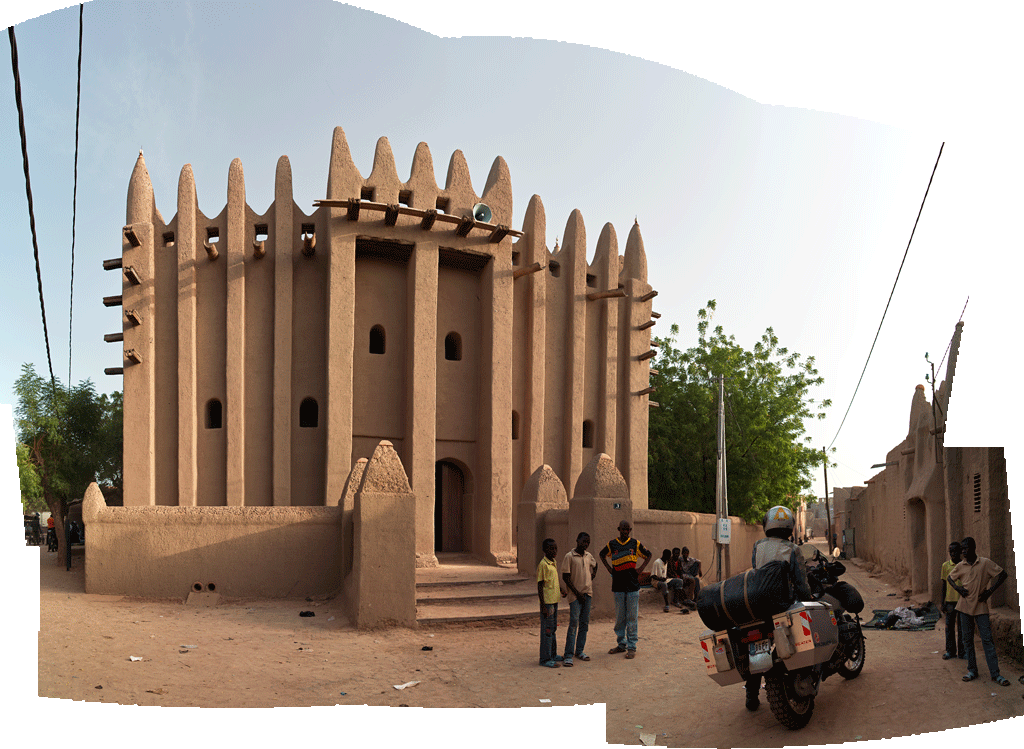
A mosaic of Mopti's mud brick mosque in the morning light.
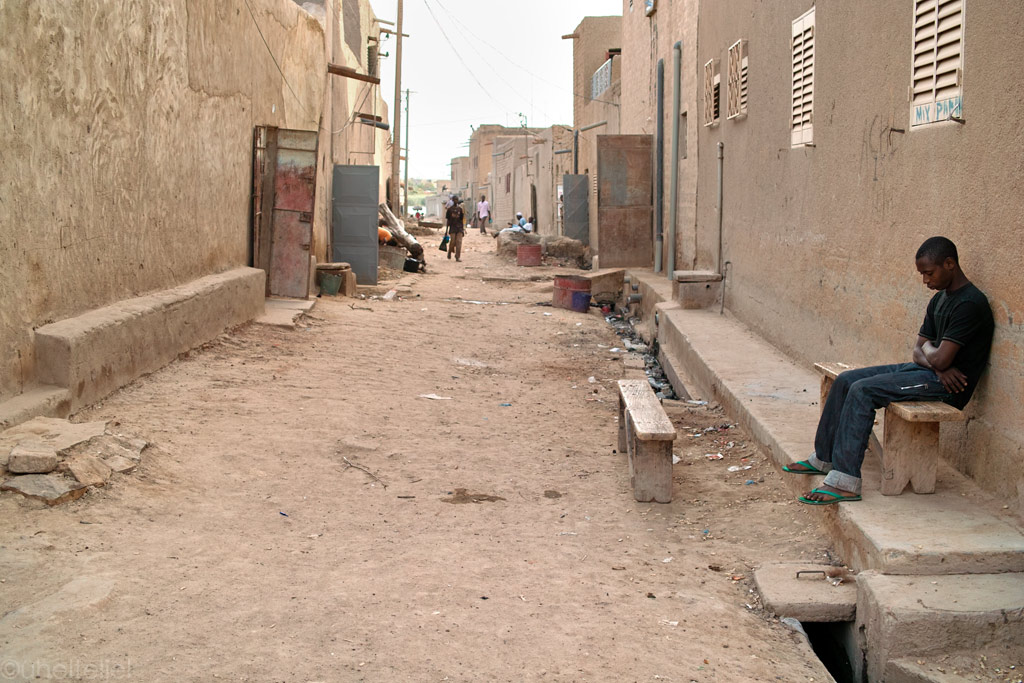
Morning in the old town of Mopti.
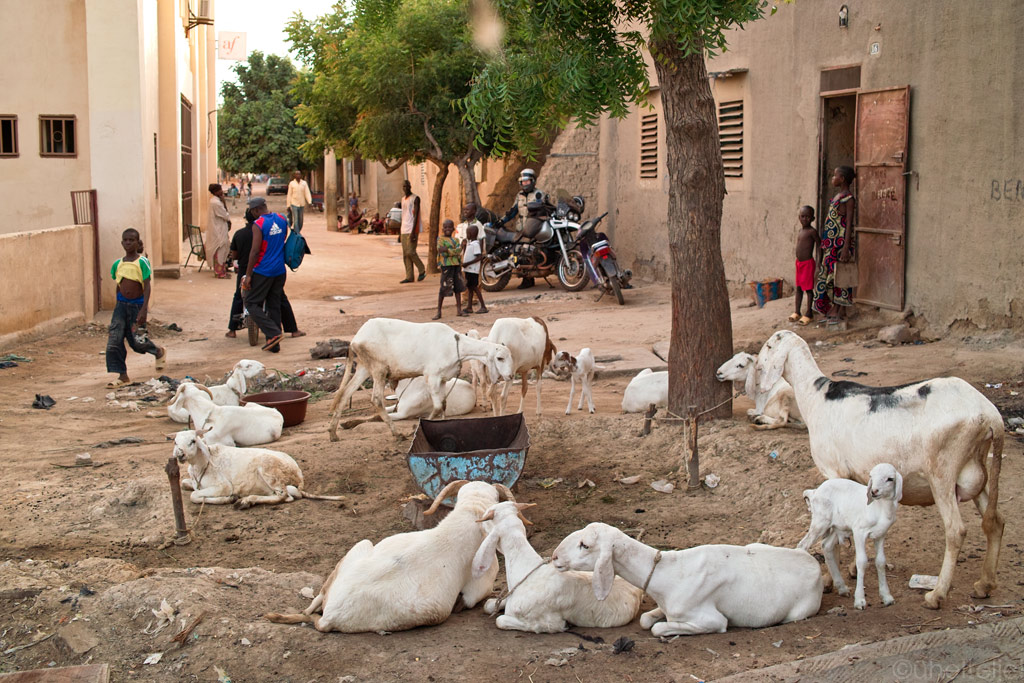
Goats roaming the streets.

The Mopti's riverside panorama - notice the piles of garbage. (click to enlarge)
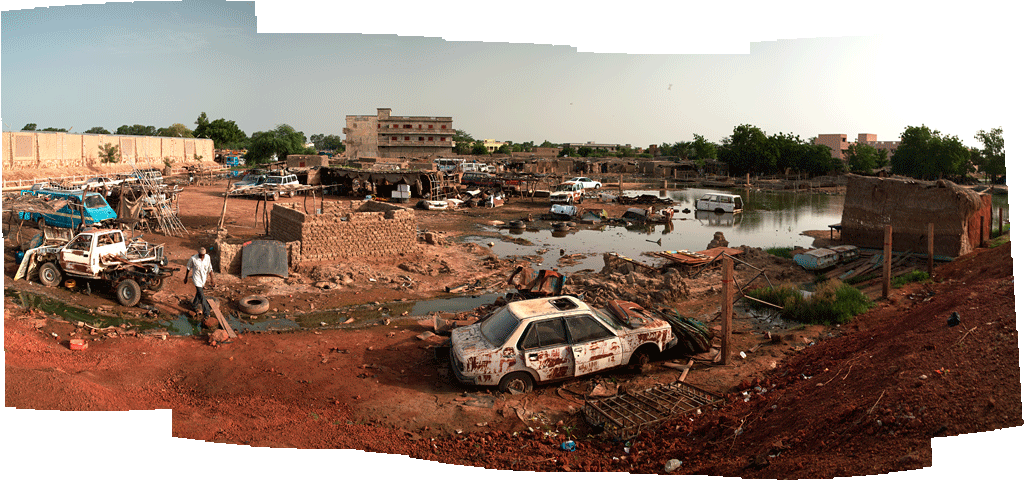
Roadside view (click to enlarge).
Djenné, which actually used to be of an even greater importance than Timbuktu, boasts the largest mud building in the whole world - a mosque dating back to the beginning of the last century, which is also one of the main tourist attractions in Mali. But contrary to the over hyped Timbuktu, Djenné is easily accessible, and because there really hadn't been too much to see in West Africa, we had grown a little thirsty of culture, architecture and history. So we decided to go and check it out.
Since Djenné is located on a flood plain between two rivers - Bani and Niger, every year after the rains it becomes locked in, and is only accessible by boat. The water levels are at their maximum around October.
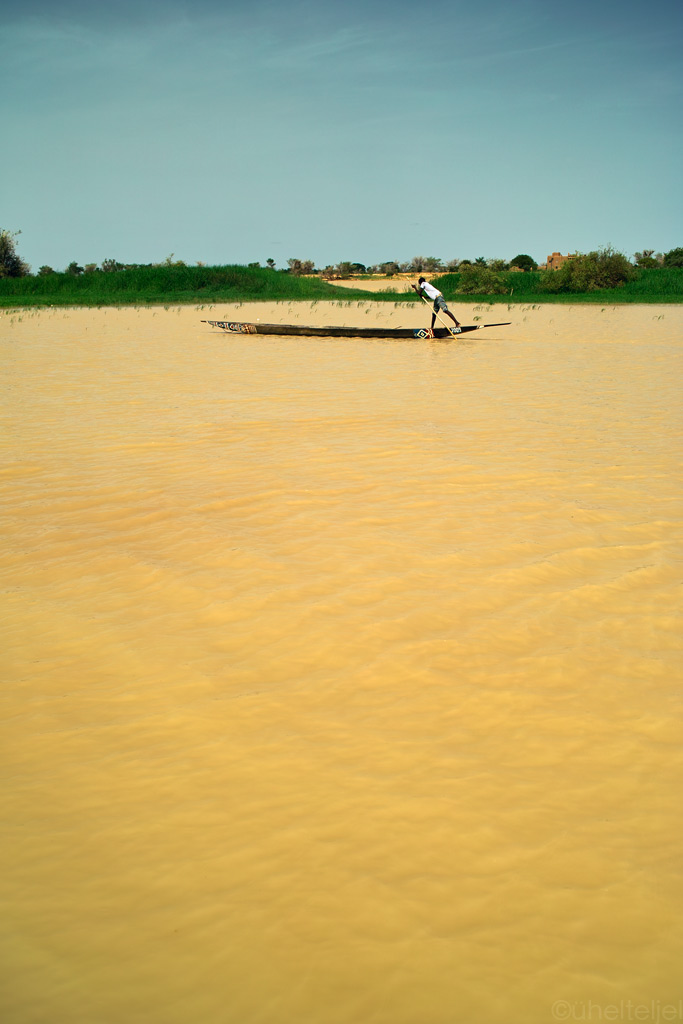
A pirogue on Bani river.
To get across, there is a ferry, but the time interval between its comings and goings is pretty unpredictable. When we arrived at the river, the ferry was being loaded on the other side. One hour later it still hadn't moved. Meanwhile, the sun was blazing and we could not help but to think that even if the ferry was to come across it would probably take at least another hour before it would move. So when we were offered to take a ride in a motorized pirogue that we'd seen going back and forth across the river many a time, we agreed on the price and before we knew, the GS was already being lifted into the pirogue with the help of some ten guys. A few minutes later and we were already on the other side, the ten guys, knee-deep in the murky water, trying to lift the bike off the boat. Looking at how smooth it all was, and judging by the very pleased look on the face of our boatman as we handed over the cash, the 5000 CFA that we'd agreed upon felt like too much (the ferry would have cost 2500 CFA), although if we compare it to the 10000 CFA that we had had to pay after dead heavy bargaining for the bike to be loaded onto the Calabar ferry (which did not require the force of ten men), it didn't sound too bad. It is really difficult to know how much is a fair price.
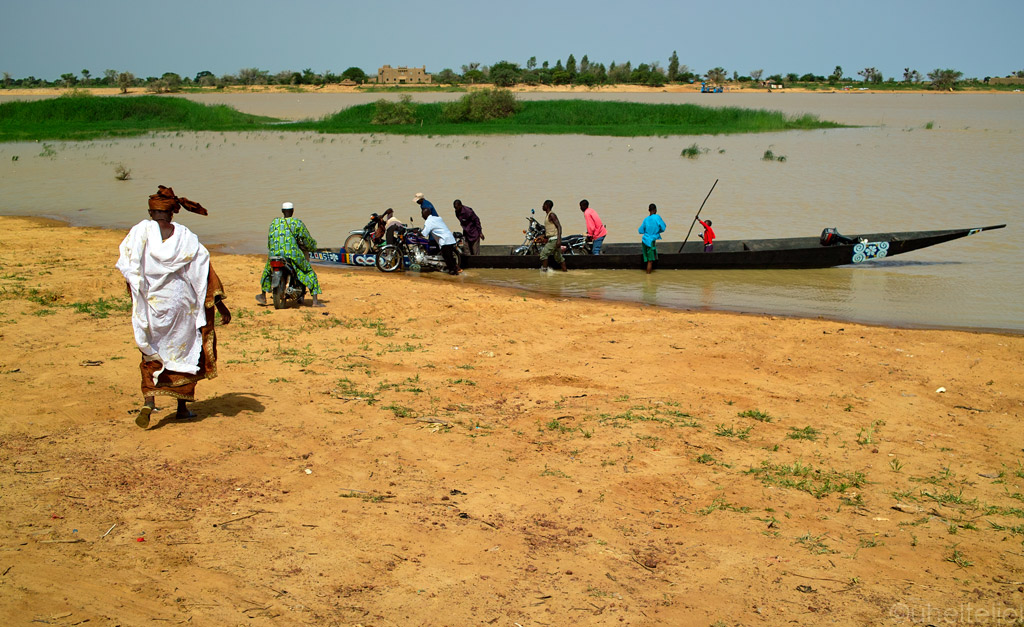
Loading the people and the cargo into a pirogue to go across to Djenné.
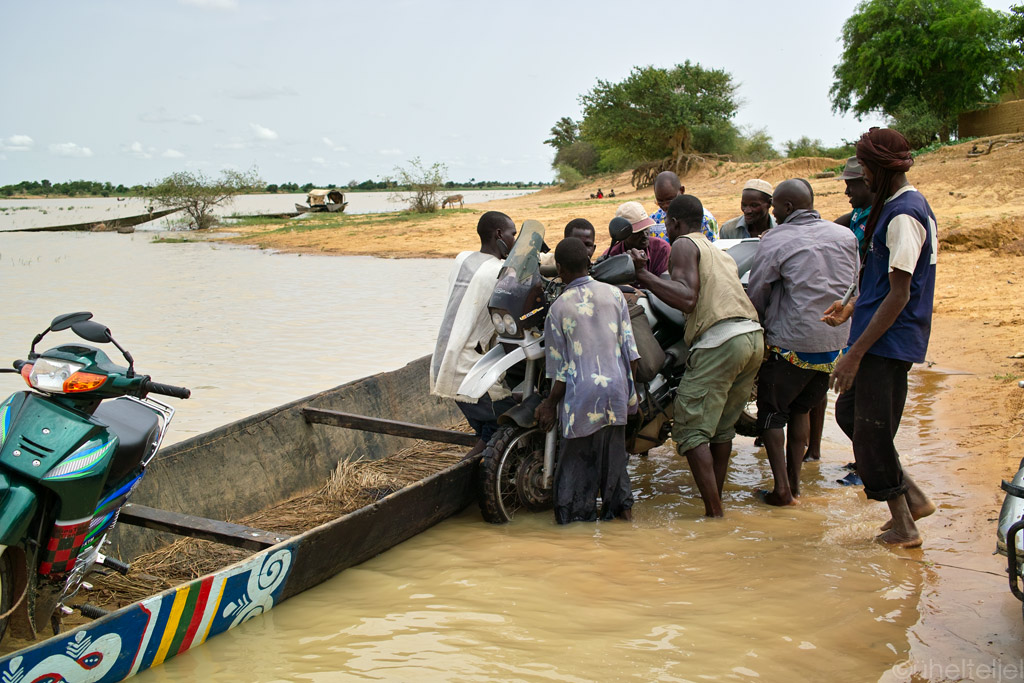
Ten men wrestling with the GS.
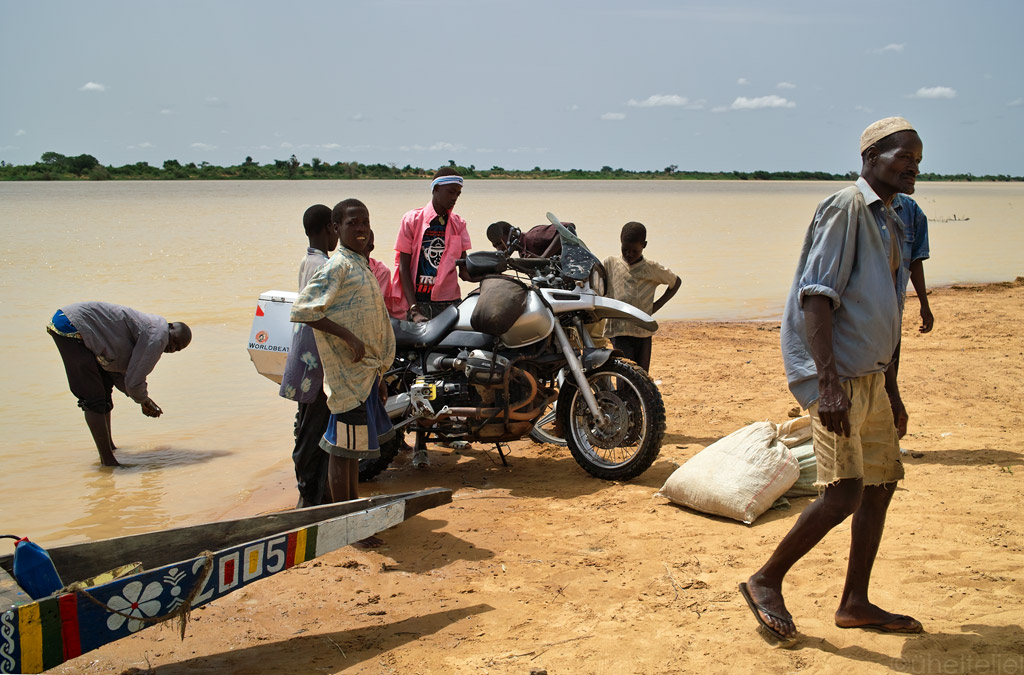
Safely on the other side.
Djenné is an interesting place, with an atmosphere quite different from all other places we'd been so far. Vaguely, it resembles Yazd or some desert villages in Iran, but this comparison is really only based on the fact that they boast some magnificent earthen architecture - Yazd is far more elegant and those desert villages are far more quiet, whereas in Djenné, life is rough and at its full force - goats running around, someone playing kora, a very popular musical instrument in Mali music…
But not even once can we hear the call to prayer, because the mosque's sound system (well, basically consisting of the good old megaphones that adorn the minarets all over the world) has failed. The locals oppose all modernization, trying to keep the mosque the same as it was in 1907 when it was built.
The mosque itself does not look as huge as one would imagine having seen its pictures. I guess the thing is that most of the photographs on the internet have been taken in the morning light when the palmwood sticking out of its walls does not leave shadows, the mosque thus looking like a scyscraper dotted wth windows. Nor does the mosque look particularly ancient, because every year, after the rainy season, a ceremony takes place during which the walls of the mosque are given a new layer of mud to repair the damage caused by water.
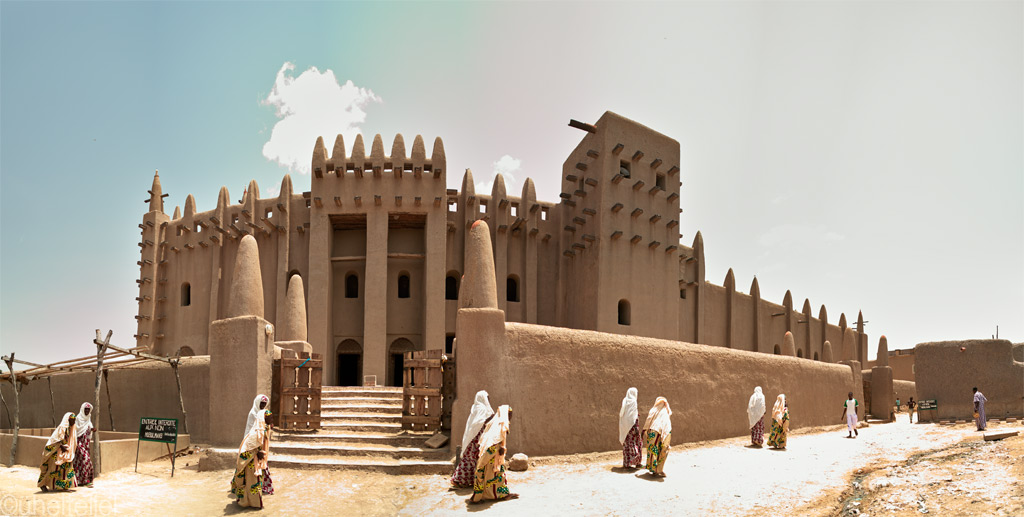
Panorama of the Great Mosque of Djenné.
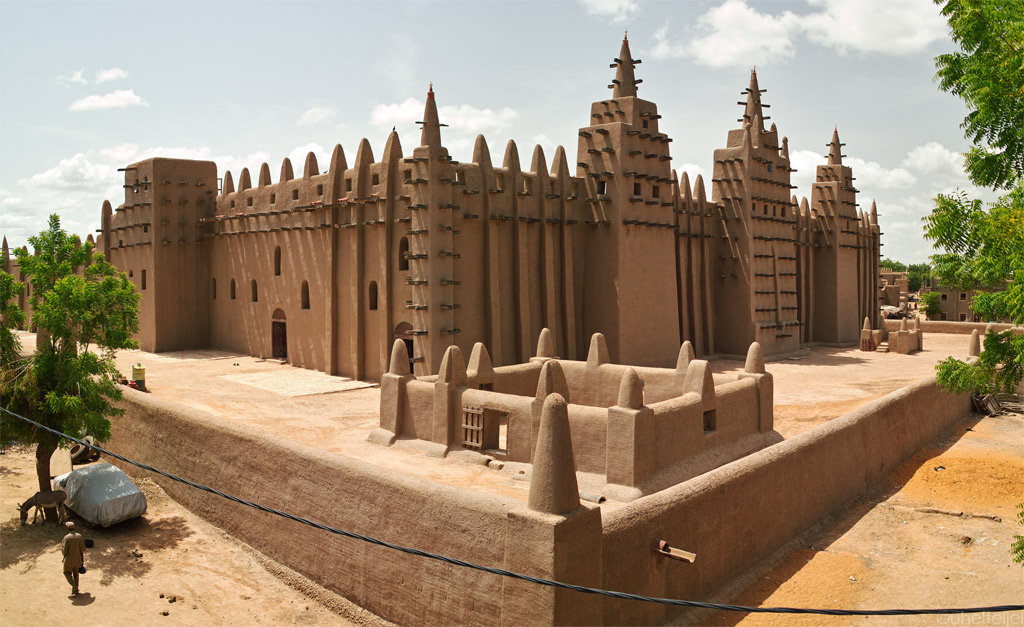
The biggest mud building on planet Earth.
But the mosque is not the only thing to see in Djenné - the whole town is built out of mud (and straw), so the colours and textures are very natural, blending well into the surroundings. There is one thing, though, that does not mingle very well with the atmosphere, and it is the sewage. Until lately, the people would go to the river to wash and to do their thing, but some smart asses in the developed world though it was utterly unhygienic and decided to help out by investing into a running water project. Somehow they managed to overlook the fact that running water does not only need to be brought in, but also taken out (or, maybe it was that someone simply pocketed half of the money, as it too frequently happens in the developing world), and now what we see is the sewage simply flowing down the streets. Some steps have been taken to fix this, but from what we saw, a lot still needs to be done.
Some local music to accompany the browsing:
...::: LISTEN local Mali music :::...
...::: LISTEN local spirital groove from an old noisy cassette :::...
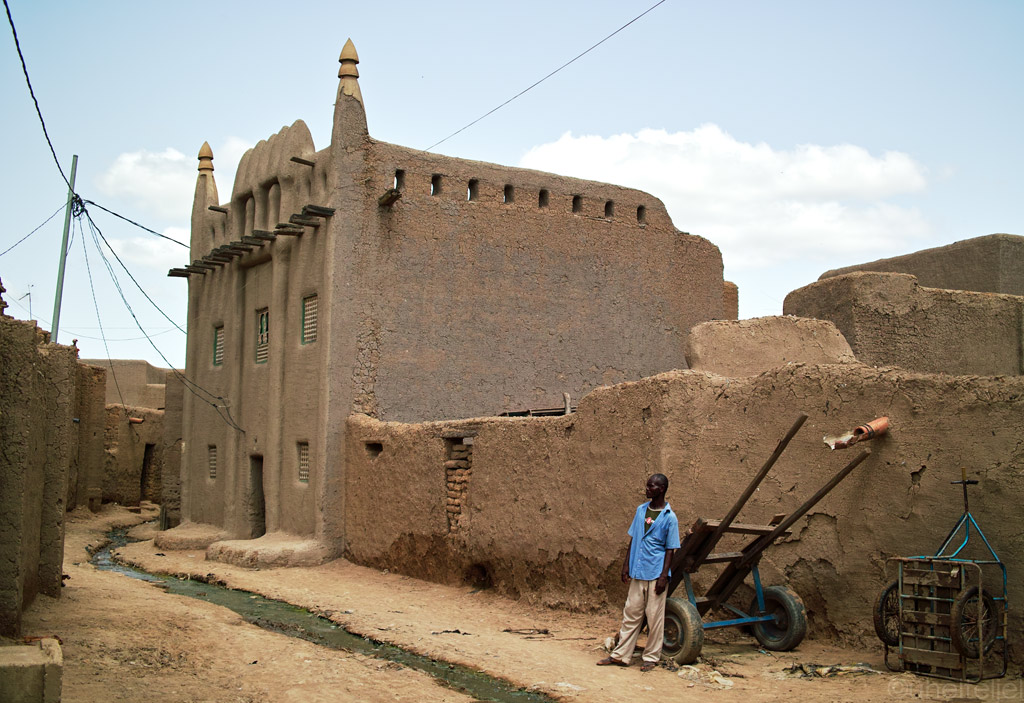
Djenné street scene. Notice the green stream flowing down the street - this is the sewer.
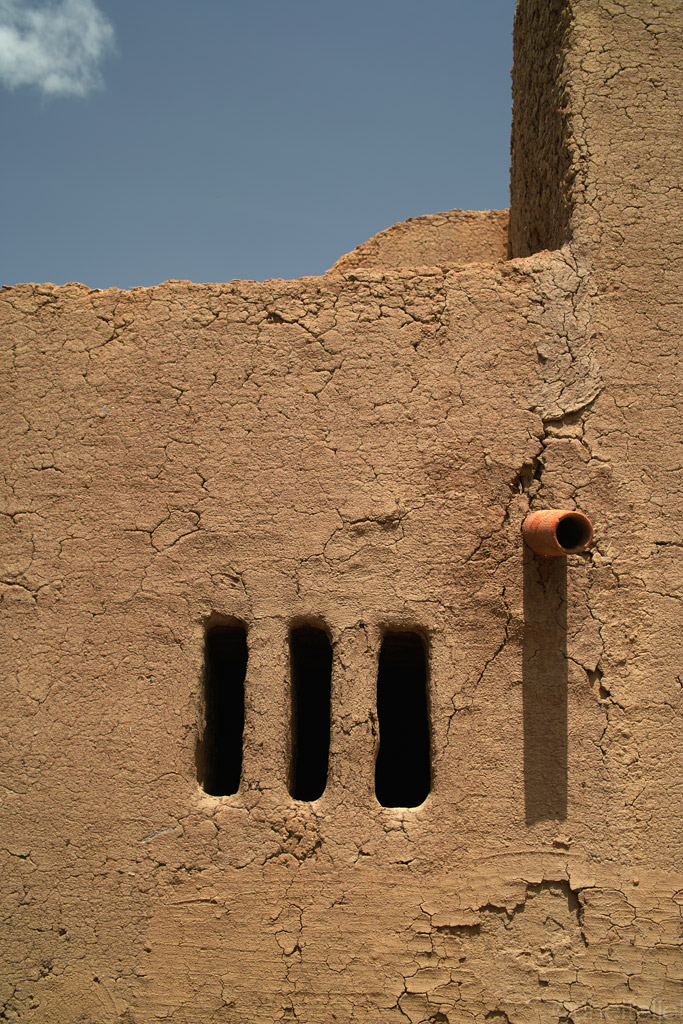
A window and a water pipe for guiding the rain water off the roof.
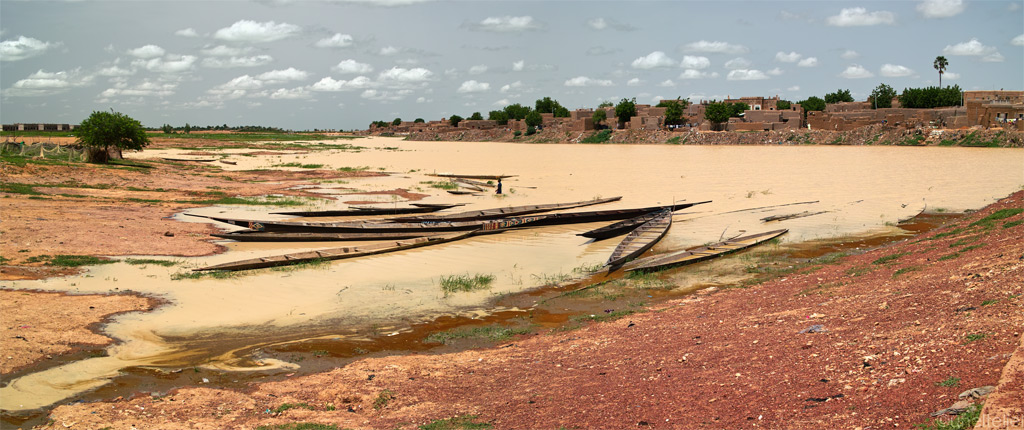
Pirogues on the backdrop of Djenné (click to enlarge)
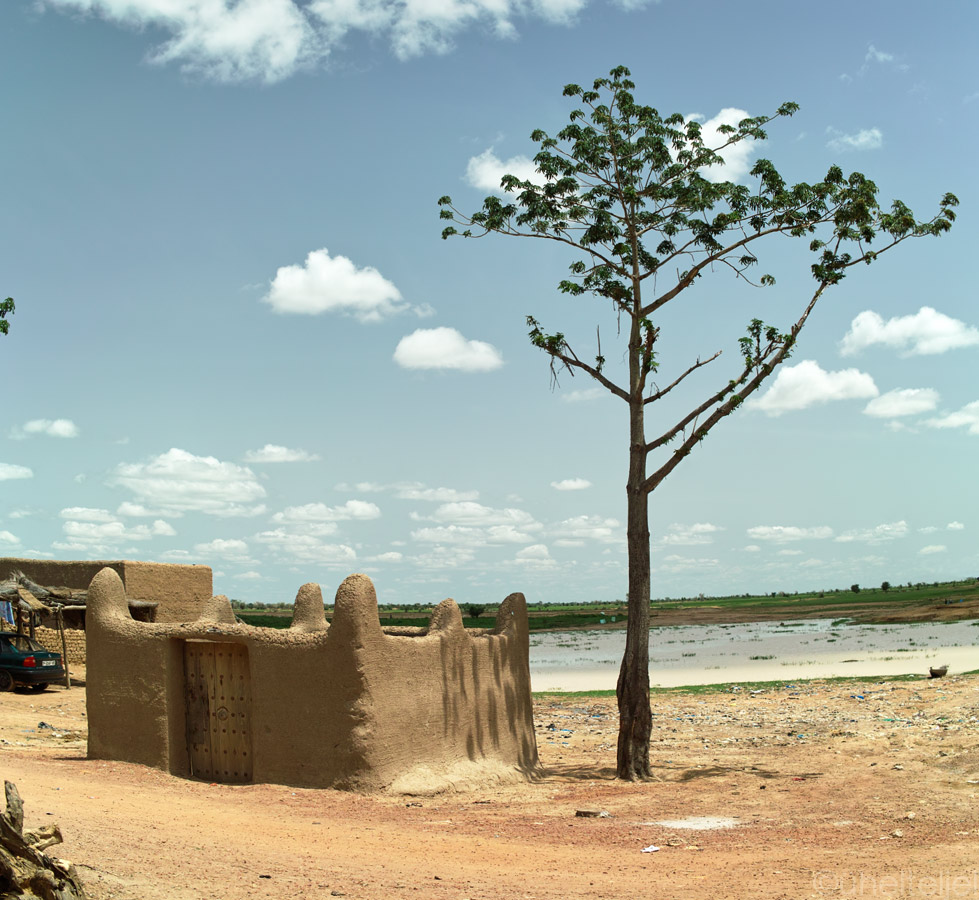
A tomb to a 14-year-old virgin who was buried here alive (yes!) to keep off bad spirits.
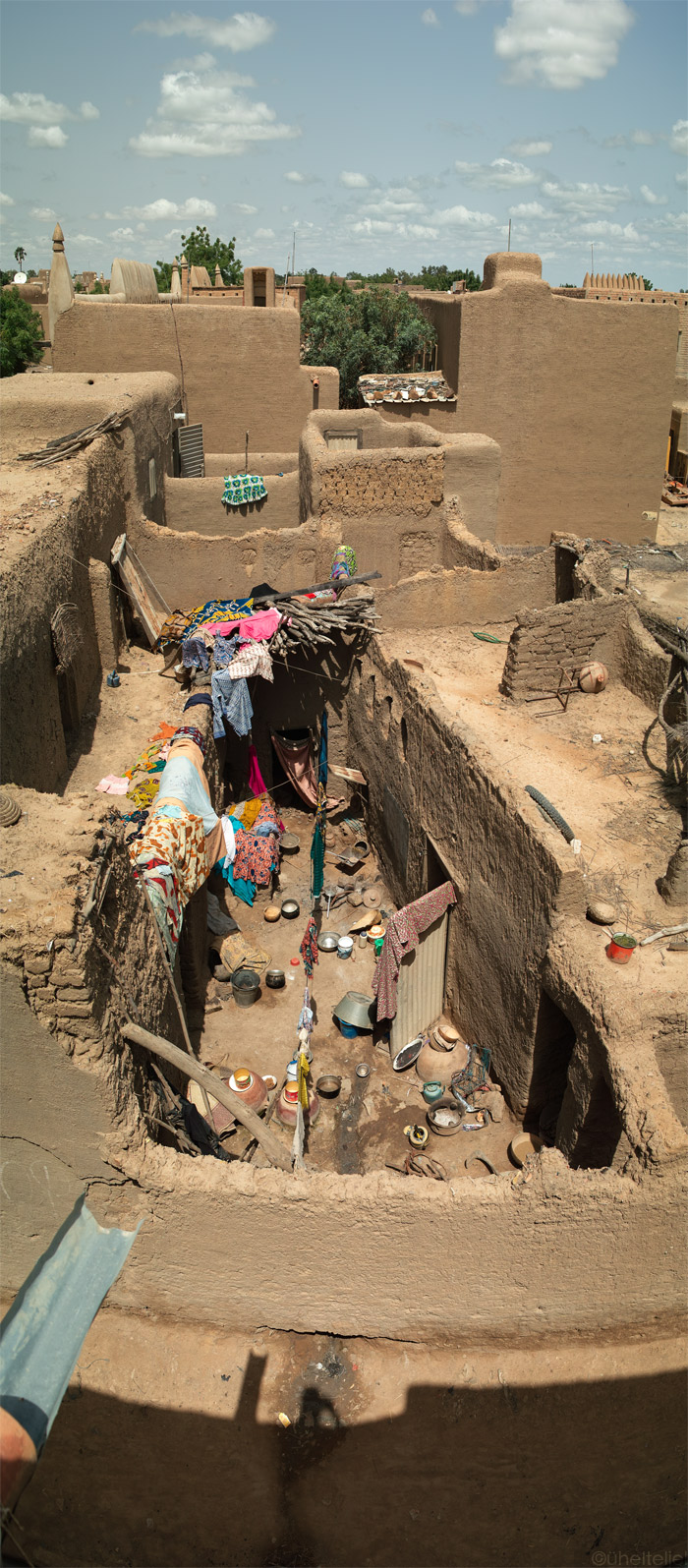
Behind the high walls, life is happening in the family componds.
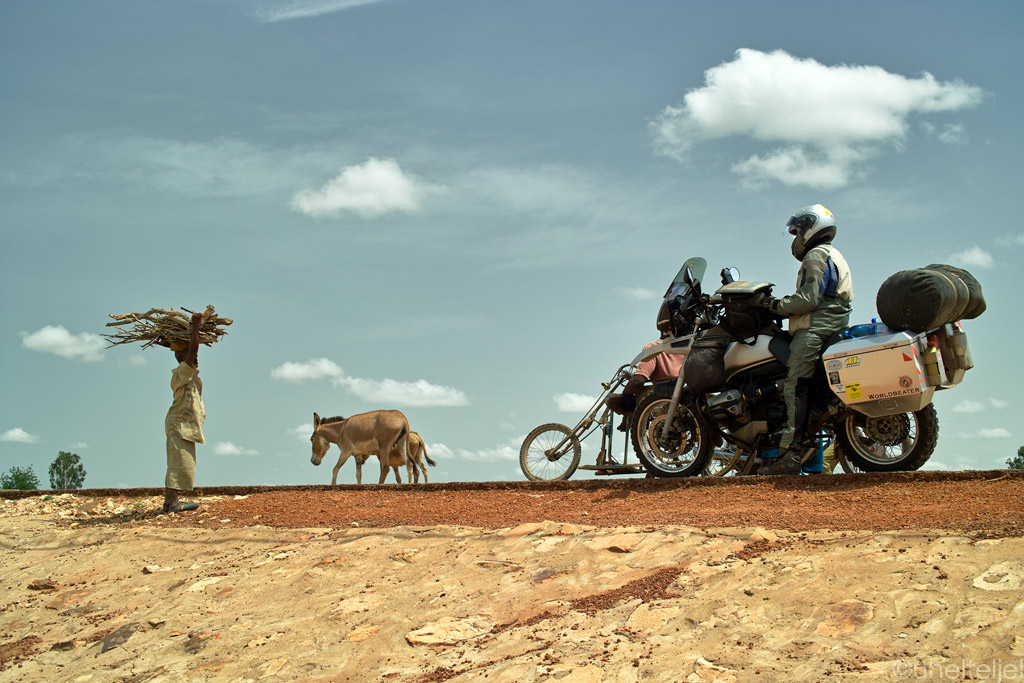
Roadside life.
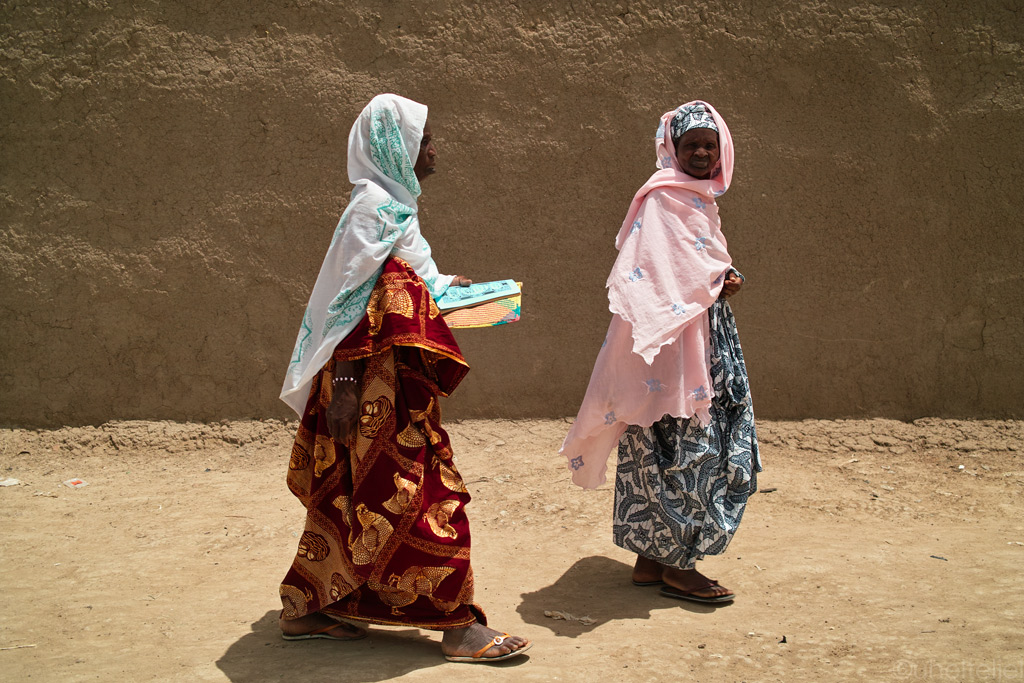
Old ladies with Quran.
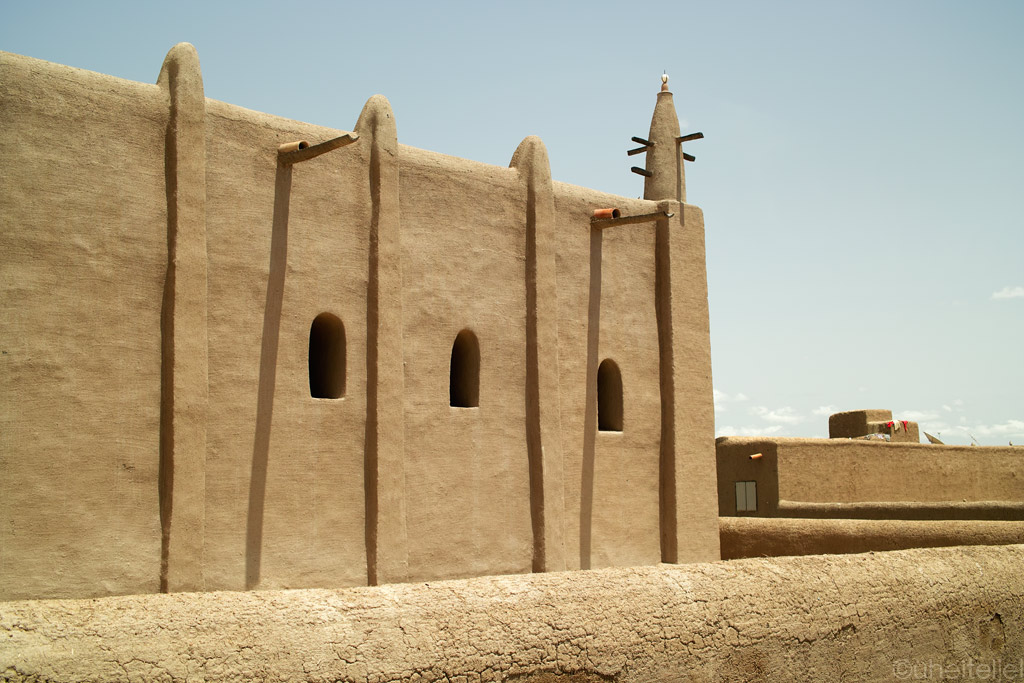
A close-up of the mosque.
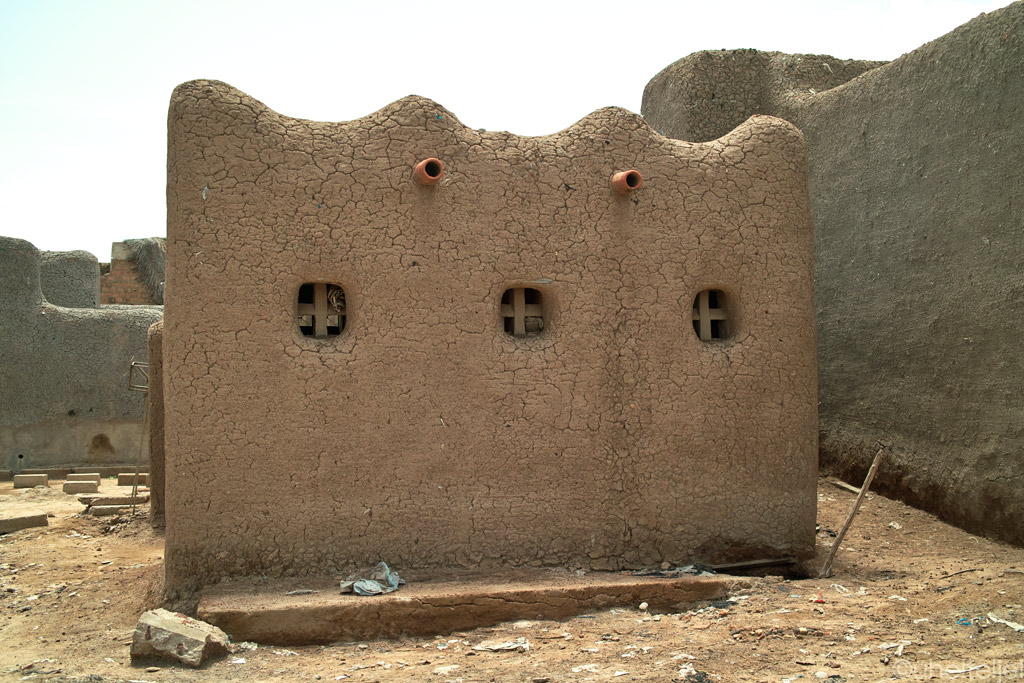
House in Djenné.
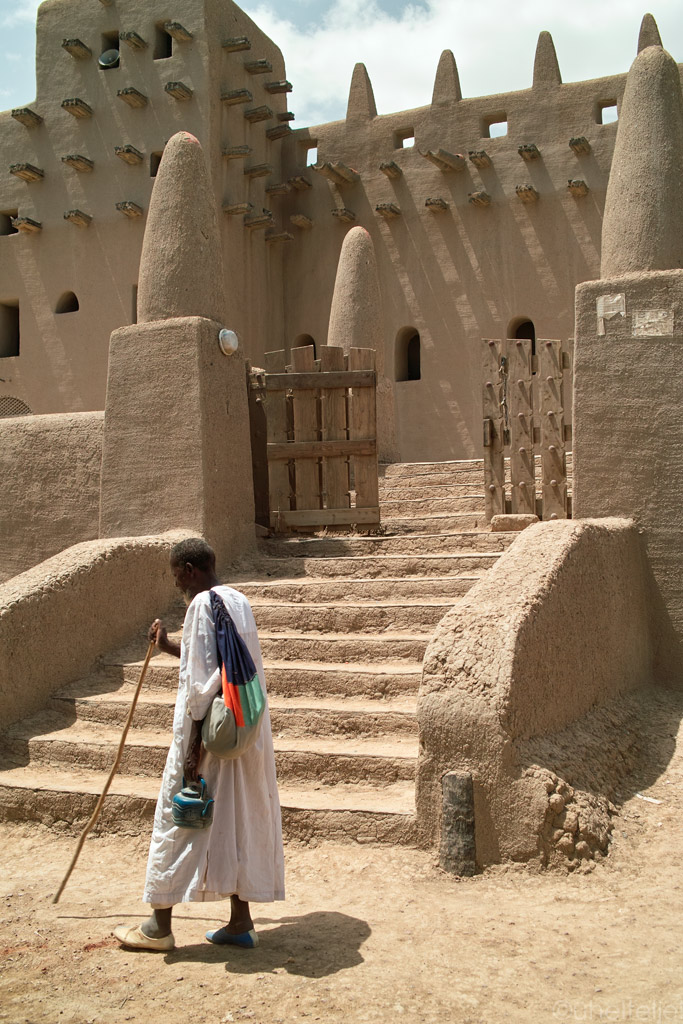
A Muslim man in front of the gate to the mosque.
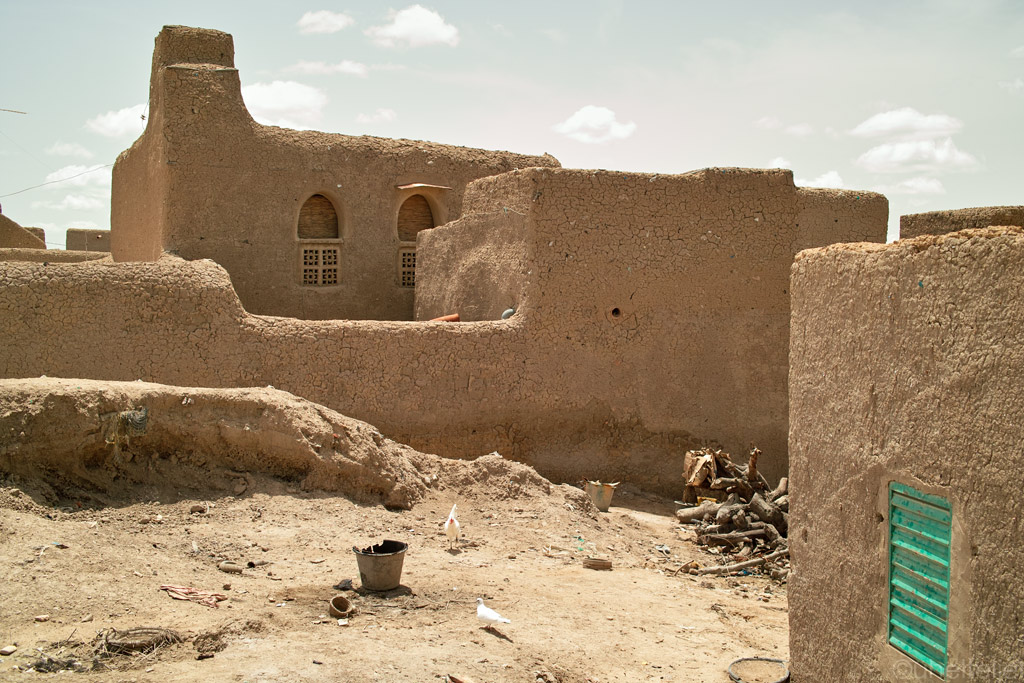
Street view.
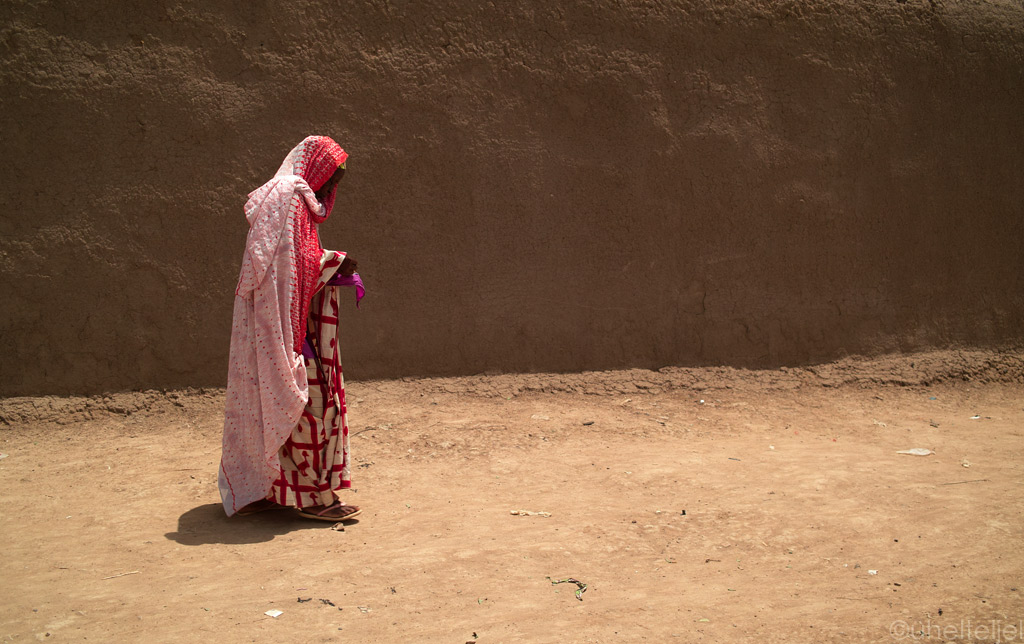
Old woman on Djenné's street.
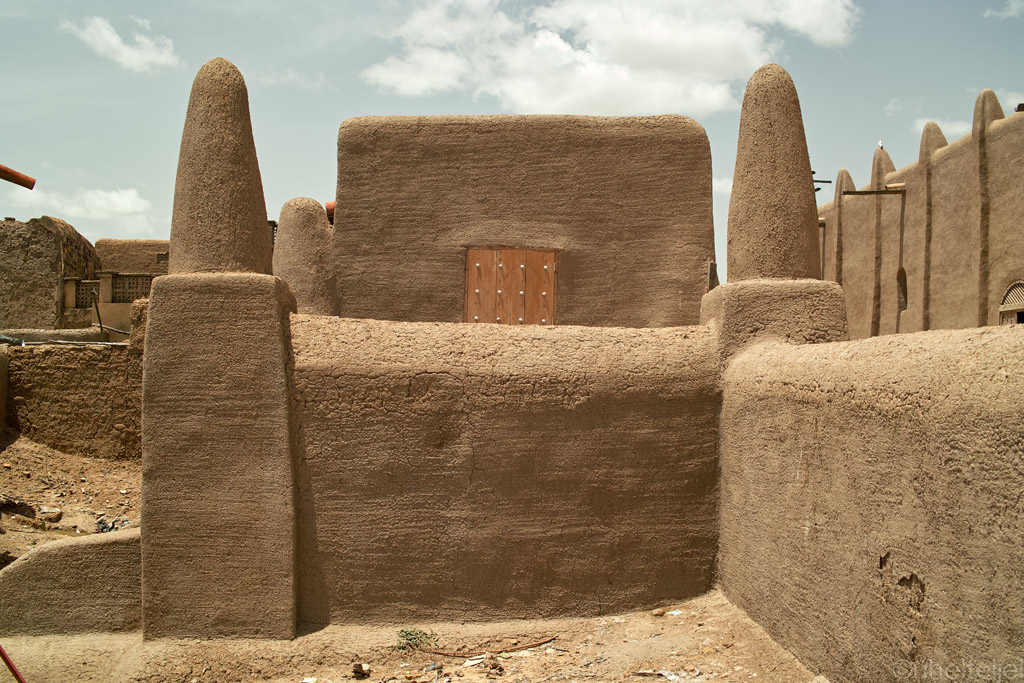
Nicely finished buildings.
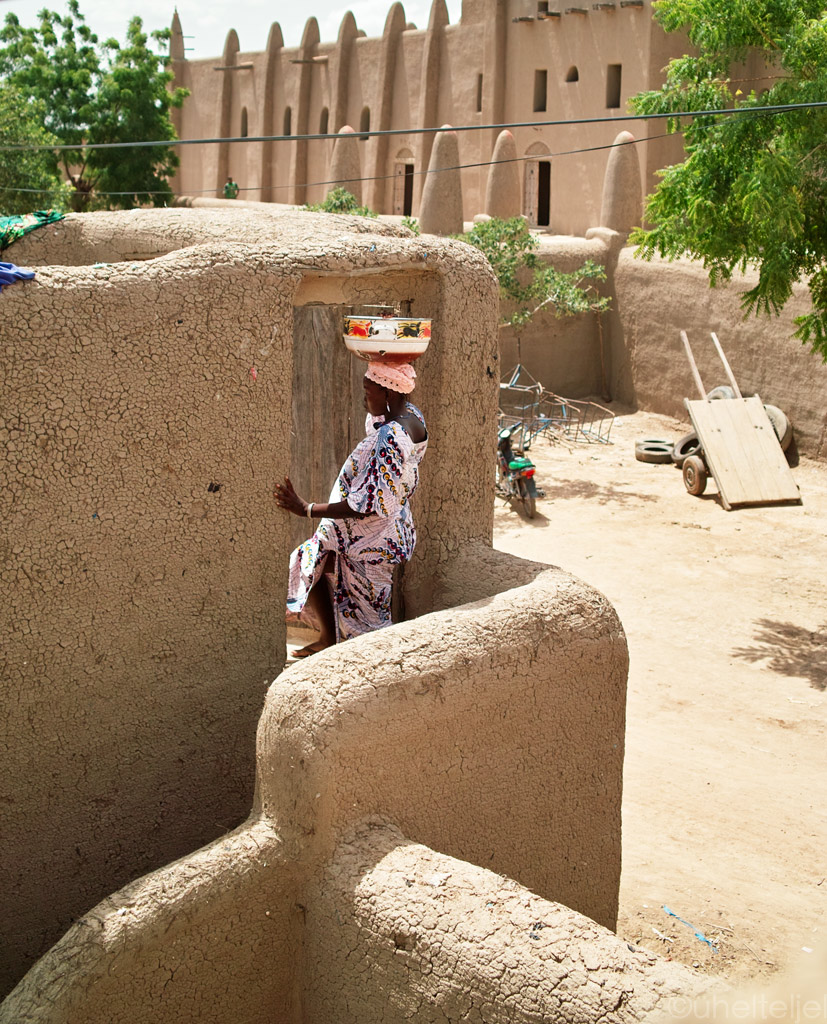
A lady going about her daily chores.
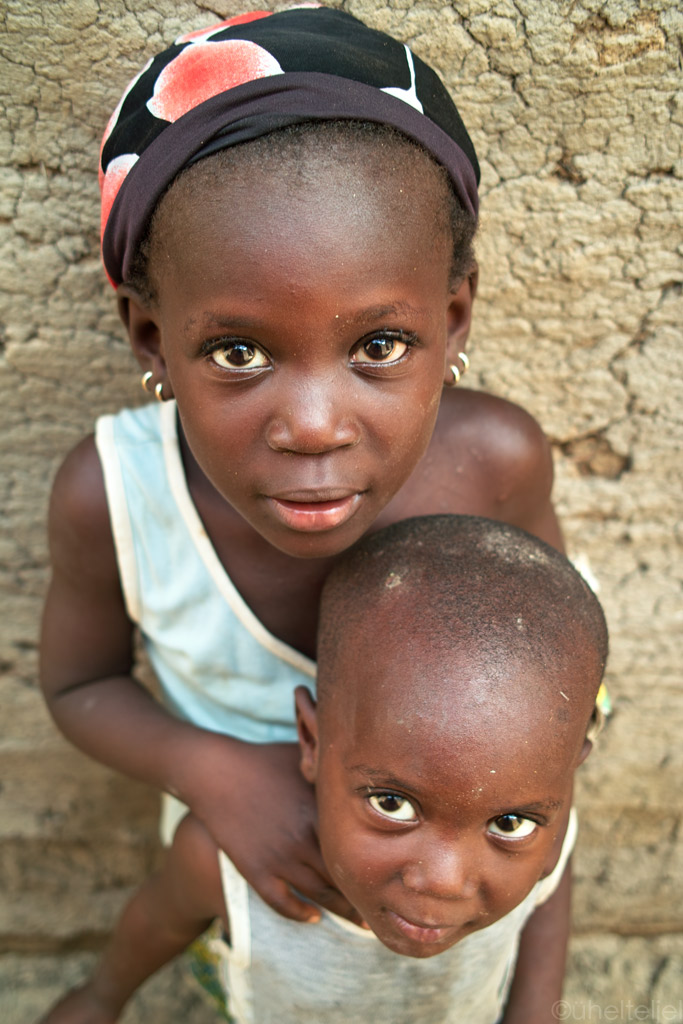
Kids.
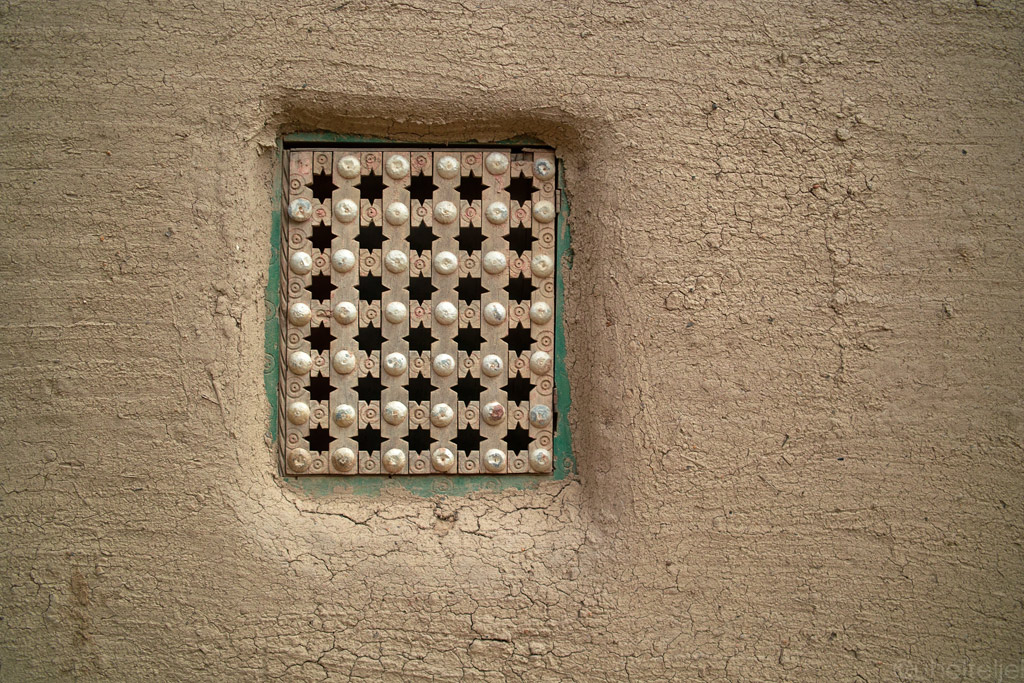
A window of the Imam's house.
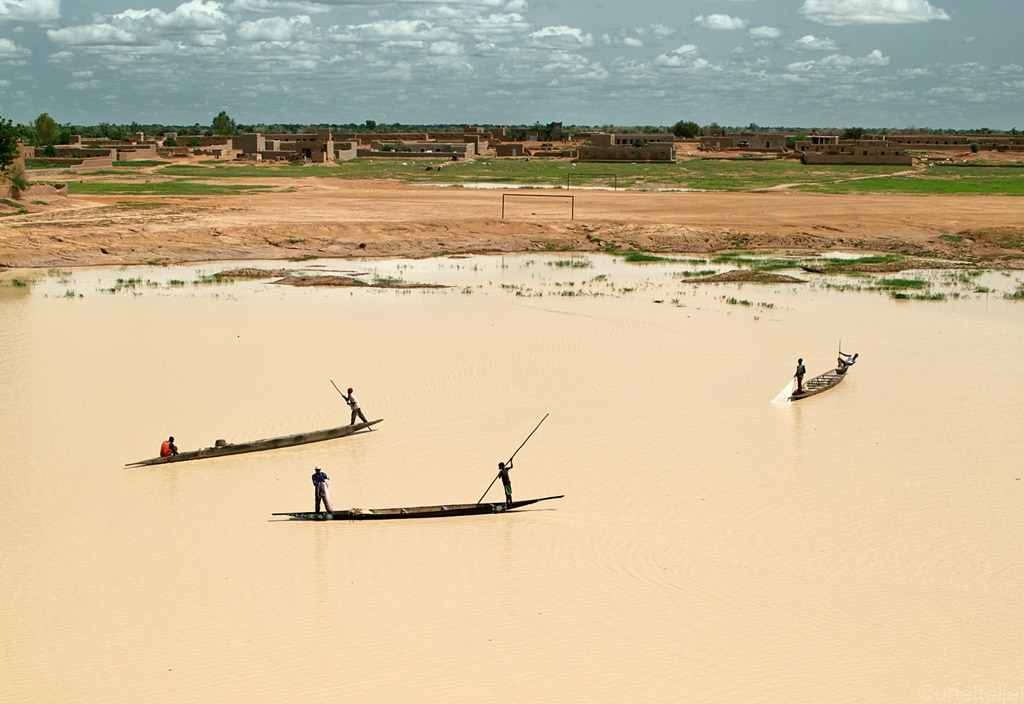
Fishing on the river.
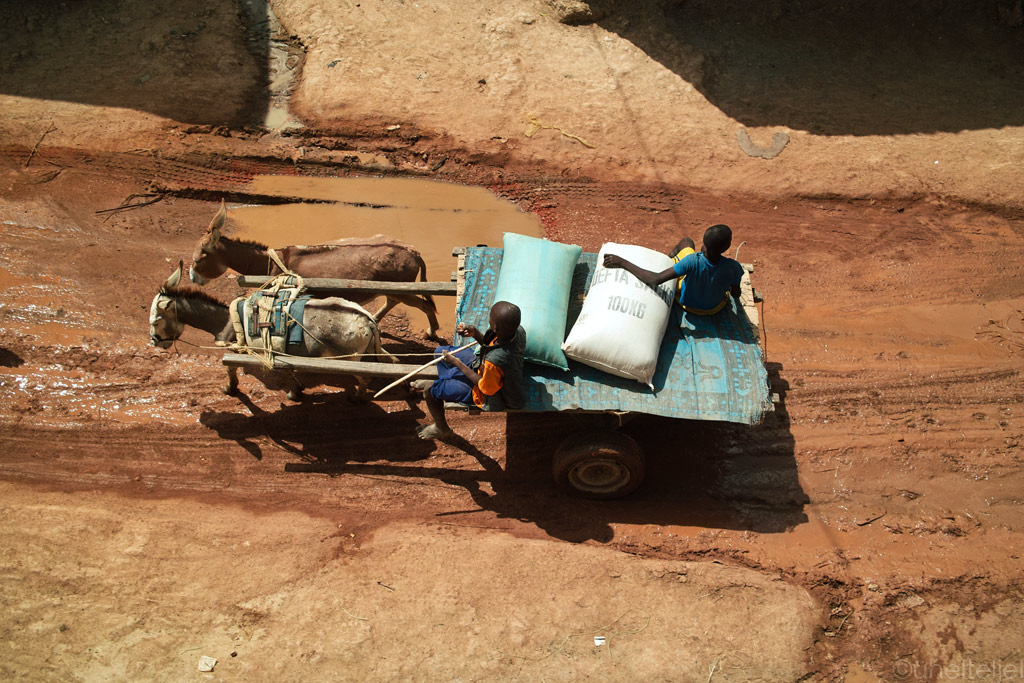
Donkeys are the main mode of transport.
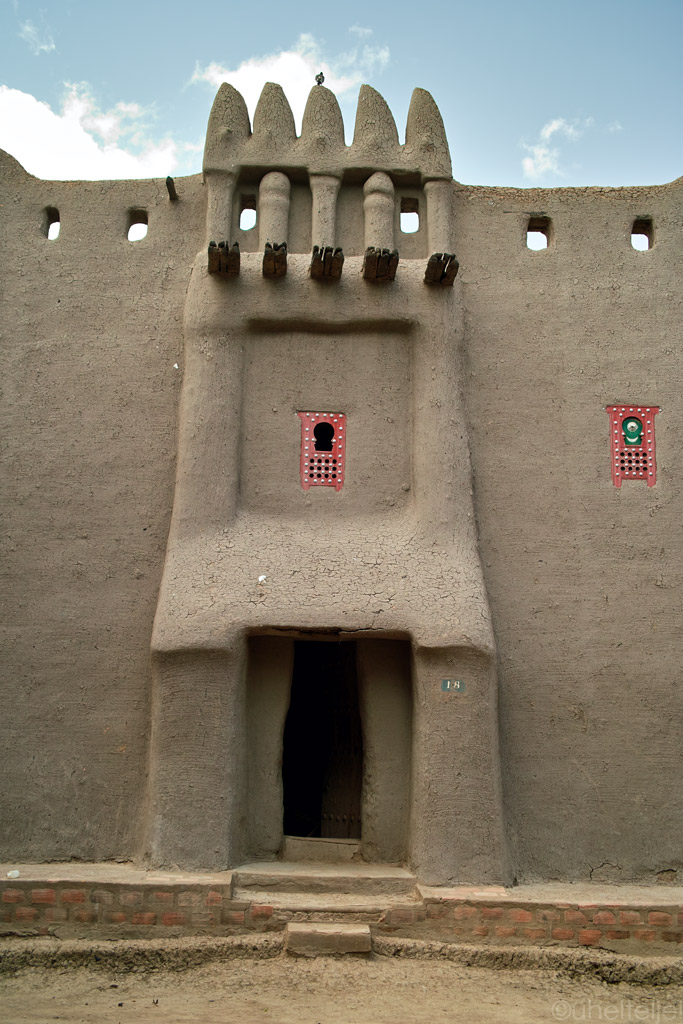
One of the most elaborate buildings in Djenné belongs to the chief.

A cosmic-looking cloud above Djenné bringing some rain for the night (click to enlarge).
Most tourists only go to Djenné, but quite frankly there is just as much, if not even more to see in its close proximity. The surrounding villages are, of course, built of the same mud, but the people are much more open, and once the first moments of distrust towards an intruder have passed, also much more hospitable.
For accompaniement, here's some down-to-earth Malian music as played from good-old cassettes - raw and natural, not spoiled by promotion and industrialization:
...::: LISTEN rare spiritual Mali live music from noisy old cassettes I :::...
...::: LISTEN rare spiritual Mali live music from noisy old cassettes II :::...
...::: LISTEN rare spiritual Mali live music from noisy old cassettes III :::...
So, while in Djenné we found ourselves a guide to take us into one of the nearby villages, and went there… in a horse cart. May sound like some overkill tourist experience, but in fact it is the most common way for locals to get around here, and since the cart lacked any suspension while most of the ride was a true offroad across rice paddies, it could not have been any more authentic. On the way to the village we met many other horse carts loaded with people, produce and animals going to the weekly market taking place in Djenné. I do not think women here enjoy shopping as much as their counterparts in the developed world.
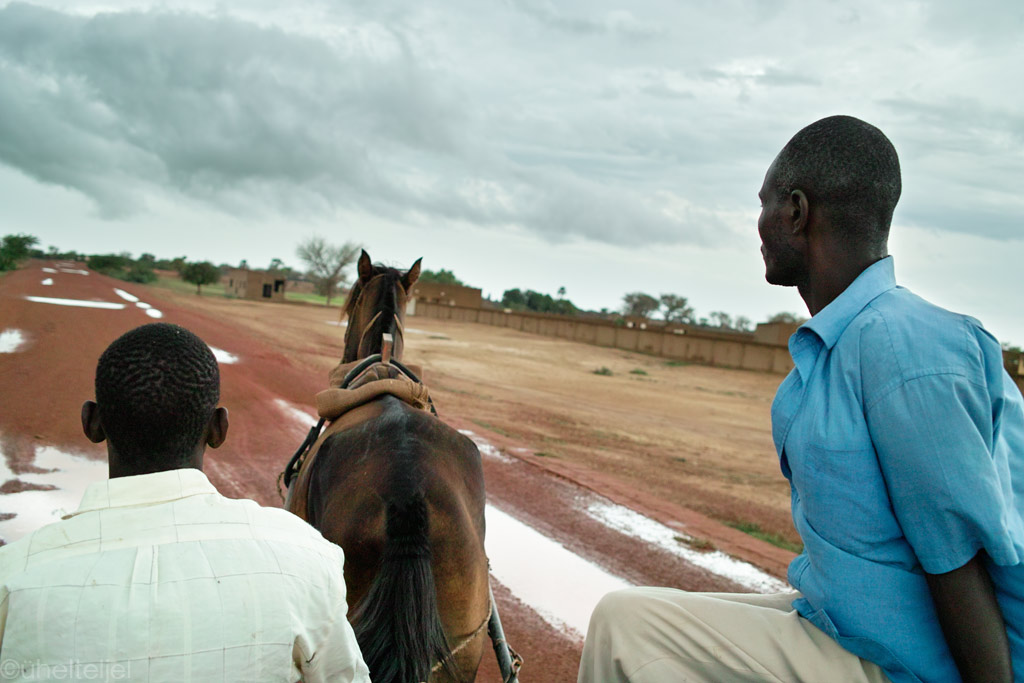
Our ride in a good old fashioned horse cart - a good "rest" for us after almost 100 000 miles on a motorcycle.
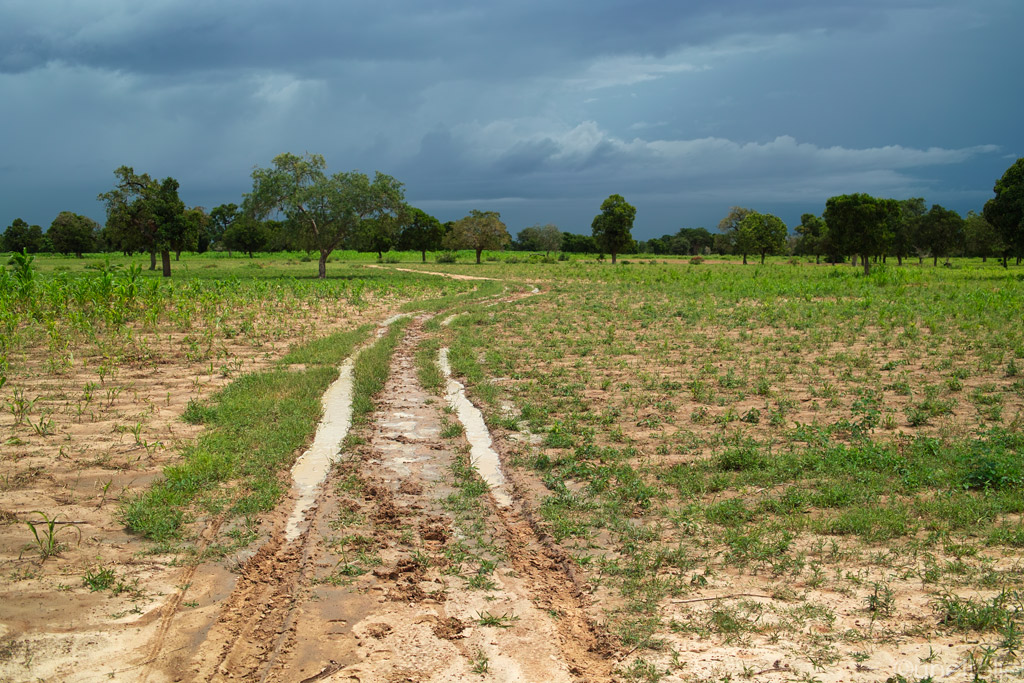
Horse cart tracks across the field - very decent scenery. Another good thing we discovered is you can actually look around 100% of the time and focus on your own internal thoughts in a horse cart rather than focus 100% while on riding the same muddy tracks through savanna - what a refreshing day it was! :lol3
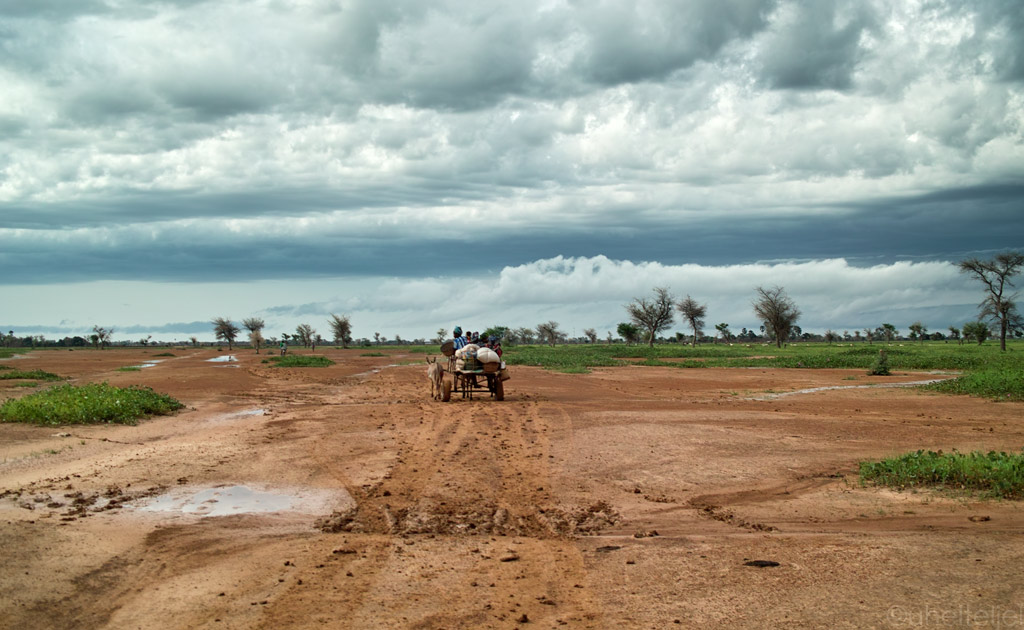
Heading to the market.
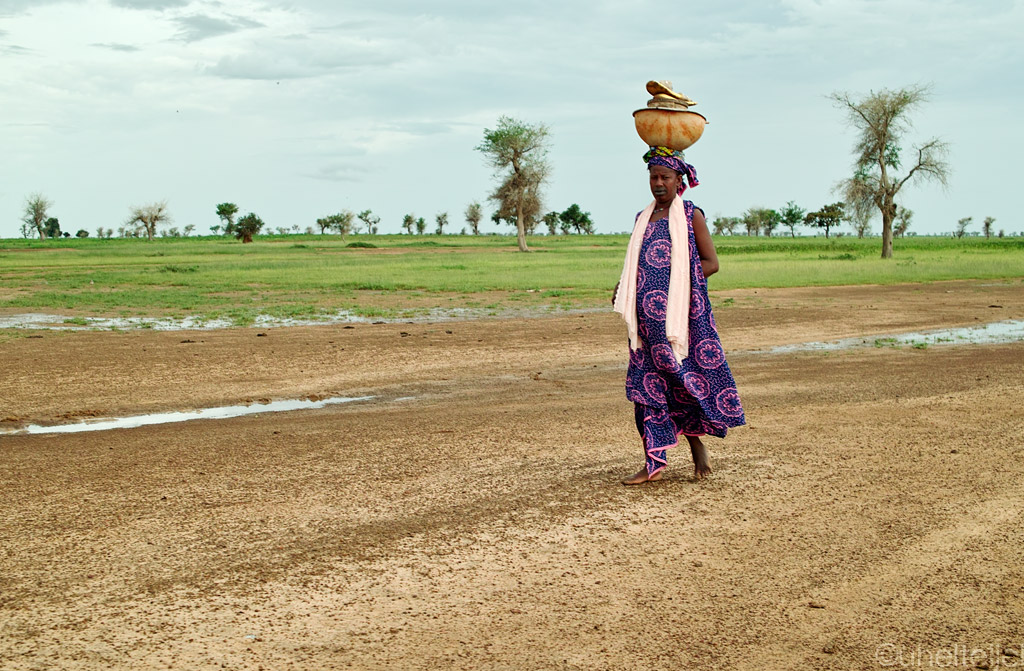
Some pedestrian traffic too. Notice the dark tattoo around the mouth - it is used as a sign that a woman is either engaged or married.
At the village, everybody was busy - doing laundry at the well, pounding grain, or doing something else. The everyday chores in a village are much more visible than in town where people tend to be more individualistic and anonymous, hiding themselves behind high walls.
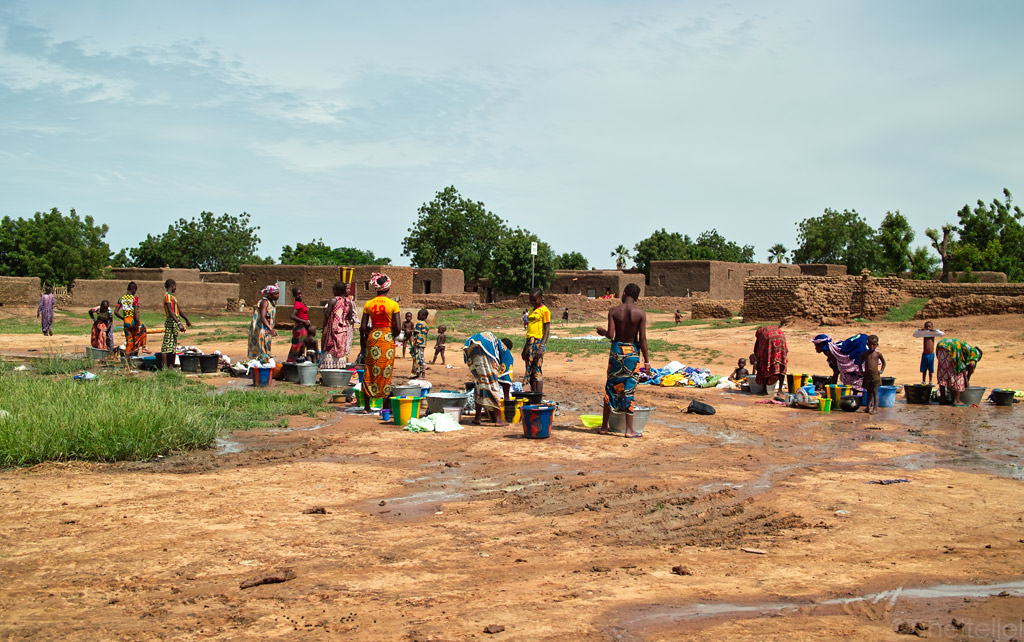
Colourful ladies doing laundry in front of the village we are about to visit.
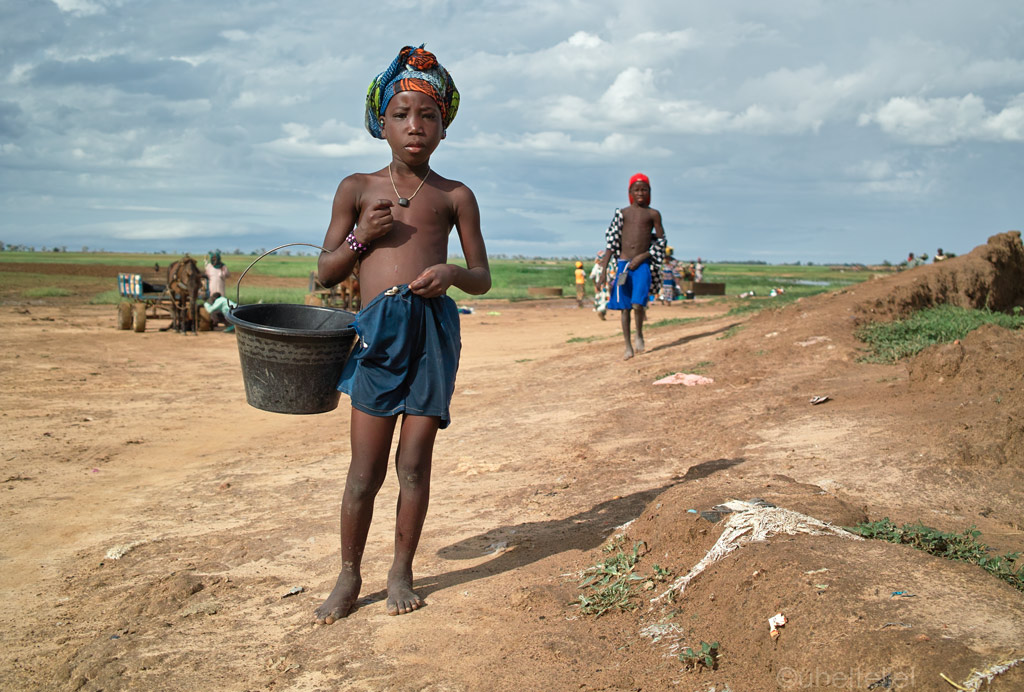
Kids are at work, too. In fact almost always.
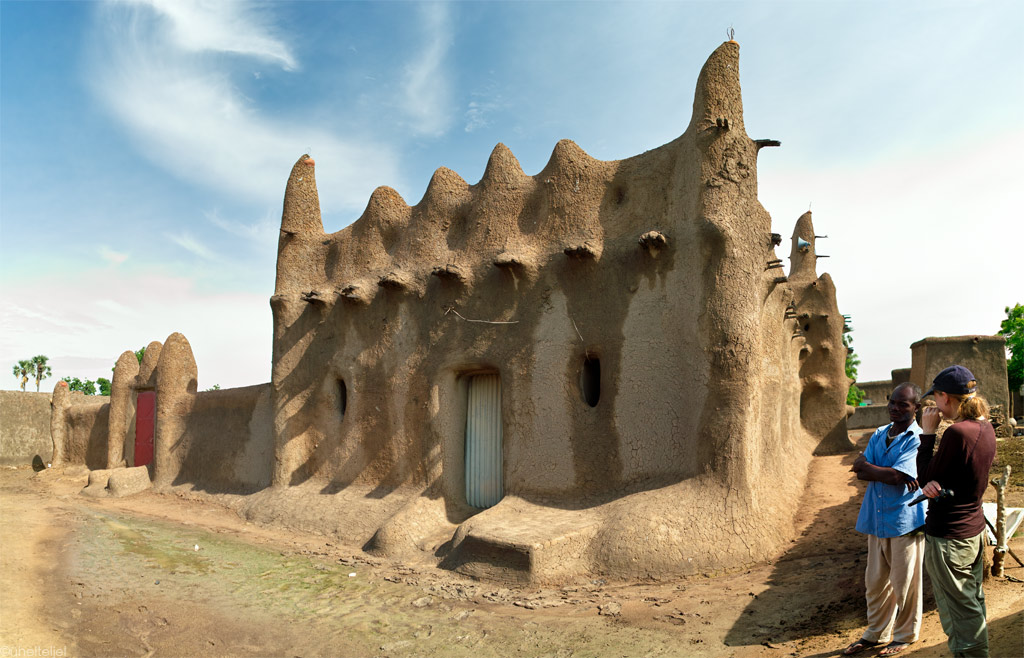
A mud mosque, still wet from the night's rain.
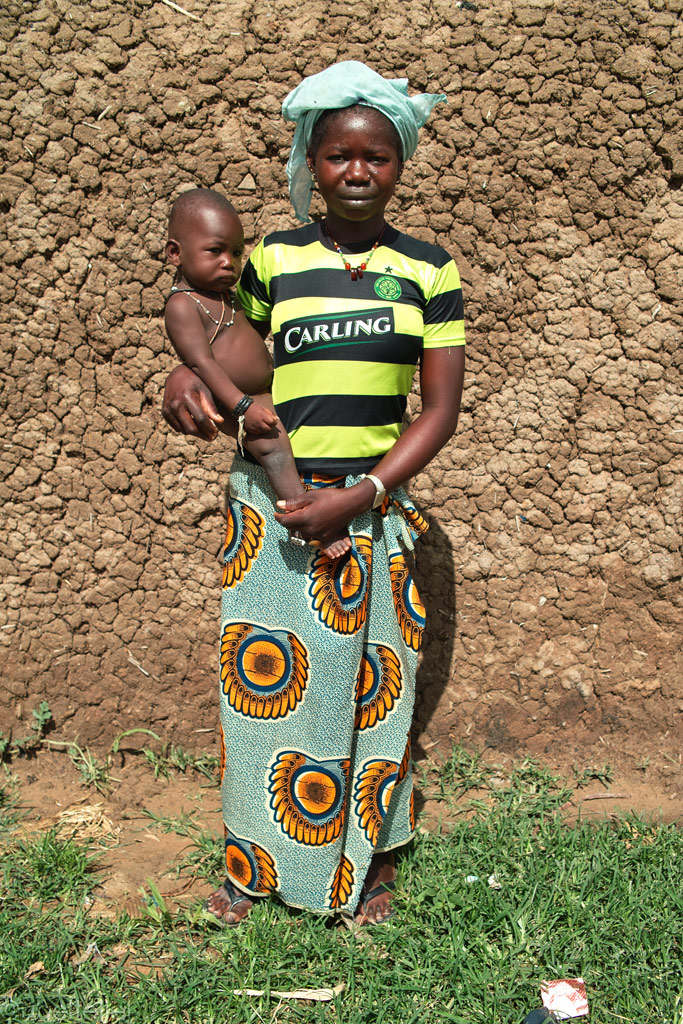
A young (married, hence the black spot around her mouth) mother with a child. The T-Shirt is probably from humanitarian aid.
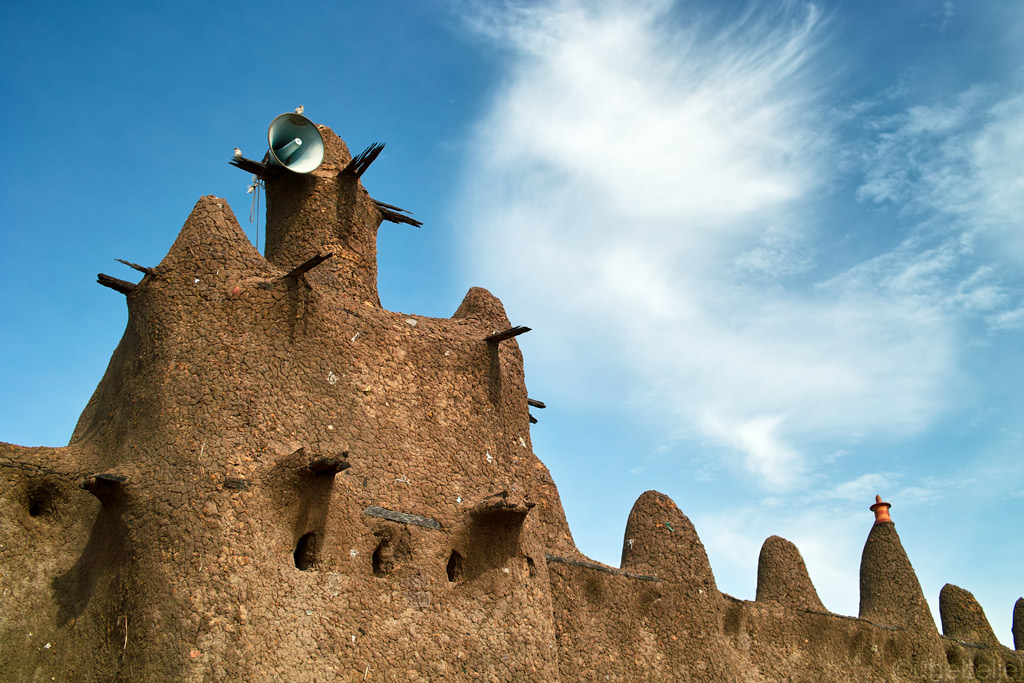
A minaret and a loudspeaker.
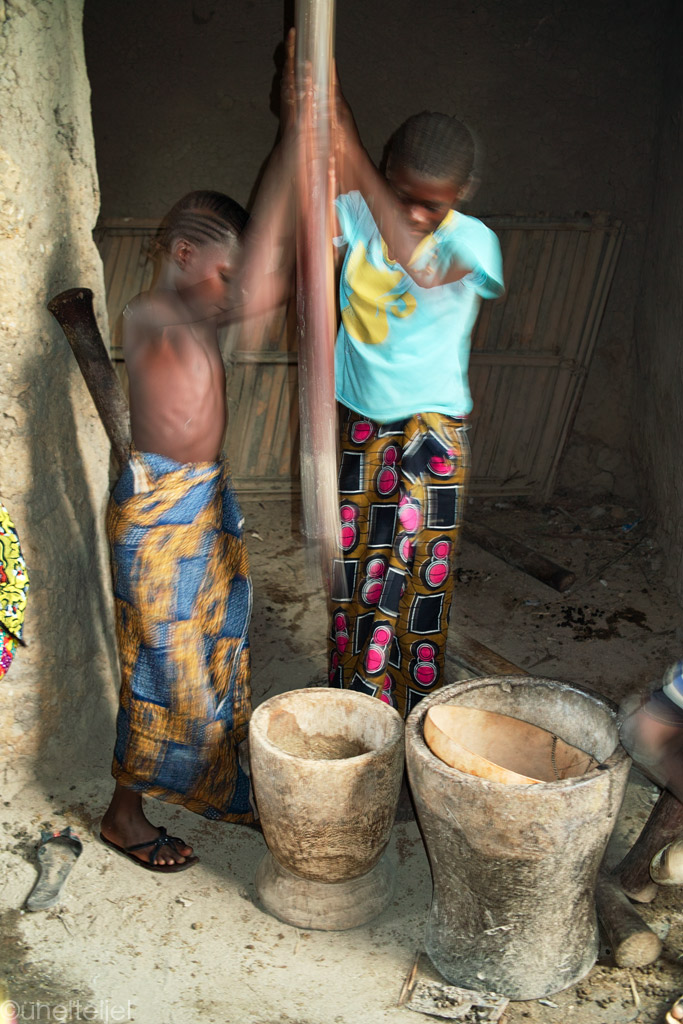
Pounding millet - a hard job it is and they have to do it every day.
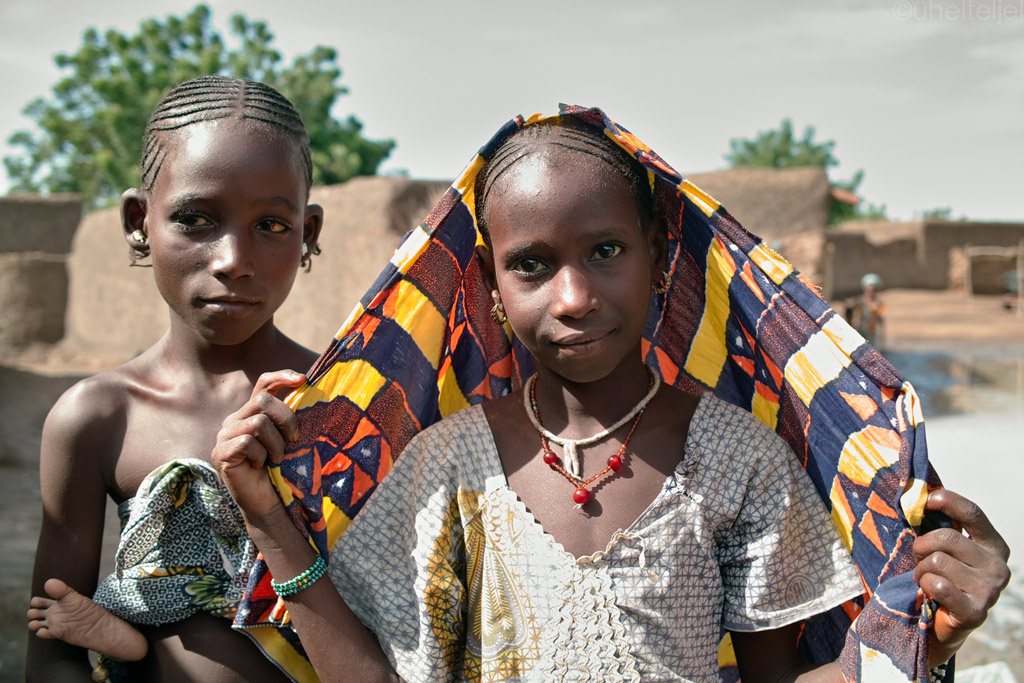
Malian girls (one carrying her younger sibling)
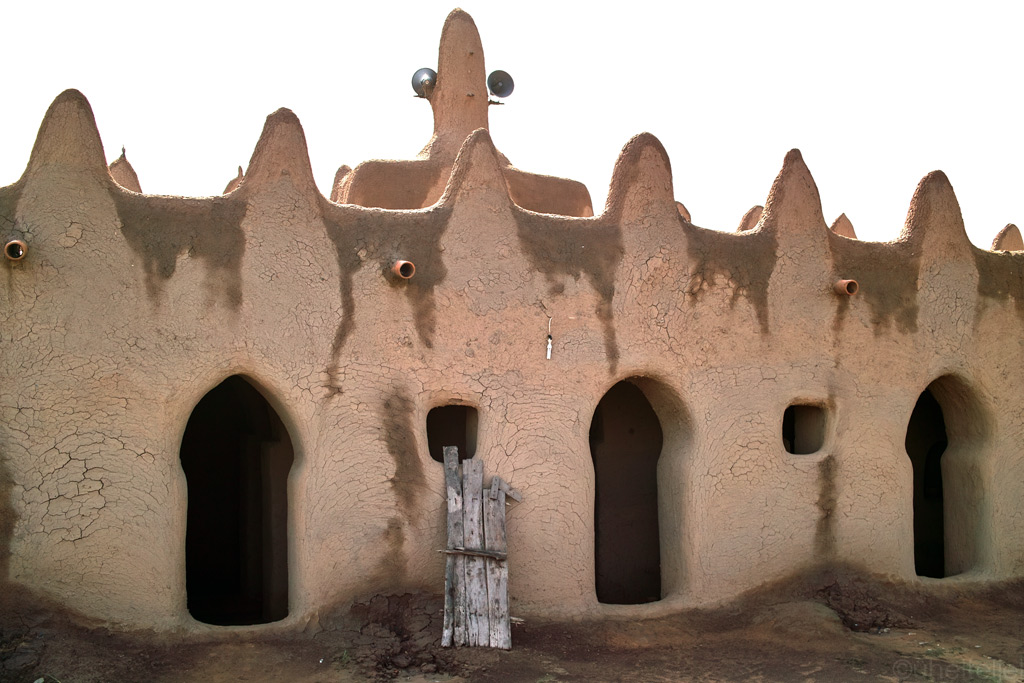
Another view of a mosque.
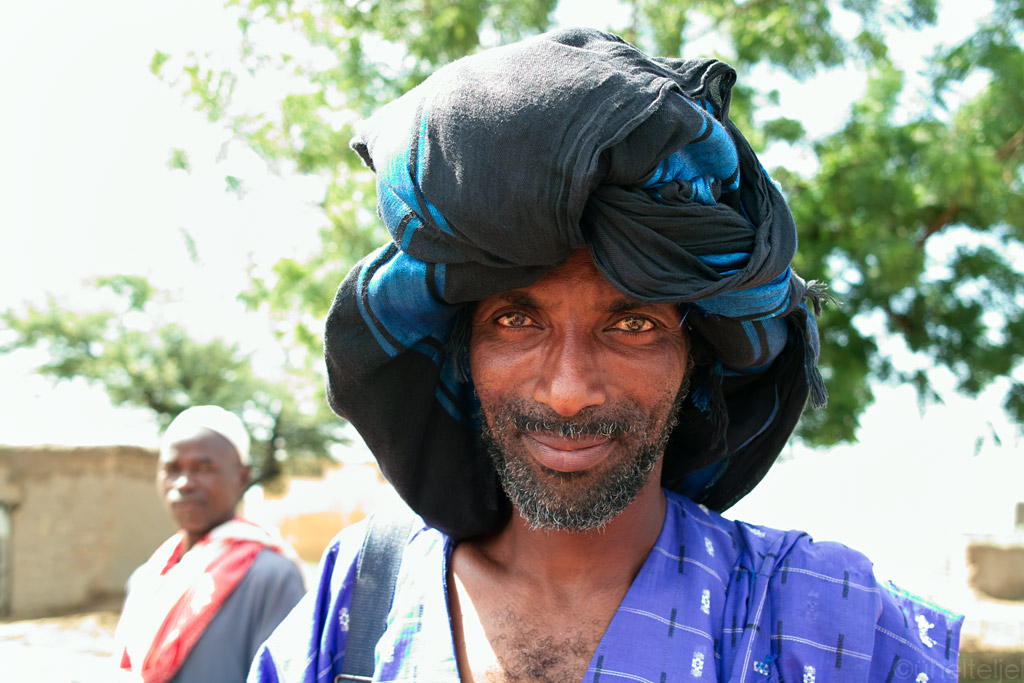
Malian man with obvious Arabic genes - many Arabs roamed through these areas during the high times of Timbuktu.
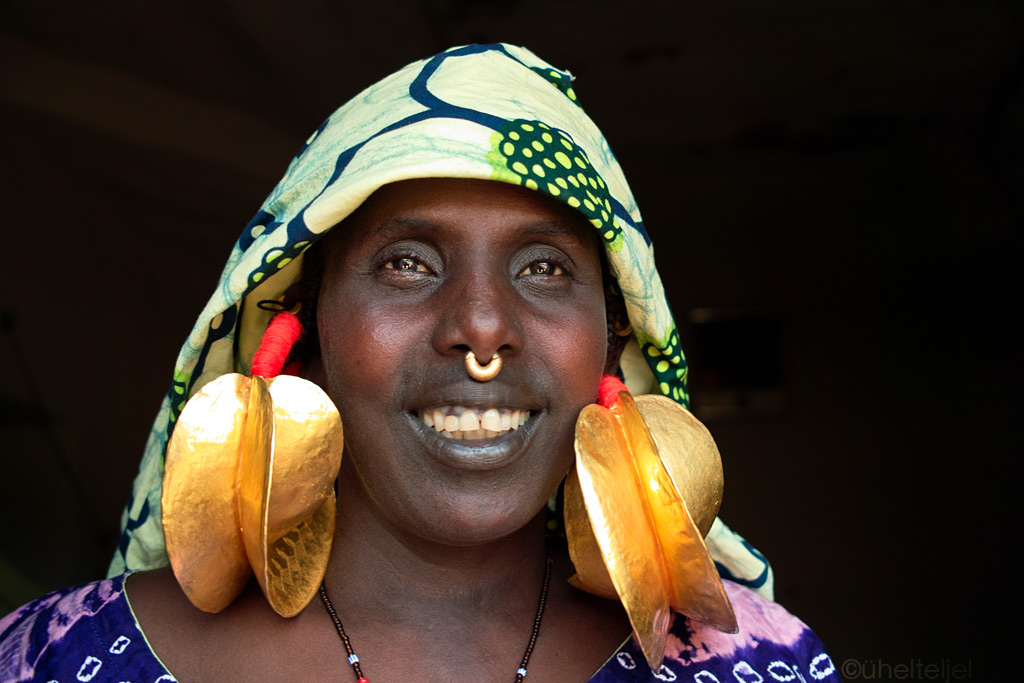
A lady with huge gold earrings that show her belonging to a certain group of people. A real african-mama!!!
In fact, Djenné and its surroundings are by far not the only place to enjoy the fascinating mud architecture of Mali - most of the villages near the River Niger represent the same style, but sadly not all of them are in such a good state of preservation, which becomes even more obvious during the rainy season.

A panorama from a random roadside village with a mosque standing in a pool of water (click to enlarge).
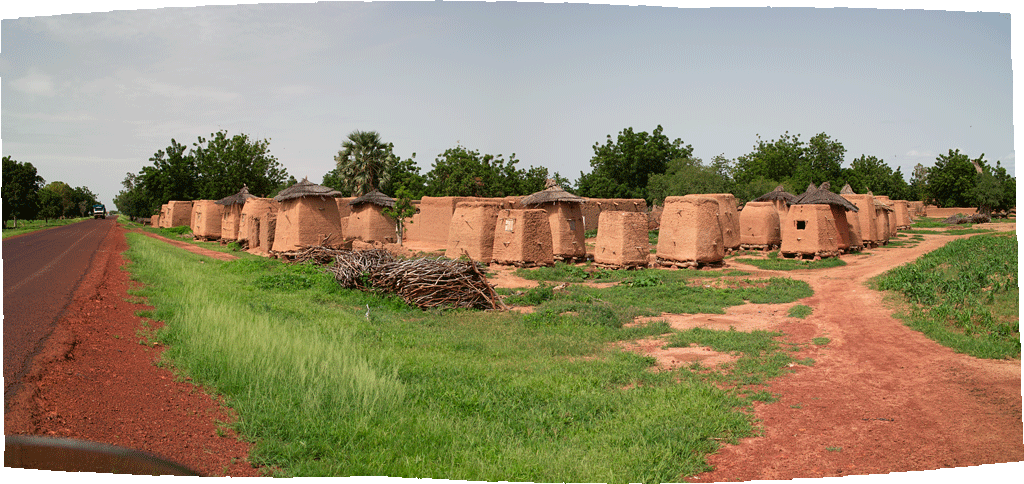
A roadside village surrounded with granaries (click to enlarge).
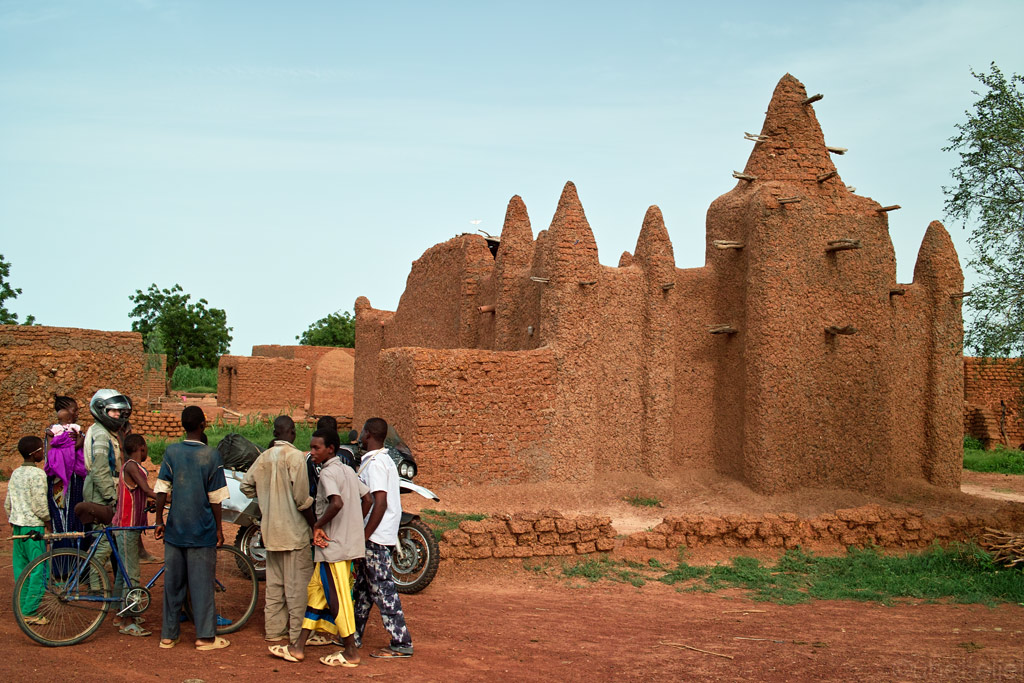
Another mud and stick mosque.

The wet season in force - normally it would be all dry Saharan type of environment - we've obviously come on a very special time.
In Mali, most of the sightseeing in concentrated in the eastern part of the country, so as we left Djenné and headed west it was a long and uneventful ride all the way to Bamako.
We passed some more mud villages and got some rain. We haven't really used our rain gear too much, even though we've passed some regions in the middle of respective rainy seasons - mostly it is either just a light rain or a strong rain that passes quickly, so we are just too lazy to get the gear out and put it on - and in tropical climates it very quickly becomes uncomfortably hot and damp in it. I expect the rain gear will be very useful when riding back through autumnal Europe - not just for the rain, but for the cold as well.
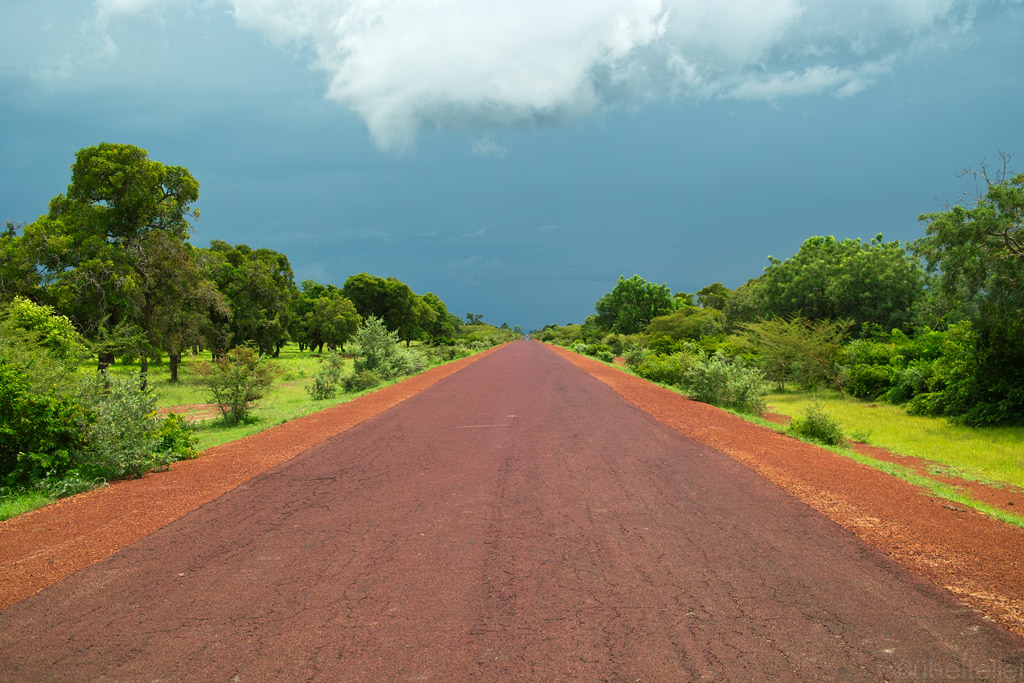
Nice tar in the direction to Bamako, but the clouds are sure to spare some rain - which they did.

Panorama of the flooded Bani river with tropical downpours on the background (click to enlarge)
In Bamako we rolled into The Sleeping Camel - a place not metioned in the Lonely Planet but well known among overlanders. There, another biker was already waiting for us - a German guy Martin on his Yamaha 660 Ténéré going around Africa whom we had met both in Nairobi and Cape Town. Later on a frenchman called Julien joined us on his brand new Yamaha 1200 Super Ténéré in the very beginning of his three-year RTW. We felt a little envious towards him as he still has everything ahead of him. Then, Henry rolled in - a South-African on a F650GS Dakar going up the West Coast whom we'd met in Djenné, then our friend, a Portuguese called Goncalo on his R1100GS travelling around Africa. Last but not least, two more French on a side car Ural - Hubert and Jean-Paul. Hubert has been on the road for seven years already and plans to travel for three years more.
What a syrreal coincidence to have so many bikers at one place! The only biker we'd met on our way up the West Coast was a Swiss guy Laurent on a F800GS, and it was back in Brazzaville, so quite a while ago. You can only imagine how many stories were told.
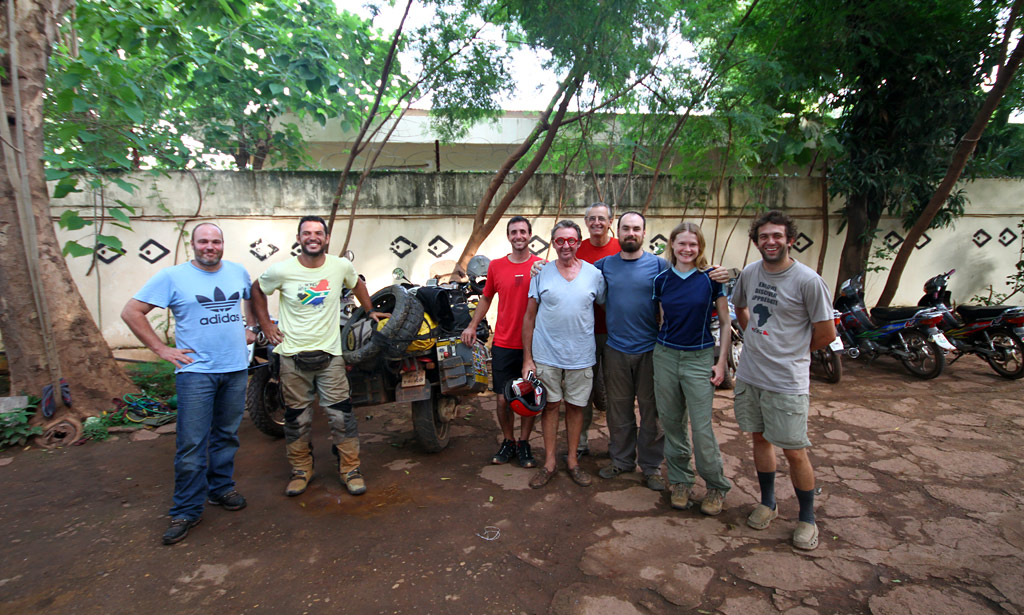
The whole bunch - (from the left) Martin, Goncalo, Julien, Hubert, Jean-Paul, Margus, Kariina and Henry (a pic from Martin's camera, shot by a Slovenian trucker)
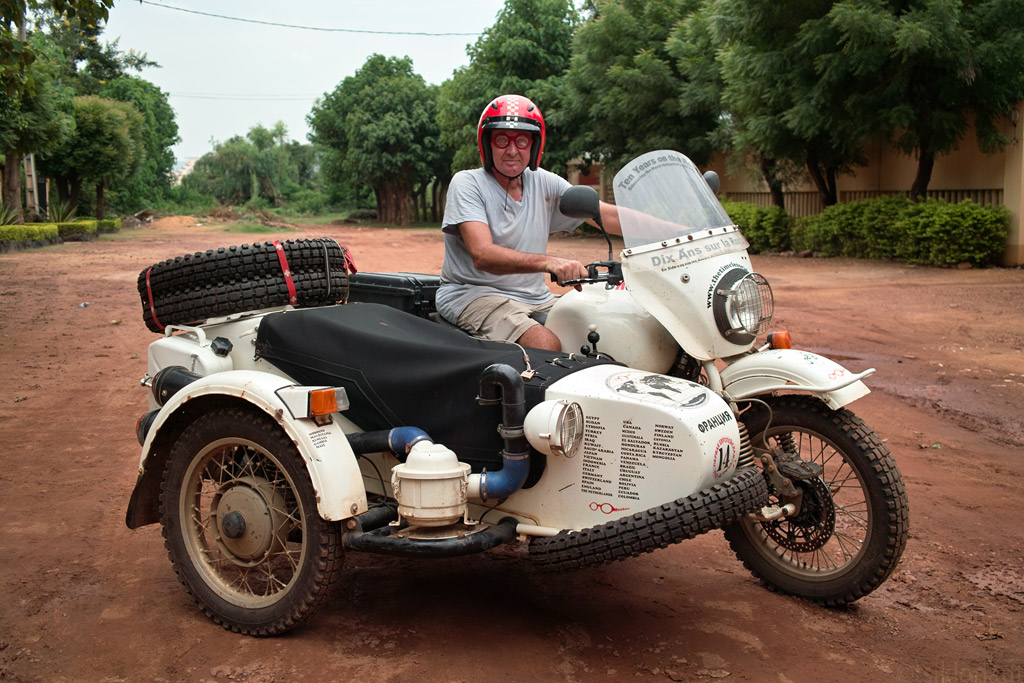
Hubert Kriegel with his Ural side car.
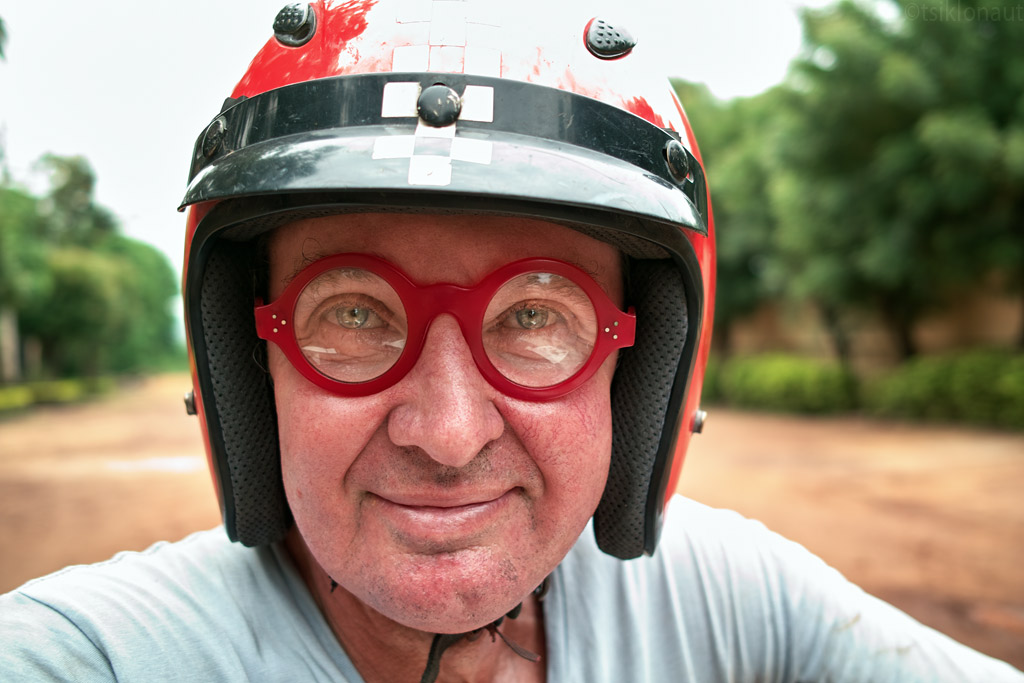
Portrait of Hubert with his cool glasses.
Since while in Mali we had heard so much good music we could not help but to go looking for some live music while in the capital. "Zero" is a kind of place where expats come together to have a bottle of beer accompanied by some live music from a not-so-professional band, whereas "Diplomat" is the kind of place where the well-dressed elite come to listen and dance to some more professional music.
...::: LISTEN live band in Bamako :::...
PS: the drummer was so drunk that he couln't even walk - yet the "biological metronom" in his brain still worked precise. Look it as you like, but excellent sense of rhythm is built-in the genes for the native black Africans!
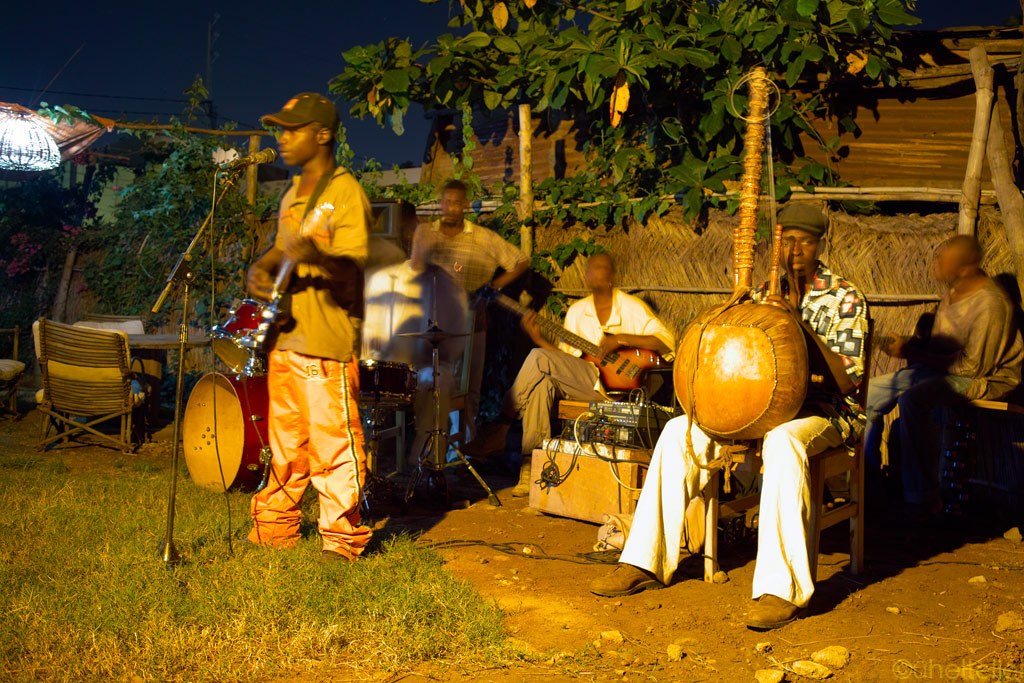
The same jamming band at "Zero", Bamako.
...::: LISTEN another live from Bamako's legendary Diplomat club :::...
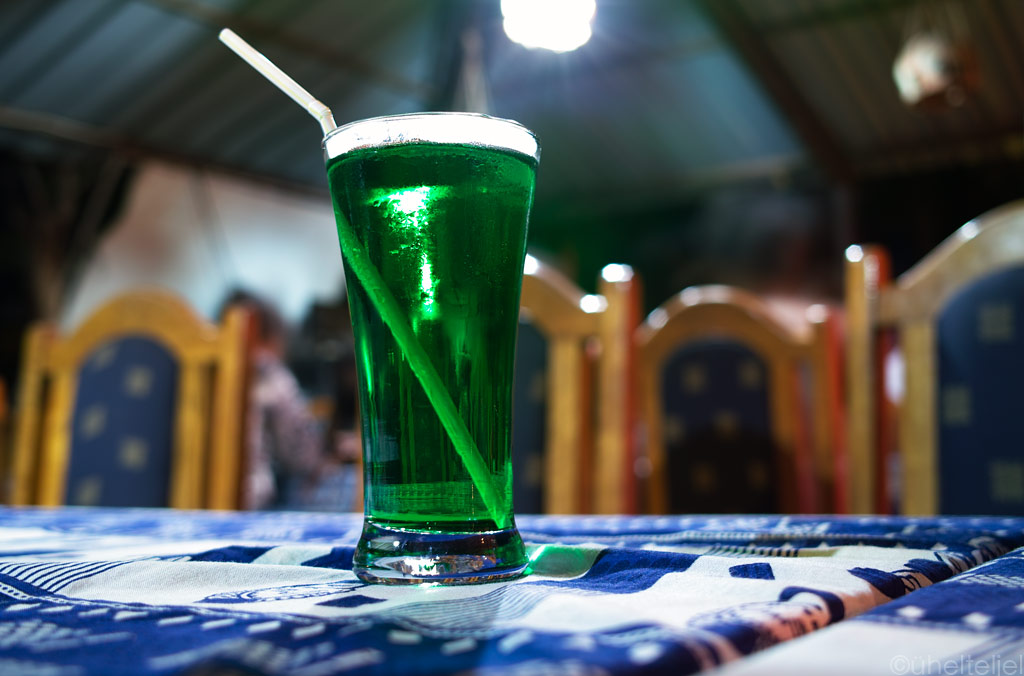
Mint syrup - does not look bad!
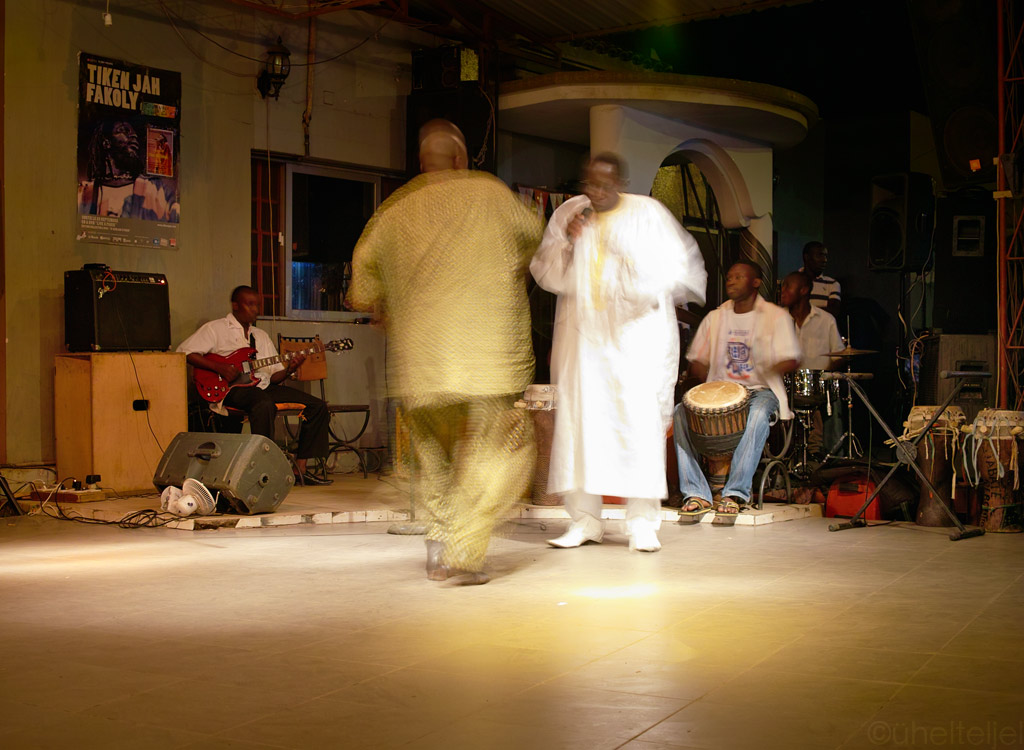
Same-moment-as-above-sound live performance at "Diplomat" - one dancer too in front of the singer.
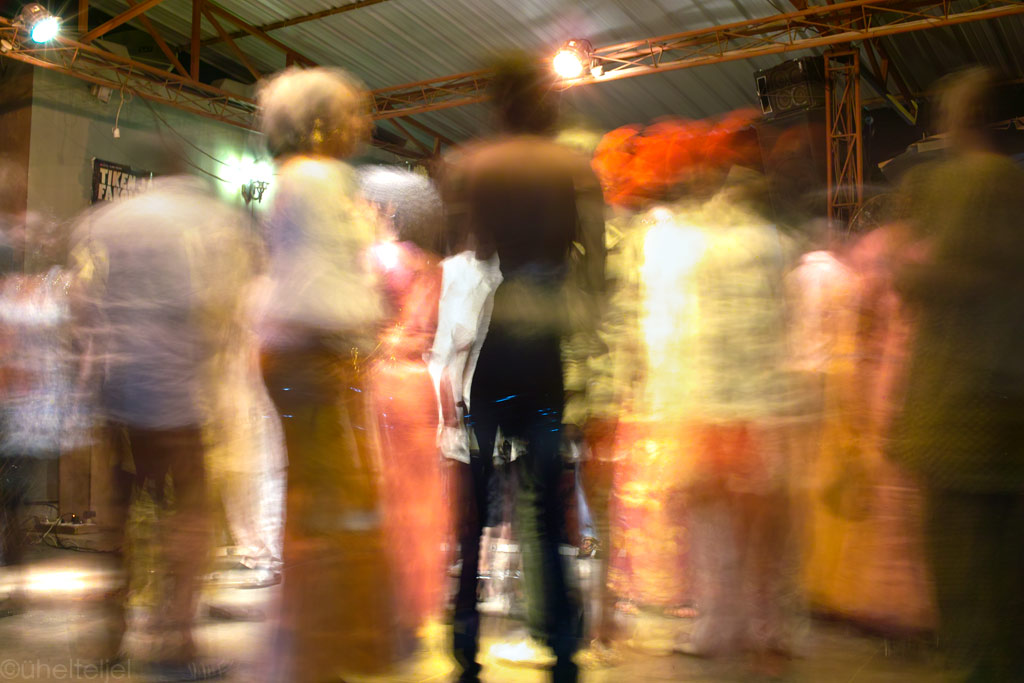
Soon all the floor was filled with crowd - the bold and the beautiful dancing.
Inbetween of the entertainment and the social life, we paid a visit to the Mauritanian embassy in order to apply for a visa (for the last time on this expedition!). Of course, they had just changed the visa regulations and we were told that visas are no longer issued on the same day and that we'd have to wait for 7-10 days for our applications to be processed. Great! We were told that we might have more luck at the Mauritanian embassy in Senegal, so although Senegal was not in our plans, we headed to the Senegalese embassy. Estonia is one of the few EU countries whose citizens need a visa to enter Senegal. What do you think, we were told that it takes 2-3 months to process a visa for Estonians! So Senegal had to remain off our route and our only hope was that Mauritania would definitely give us a visa - otherwise we'd be landlocked in Mali, and the only reasonablish option to go back home would be through the tricky North-Niger and with an expensive escort through Algeria. I do not think our Ministry of Foreign Affairs would have been impressed.
We went back to the Mauritanian embassy, explaining our situation, and after a lot of pleading and begging, after a consultation woth the bosses in Nouakchott, they issued us a visa the same day. It was only a three-day transit visa, but better than nothing.
But then, as we were ready to leave Bamako, I suddenly developed a cough and a fever that went well beyond +38 C (+100 F). We used one of malaria self-tests that we'd been carrying, but it showed negative. The next day, as the fever was not receding, we went to see a doctor. I was prescribed antibiotics and a cough syrup, since because we have been taking Lariam, malaria was not very likely, but just in case, a blood test was ordered. Later, when the test results arrived, I was still diagnosed with malaria and prescribed some more dope. So much of our prophylactics and contaminating the bodies with antimalarials!
In total there was quite a heap of medicines I had to take, which definitely killed the plasmodium falciparum, reduced the fever and cured the cough, but left me with a deep feeling of hangover lasting for days.
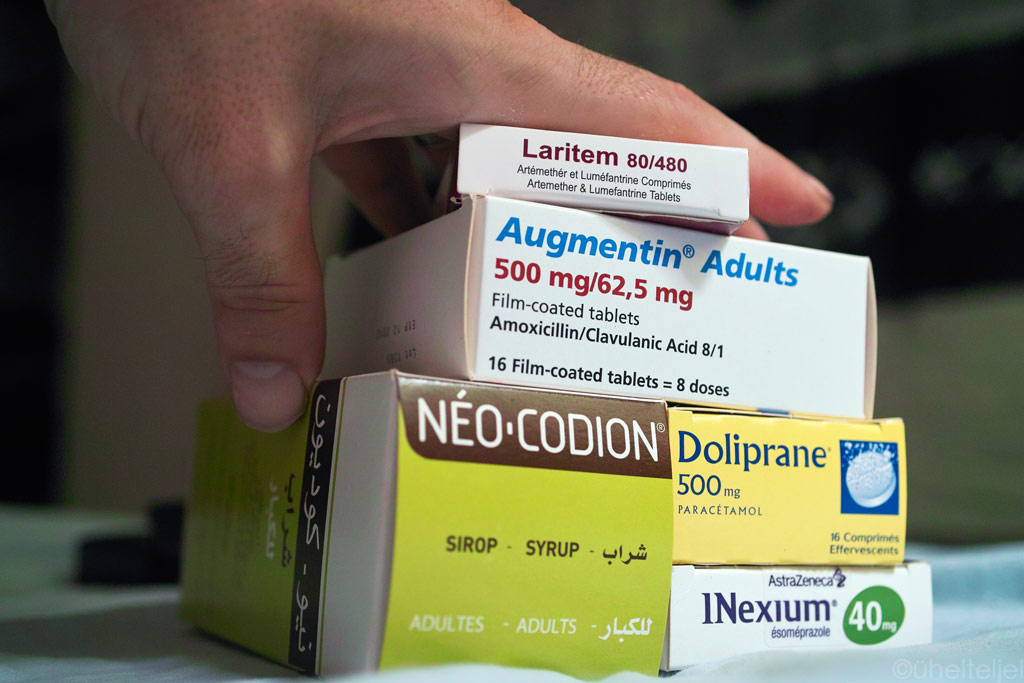
Candy shop.
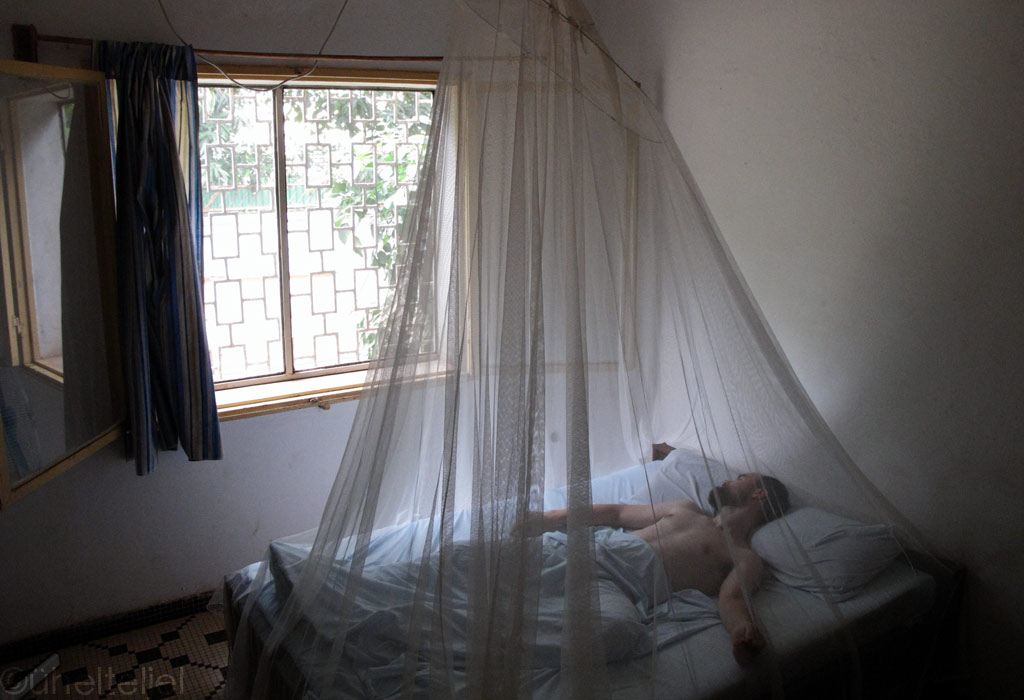
In malaria and doped up.
M&K
Already the bordercrossing was so fast and efficient that we immediately liked the contry. Not that we'd really had problems with border crossings in the rest of Africa (except for the DRC, of course), but it very often takes quite a lot of time for them to copy all the details from our passports an bike documents to their annals. Here, on the opposite, it was five minutes and we were free to hit the road.
In fact, the roads in Burkina Faso are in a very condition, probably due to the fact that it is one of the poorest contries in the world and the roads do not get so much beating - most of the transport here happens on donkeys and scooters. Even in Ouagadougou, the capital, it is far from rare to see people going around on dokneys or horses, which actually fit quite well into the oversized village (which is what most of African cities seem to be) setting.
But the poverty is not only evident in the modes of transport that people use, but also in the constant begging for cadeaux, or gifts. There is no doubt that it is tourists that have contributed to the situation where you barely are able to go somewhere without kids approaching you with "Le blanc, donne-moi cinq cent francs!" ("White guy, give me five hundred francs!"), or to take out the camera just to hear "Si tu prends la photo, tu me donnes un cadeau!" ("If you take a photo, you must give me a present!". By the way, those 500 CFA equal no less than one dollar and ten cents. Quite ambitious those people, I must say, and quite annoying too.
Allright, let's get back to that positive impression again. The people are actually fery friendly, if shy, and do noy try to overcharge you any way they can. For example the going rate for a bike wash in Ouagaougou is 500 CFA. The guys spent a whole half an hour massaging our GS, while for the "pressure wash", water had to be carried in buckets into a big barrel from which it was pumped with the help of a generator. Looking at the amount of work it all required we paid a little bit more, and the guys were so abashed they must have been blushing

Burkinabe pressure wash. It is interesting that they also like to wash the tyres, although it is almost impossible to leave the place without the tyres becoming just as muddy as they were before.
While in Ouagadougou we applied for the visas for Mali, the next country on our trajectory. The process was fast and painless and cost something like 45 USD per person. Then we moved on, towards the town of Bobo-Dioulasso, seeing on the way what the rainy season really means - there is water everywhere.

A park in Ouagadougou, totally inundated.

But the wet season also means everyhing is green!

It is wet indeed.

Too much water.

Kids playing with the current - in the dry season it must be no more than a trickle.
But back to Bobo-Dioulasso, the second biggest town in Burkina Faso. Well, it does not feel big at all, rather quite a sedate place, with muddy (in the dry season probably dusty) streets, a bustling market, and the main reason for tourists to come here - mud and stick mosque dating back to the 19th century, a sparkling example of the Sudanese-Sahelian architecture. It is not very big, but the design is like from another world - like from outer space! Those sticks bear multiple functions, one of them being to support ladders used to climb up to repaint the mosque after every rainy season - otherwise it just would not last for so long!
Some spiritual stuff from the local radio to accompany the viewing pleasure:
...::: LISTEN Bobo's local radio playing spiritual African music I :::...
...::: LISTEN Bobo's local radio playing spiritual African music II :::...
...::: LISTEN Bobo's local radio playing spiritual African music III :::...

Out of this world!

The Grand Mosque of Bobo-Dioulasso.

Up close.

A Muslim man of Bobo.

Is it made from marshmallow?

On the inside. More than four hundred devotees fit it here to pray.

Does not really look too grand from the inside.

Some humanitarian aid being distributed on the street.

Life on the street - the girls rushed to us in the hope of selling us a handful of dried caterpillars - Bobo's local delicacy.

Who said life revolves around a mosque?

Life around the market.

Motorcycle seller.

A colourful Bobo lad.

A woman in front of her stall.

Men rushing to a Friday prayer, woman with her moving stall of mangoes.

A Muslim man selling tea and Qurans on the side of the road.
All in all, Burkina Faso turned out to be a place worthy of some more exploration, not just whizzing through, and we hope it will set a good example for the countries to come - not just suffering and hard times, but some reward too!
Then came Mali...
In Mopti the air was hot and humid, as if the breath of the Sahara had clashed with the moisture rising from the river, and where ever we stopped we were immediately surrounded by a crowd, including some persistent tour agents willing to give us "the best price" for a ride down to Timbuktu, or to lead us to "the best hotel" in Mopti. We had just arrived, and we already felt like getting out of there as soon as we could, and forgetting about Timbuktu.
To accompany the pics from around the river port in Mopti, here's some music from the local radio:
...::: Listen Mopti local radio playing Mali music I :::...
...::: Listen Mopti local radio playing Mali music II :::...

A panorama from the river port in Mopti (click to enlarge panoramas)

A local.

Girls selling melons.

A bread seller.

A Muslim man on a bike.

Ladies carrying linen freshly washed in the river.

An African lady on the backdrop of the river.

Selling freshly baked bread.

Rolling down the road.

A Touareg wrapped in a cloth.

The young generation.

African lady.

A Mopti Muslim.
As we try not to give in to the first impressions and rather let them settle overnight, we ended up staying at one of "the best hotels", i.e. on the roof of a hotel. Since it was located right in the centre of the town, we got to experience to full extent the sounds of all the nocturnal goings-on, the tortured cry of a muezzin awaiting the end of the Ramadan, and the terribly thirsty whine of malaria mosquitoes outside the tent. But what was even worse - the roof had absorbed so much heat during the day that we felt like on a stove top, drowning in our sweat all night. Even in the morning, the thermometer showed +36 C (+97 F) in the tent, so at night it must have been around at least +40 C (+104 F). No sleep that night.

Camping on the rooftop - but no sleep!
...::: LISTEN Mopti's ambient sound during night after ramadan :::...

Night time view from our camping spot - notice the minarets of Mopti's mudbrick mosque on the background.
By morning we had decided: Timbuktu is off! To try and survive in similar conditions for three days on a boat, or to break another suspension bolt going down the bad road and wait for assistance in the +47 C (+117 F) heat - it was not worth it. If we had been here in January instead…
In the morning light, we made another ride through Mopti, and as it was early enough, the people were just waking up and we could have a more relaxed look around.

A mosaic of Mopti's mud brick mosque in the morning light.

Morning in the old town of Mopti.

Goats roaming the streets.

The Mopti's riverside panorama - notice the piles of garbage. (click to enlarge)

Roadside view (click to enlarge).
Djenné, which actually used to be of an even greater importance than Timbuktu, boasts the largest mud building in the whole world - a mosque dating back to the beginning of the last century, which is also one of the main tourist attractions in Mali. But contrary to the over hyped Timbuktu, Djenné is easily accessible, and because there really hadn't been too much to see in West Africa, we had grown a little thirsty of culture, architecture and history. So we decided to go and check it out.
Since Djenné is located on a flood plain between two rivers - Bani and Niger, every year after the rains it becomes locked in, and is only accessible by boat. The water levels are at their maximum around October.

A pirogue on Bani river.
To get across, there is a ferry, but the time interval between its comings and goings is pretty unpredictable. When we arrived at the river, the ferry was being loaded on the other side. One hour later it still hadn't moved. Meanwhile, the sun was blazing and we could not help but to think that even if the ferry was to come across it would probably take at least another hour before it would move. So when we were offered to take a ride in a motorized pirogue that we'd seen going back and forth across the river many a time, we agreed on the price and before we knew, the GS was already being lifted into the pirogue with the help of some ten guys. A few minutes later and we were already on the other side, the ten guys, knee-deep in the murky water, trying to lift the bike off the boat. Looking at how smooth it all was, and judging by the very pleased look on the face of our boatman as we handed over the cash, the 5000 CFA that we'd agreed upon felt like too much (the ferry would have cost 2500 CFA), although if we compare it to the 10000 CFA that we had had to pay after dead heavy bargaining for the bike to be loaded onto the Calabar ferry (which did not require the force of ten men), it didn't sound too bad. It is really difficult to know how much is a fair price.

Loading the people and the cargo into a pirogue to go across to Djenné.

Ten men wrestling with the GS.

Safely on the other side.
Djenné is an interesting place, with an atmosphere quite different from all other places we'd been so far. Vaguely, it resembles Yazd or some desert villages in Iran, but this comparison is really only based on the fact that they boast some magnificent earthen architecture - Yazd is far more elegant and those desert villages are far more quiet, whereas in Djenné, life is rough and at its full force - goats running around, someone playing kora, a very popular musical instrument in Mali music…
But not even once can we hear the call to prayer, because the mosque's sound system (well, basically consisting of the good old megaphones that adorn the minarets all over the world) has failed. The locals oppose all modernization, trying to keep the mosque the same as it was in 1907 when it was built.
The mosque itself does not look as huge as one would imagine having seen its pictures. I guess the thing is that most of the photographs on the internet have been taken in the morning light when the palmwood sticking out of its walls does not leave shadows, the mosque thus looking like a scyscraper dotted wth windows. Nor does the mosque look particularly ancient, because every year, after the rainy season, a ceremony takes place during which the walls of the mosque are given a new layer of mud to repair the damage caused by water.

Panorama of the Great Mosque of Djenné.

The biggest mud building on planet Earth.
But the mosque is not the only thing to see in Djenné - the whole town is built out of mud (and straw), so the colours and textures are very natural, blending well into the surroundings. There is one thing, though, that does not mingle very well with the atmosphere, and it is the sewage. Until lately, the people would go to the river to wash and to do their thing, but some smart asses in the developed world though it was utterly unhygienic and decided to help out by investing into a running water project. Somehow they managed to overlook the fact that running water does not only need to be brought in, but also taken out (or, maybe it was that someone simply pocketed half of the money, as it too frequently happens in the developing world), and now what we see is the sewage simply flowing down the streets. Some steps have been taken to fix this, but from what we saw, a lot still needs to be done.
Some local music to accompany the browsing:
...::: LISTEN local Mali music :::...
...::: LISTEN local spirital groove from an old noisy cassette :::...

Djenné street scene. Notice the green stream flowing down the street - this is the sewer.

A window and a water pipe for guiding the rain water off the roof.

Pirogues on the backdrop of Djenné (click to enlarge)

A tomb to a 14-year-old virgin who was buried here alive (yes!) to keep off bad spirits.

Behind the high walls, life is happening in the family componds.

Roadside life.

Old ladies with Quran.

A close-up of the mosque.

House in Djenné.

A Muslim man in front of the gate to the mosque.

Street view.

Old woman on Djenné's street.

Nicely finished buildings.

A lady going about her daily chores.

Kids.

A window of the Imam's house.

Fishing on the river.

Donkeys are the main mode of transport.

One of the most elaborate buildings in Djenné belongs to the chief.

A cosmic-looking cloud above Djenné bringing some rain for the night (click to enlarge).
Most tourists only go to Djenné, but quite frankly there is just as much, if not even more to see in its close proximity. The surrounding villages are, of course, built of the same mud, but the people are much more open, and once the first moments of distrust towards an intruder have passed, also much more hospitable.
For accompaniement, here's some down-to-earth Malian music as played from good-old cassettes - raw and natural, not spoiled by promotion and industrialization:
...::: LISTEN rare spiritual Mali live music from noisy old cassettes I :::...
...::: LISTEN rare spiritual Mali live music from noisy old cassettes II :::...
...::: LISTEN rare spiritual Mali live music from noisy old cassettes III :::...
So, while in Djenné we found ourselves a guide to take us into one of the nearby villages, and went there… in a horse cart. May sound like some overkill tourist experience, but in fact it is the most common way for locals to get around here, and since the cart lacked any suspension while most of the ride was a true offroad across rice paddies, it could not have been any more authentic. On the way to the village we met many other horse carts loaded with people, produce and animals going to the weekly market taking place in Djenné. I do not think women here enjoy shopping as much as their counterparts in the developed world.

Our ride in a good old fashioned horse cart - a good "rest" for us after almost 100 000 miles on a motorcycle.

Horse cart tracks across the field - very decent scenery. Another good thing we discovered is you can actually look around 100% of the time and focus on your own internal thoughts in a horse cart rather than focus 100% while on riding the same muddy tracks through savanna - what a refreshing day it was! :lol3

Heading to the market.

Some pedestrian traffic too. Notice the dark tattoo around the mouth - it is used as a sign that a woman is either engaged or married.
At the village, everybody was busy - doing laundry at the well, pounding grain, or doing something else. The everyday chores in a village are much more visible than in town where people tend to be more individualistic and anonymous, hiding themselves behind high walls.

Colourful ladies doing laundry in front of the village we are about to visit.

Kids are at work, too. In fact almost always.

A mud mosque, still wet from the night's rain.

A young (married, hence the black spot around her mouth) mother with a child. The T-Shirt is probably from humanitarian aid.

A minaret and a loudspeaker.

Pounding millet - a hard job it is and they have to do it every day.

Malian girls (one carrying her younger sibling)

Another view of a mosque.

Malian man with obvious Arabic genes - many Arabs roamed through these areas during the high times of Timbuktu.

A lady with huge gold earrings that show her belonging to a certain group of people. A real african-mama!!!
In fact, Djenné and its surroundings are by far not the only place to enjoy the fascinating mud architecture of Mali - most of the villages near the River Niger represent the same style, but sadly not all of them are in such a good state of preservation, which becomes even more obvious during the rainy season.

A panorama from a random roadside village with a mosque standing in a pool of water (click to enlarge).

A roadside village surrounded with granaries (click to enlarge).

Another mud and stick mosque.

The wet season in force - normally it would be all dry Saharan type of environment - we've obviously come on a very special time.
In Mali, most of the sightseeing in concentrated in the eastern part of the country, so as we left Djenné and headed west it was a long and uneventful ride all the way to Bamako.
We passed some more mud villages and got some rain. We haven't really used our rain gear too much, even though we've passed some regions in the middle of respective rainy seasons - mostly it is either just a light rain or a strong rain that passes quickly, so we are just too lazy to get the gear out and put it on - and in tropical climates it very quickly becomes uncomfortably hot and damp in it. I expect the rain gear will be very useful when riding back through autumnal Europe - not just for the rain, but for the cold as well.

Nice tar in the direction to Bamako, but the clouds are sure to spare some rain - which they did.

Panorama of the flooded Bani river with tropical downpours on the background (click to enlarge)
In Bamako we rolled into The Sleeping Camel - a place not metioned in the Lonely Planet but well known among overlanders. There, another biker was already waiting for us - a German guy Martin on his Yamaha 660 Ténéré going around Africa whom we had met both in Nairobi and Cape Town. Later on a frenchman called Julien joined us on his brand new Yamaha 1200 Super Ténéré in the very beginning of his three-year RTW. We felt a little envious towards him as he still has everything ahead of him. Then, Henry rolled in - a South-African on a F650GS Dakar going up the West Coast whom we'd met in Djenné, then our friend, a Portuguese called Goncalo on his R1100GS travelling around Africa. Last but not least, two more French on a side car Ural - Hubert and Jean-Paul. Hubert has been on the road for seven years already and plans to travel for three years more.
What a syrreal coincidence to have so many bikers at one place! The only biker we'd met on our way up the West Coast was a Swiss guy Laurent on a F800GS, and it was back in Brazzaville, so quite a while ago. You can only imagine how many stories were told.

The whole bunch - (from the left) Martin, Goncalo, Julien, Hubert, Jean-Paul, Margus, Kariina and Henry (a pic from Martin's camera, shot by a Slovenian trucker)

Hubert Kriegel with his Ural side car.

Portrait of Hubert with his cool glasses.
Since while in Mali we had heard so much good music we could not help but to go looking for some live music while in the capital. "Zero" is a kind of place where expats come together to have a bottle of beer accompanied by some live music from a not-so-professional band, whereas "Diplomat" is the kind of place where the well-dressed elite come to listen and dance to some more professional music.
...::: LISTEN live band in Bamako :::...
PS: the drummer was so drunk that he couln't even walk - yet the "biological metronom" in his brain still worked precise. Look it as you like, but excellent sense of rhythm is built-in the genes for the native black Africans!

The same jamming band at "Zero", Bamako.
...::: LISTEN another live from Bamako's legendary Diplomat club :::...

Mint syrup - does not look bad!

Same-moment-as-above-sound live performance at "Diplomat" - one dancer too in front of the singer.

Soon all the floor was filled with crowd - the bold and the beautiful dancing.
Inbetween of the entertainment and the social life, we paid a visit to the Mauritanian embassy in order to apply for a visa (for the last time on this expedition!). Of course, they had just changed the visa regulations and we were told that visas are no longer issued on the same day and that we'd have to wait for 7-10 days for our applications to be processed. Great! We were told that we might have more luck at the Mauritanian embassy in Senegal, so although Senegal was not in our plans, we headed to the Senegalese embassy. Estonia is one of the few EU countries whose citizens need a visa to enter Senegal. What do you think, we were told that it takes 2-3 months to process a visa for Estonians! So Senegal had to remain off our route and our only hope was that Mauritania would definitely give us a visa - otherwise we'd be landlocked in Mali, and the only reasonablish option to go back home would be through the tricky North-Niger and with an expensive escort through Algeria. I do not think our Ministry of Foreign Affairs would have been impressed.
We went back to the Mauritanian embassy, explaining our situation, and after a lot of pleading and begging, after a consultation woth the bosses in Nouakchott, they issued us a visa the same day. It was only a three-day transit visa, but better than nothing.
But then, as we were ready to leave Bamako, I suddenly developed a cough and a fever that went well beyond +38 C (+100 F). We used one of malaria self-tests that we'd been carrying, but it showed negative. The next day, as the fever was not receding, we went to see a doctor. I was prescribed antibiotics and a cough syrup, since because we have been taking Lariam, malaria was not very likely, but just in case, a blood test was ordered. Later, when the test results arrived, I was still diagnosed with malaria and prescribed some more dope. So much of our prophylactics and contaminating the bodies with antimalarials!
In total there was quite a heap of medicines I had to take, which definitely killed the plasmodium falciparum, reduced the fever and cured the cough, but left me with a deep feeling of hangover lasting for days.

Candy shop.

In malaria and doped up.
M&K




 I hope you recover swiftly
I hope you recover swiftly 
